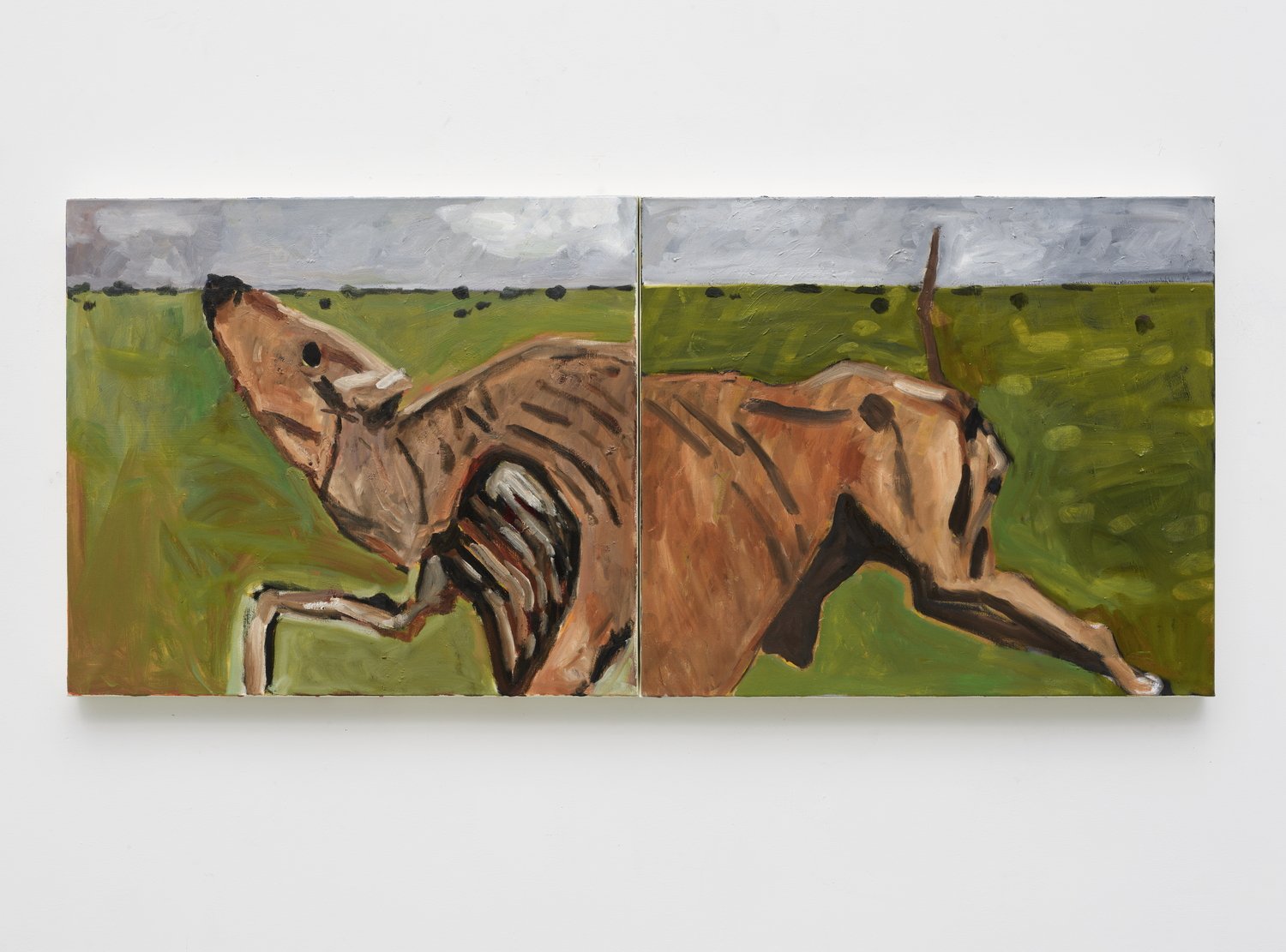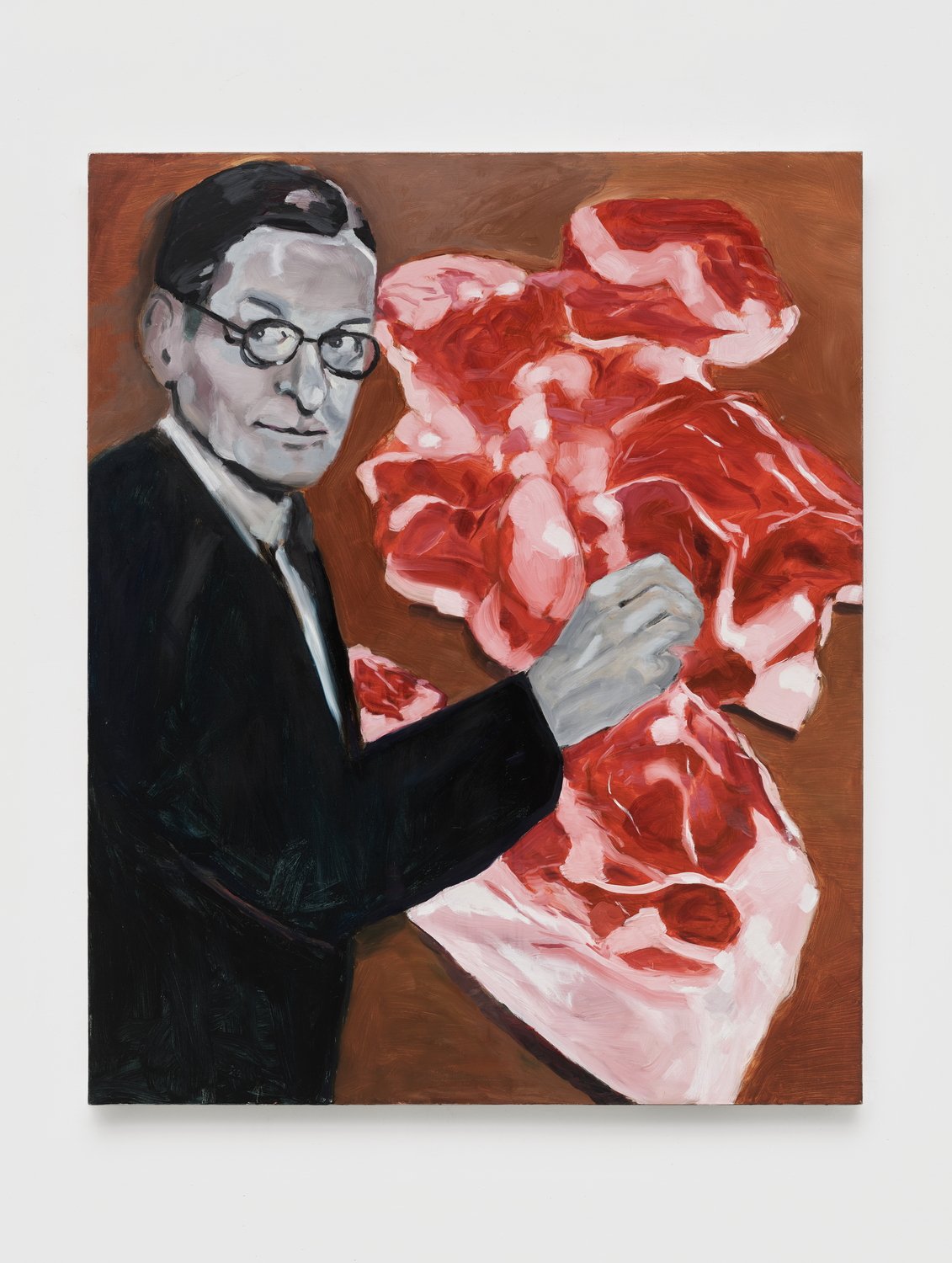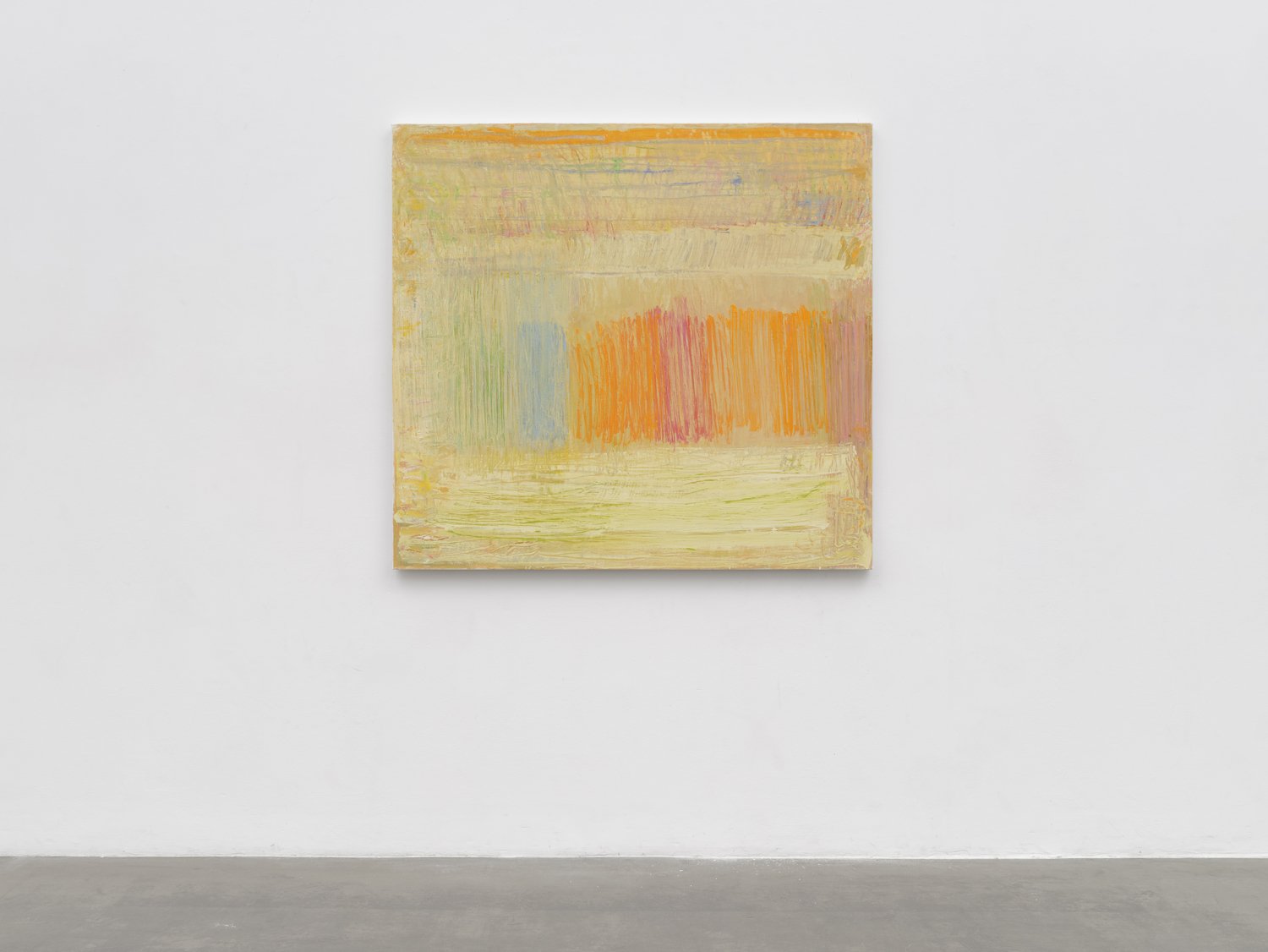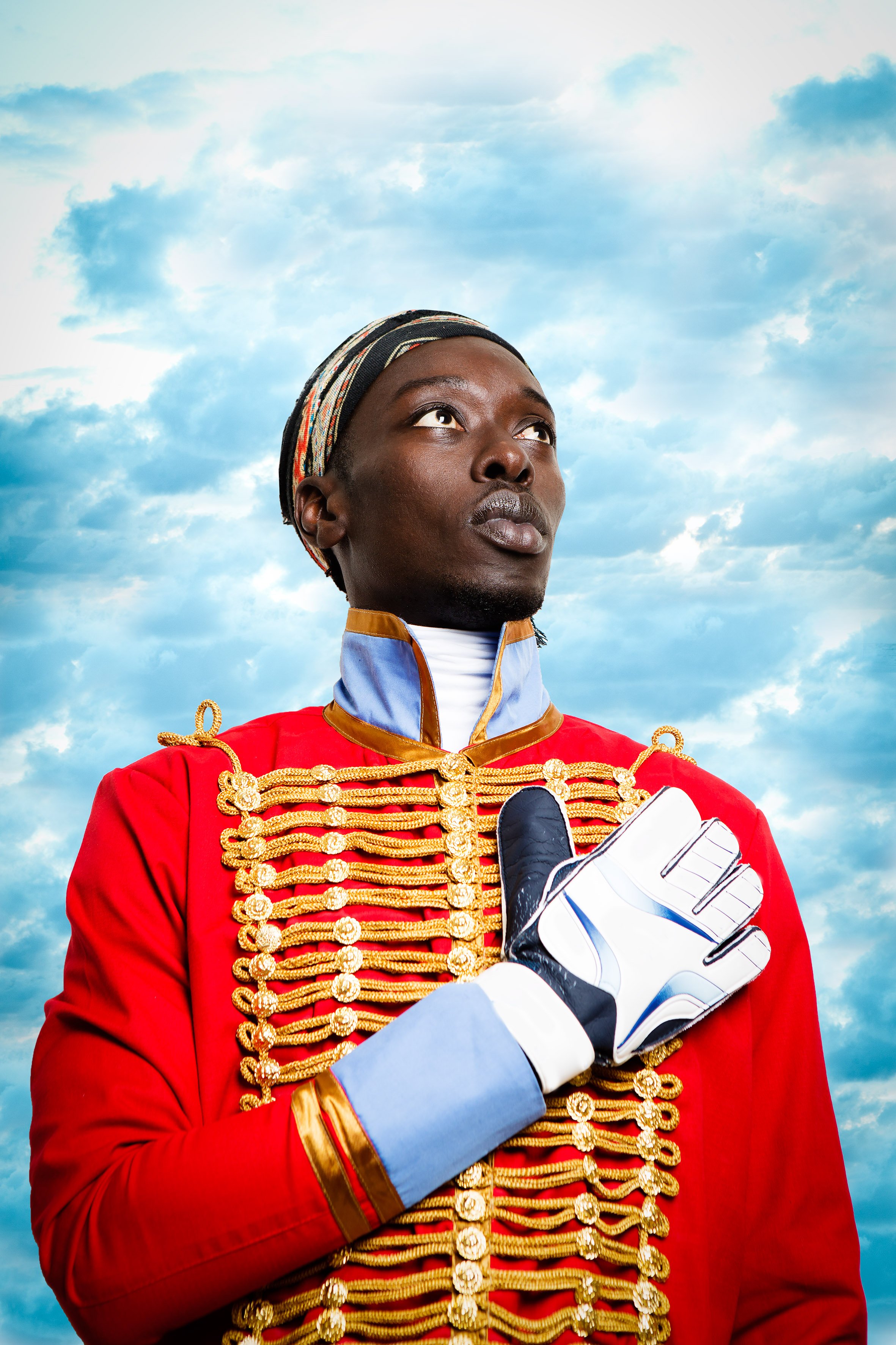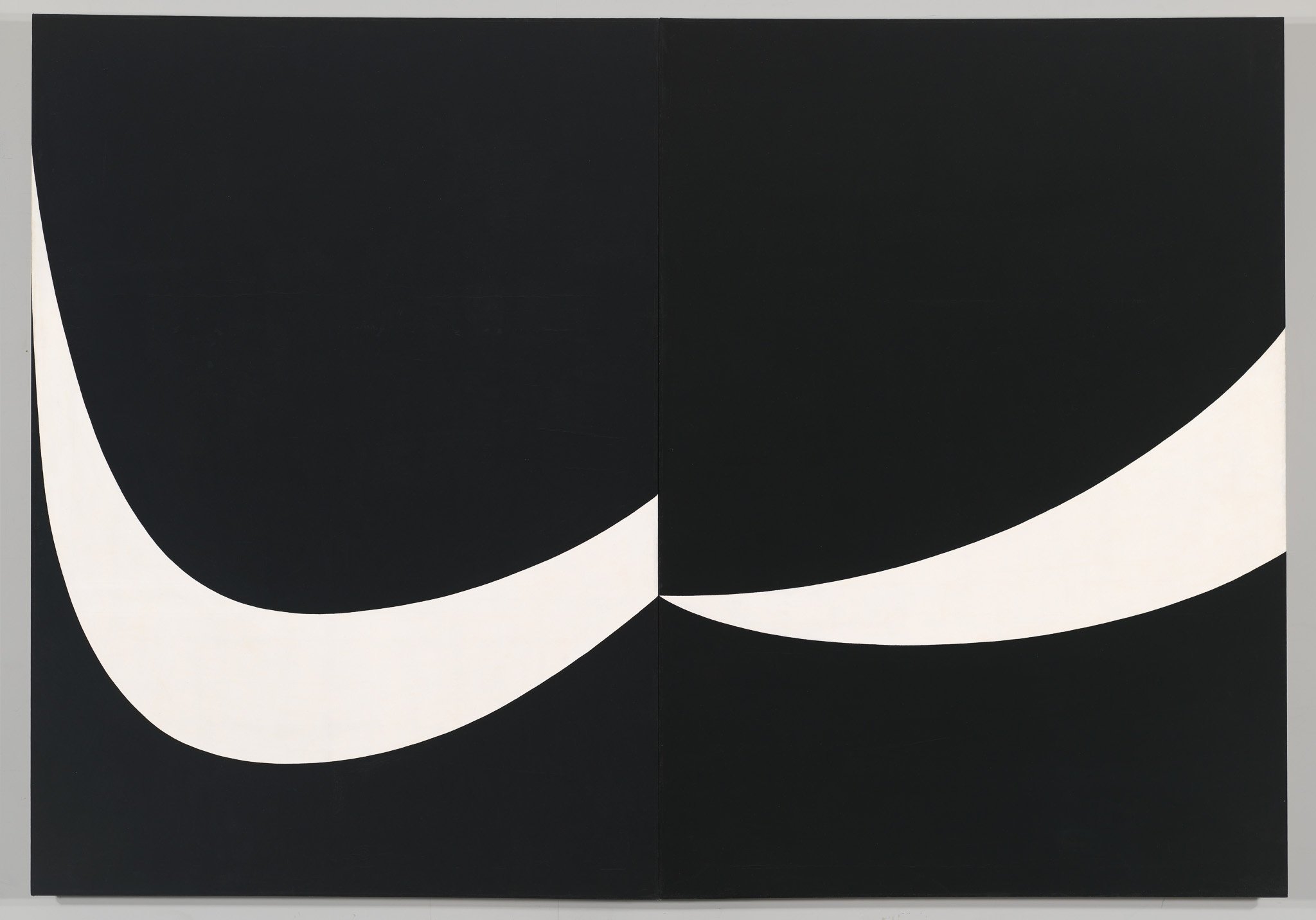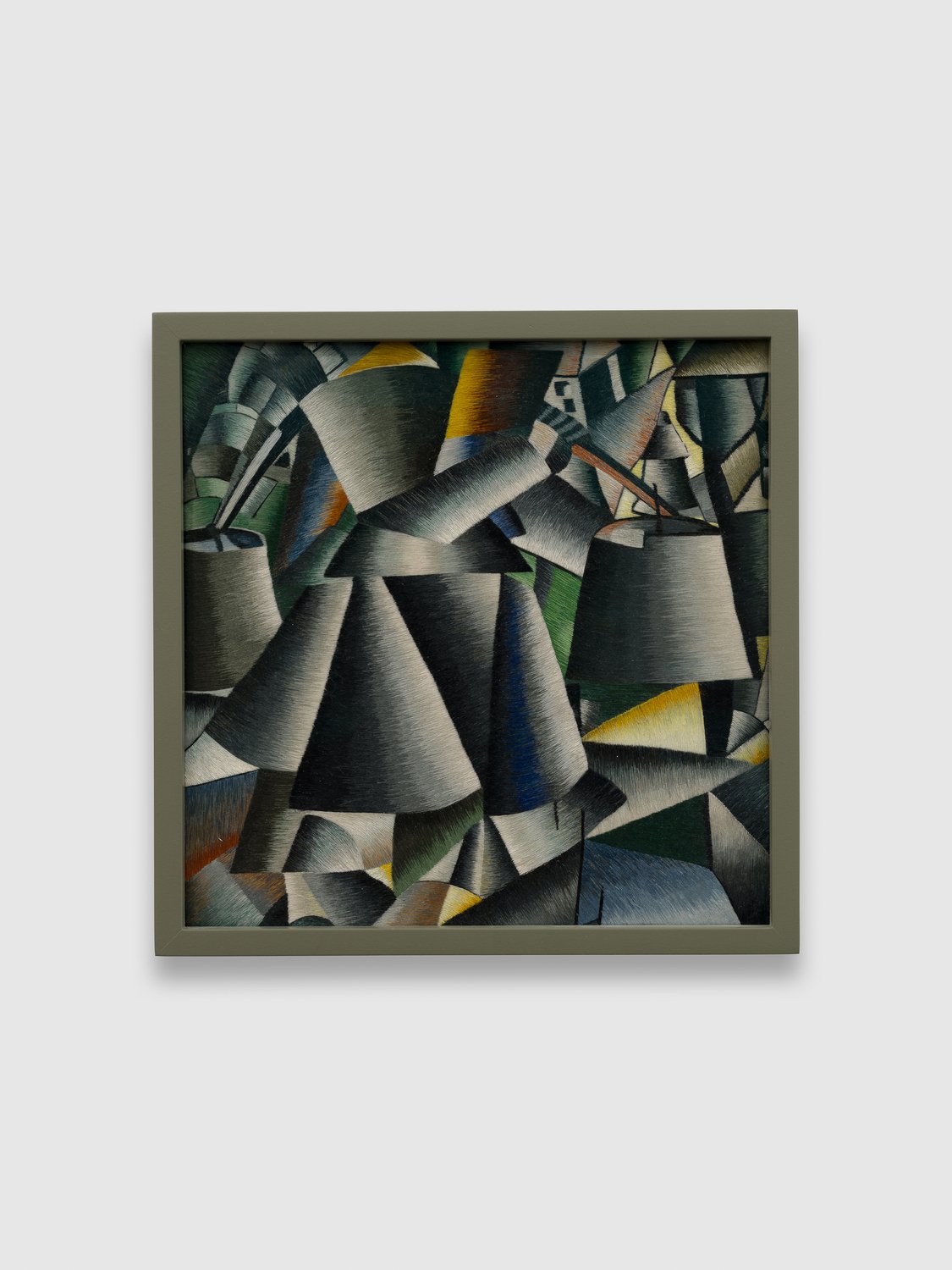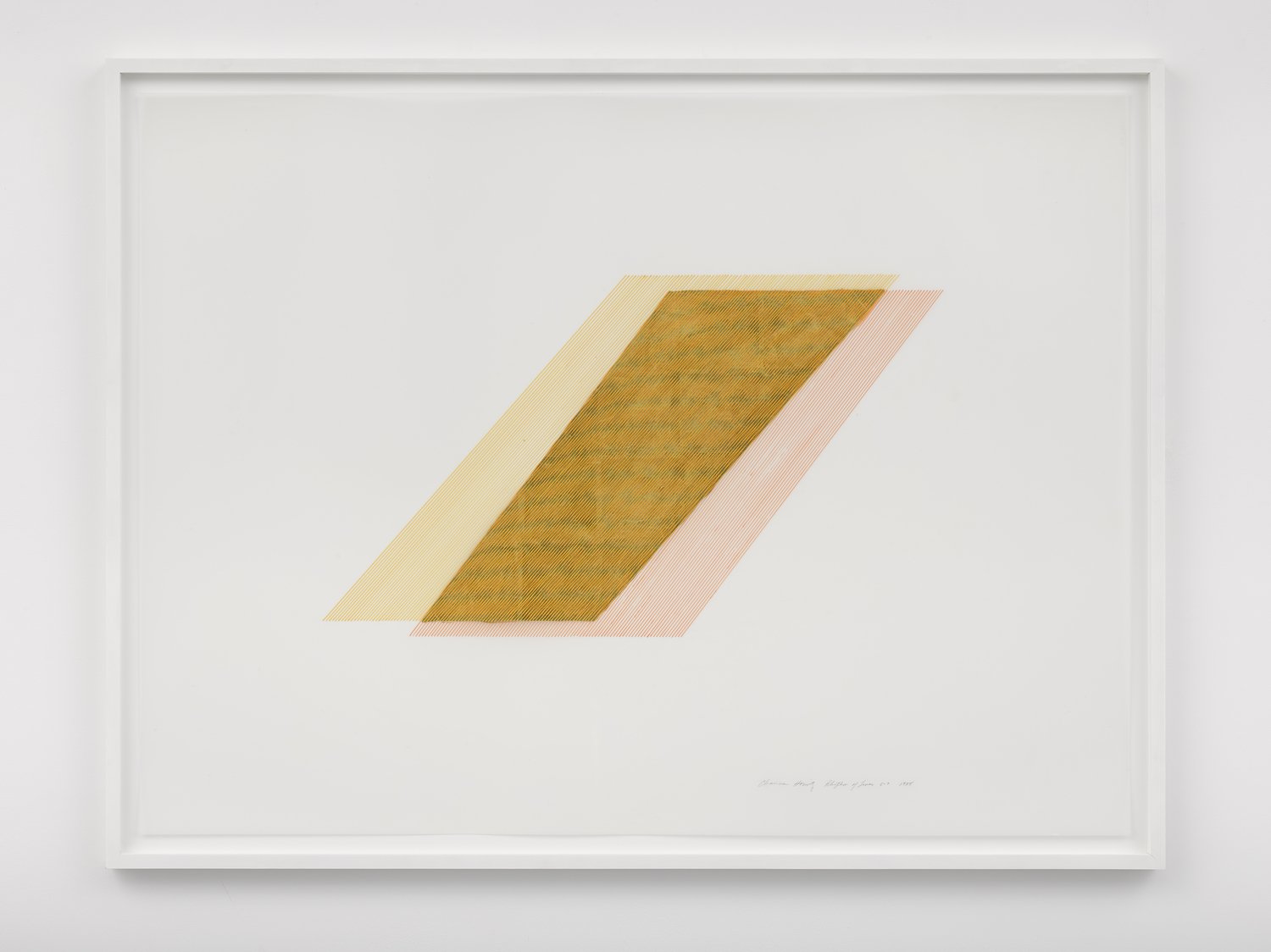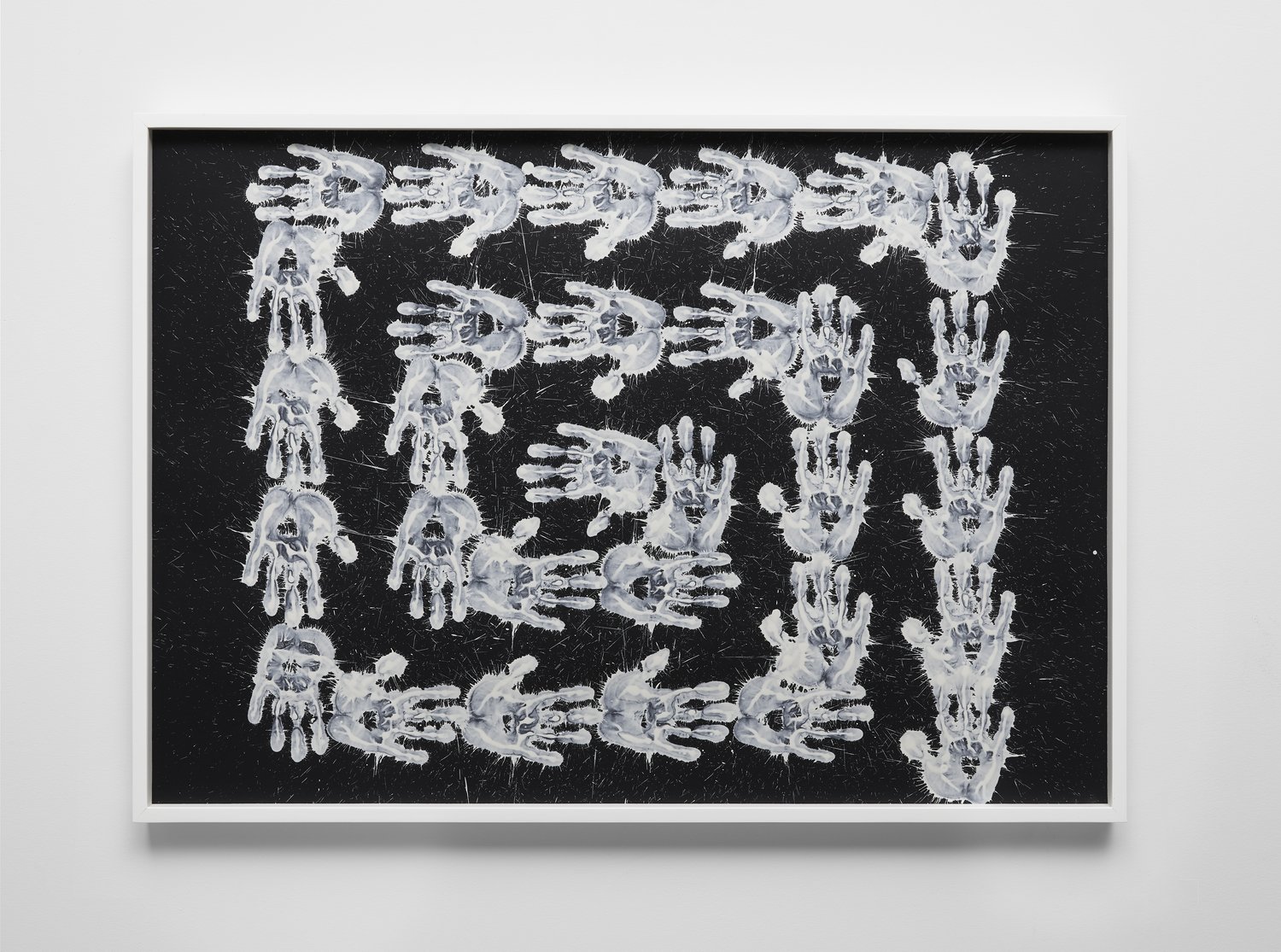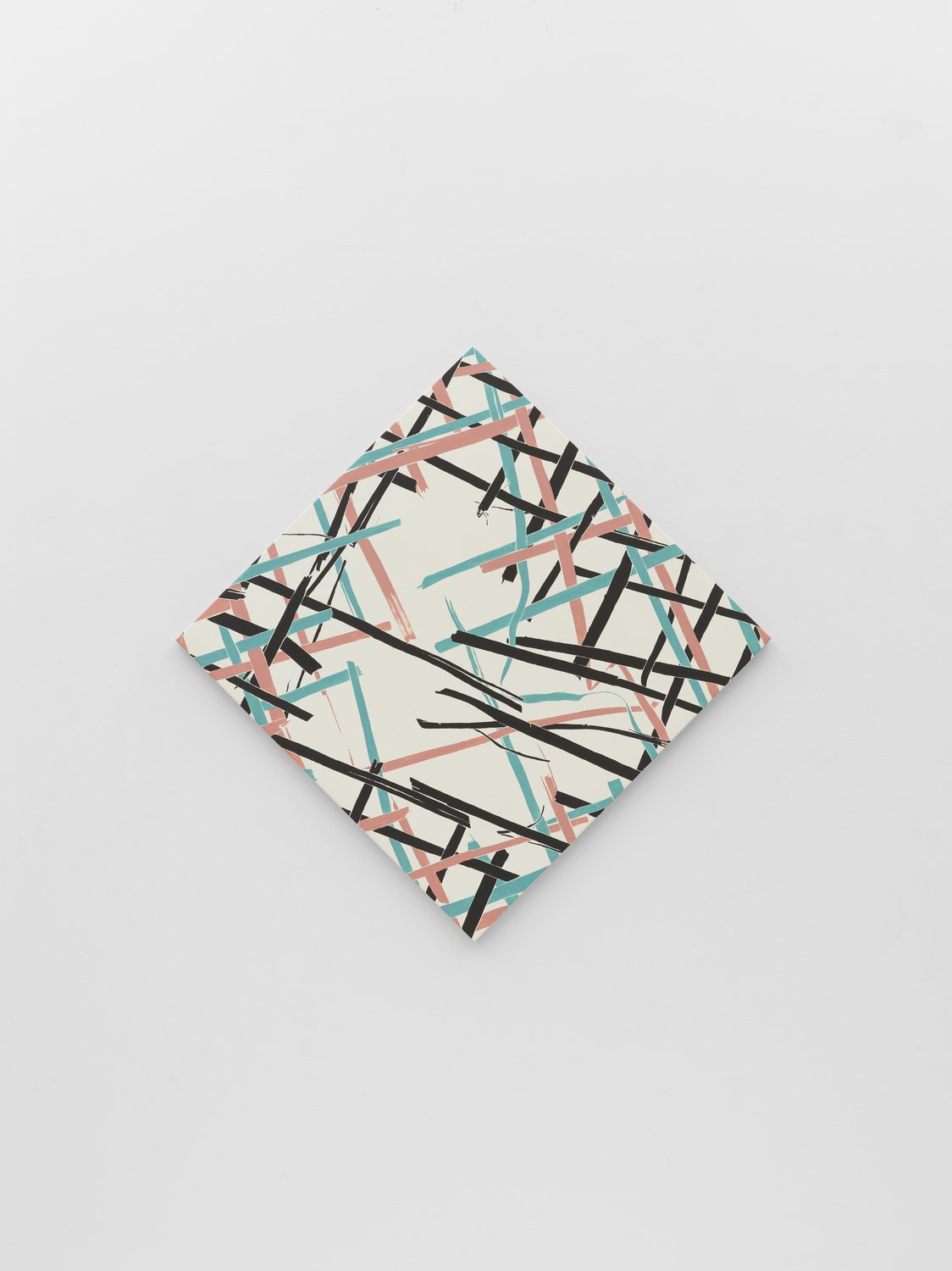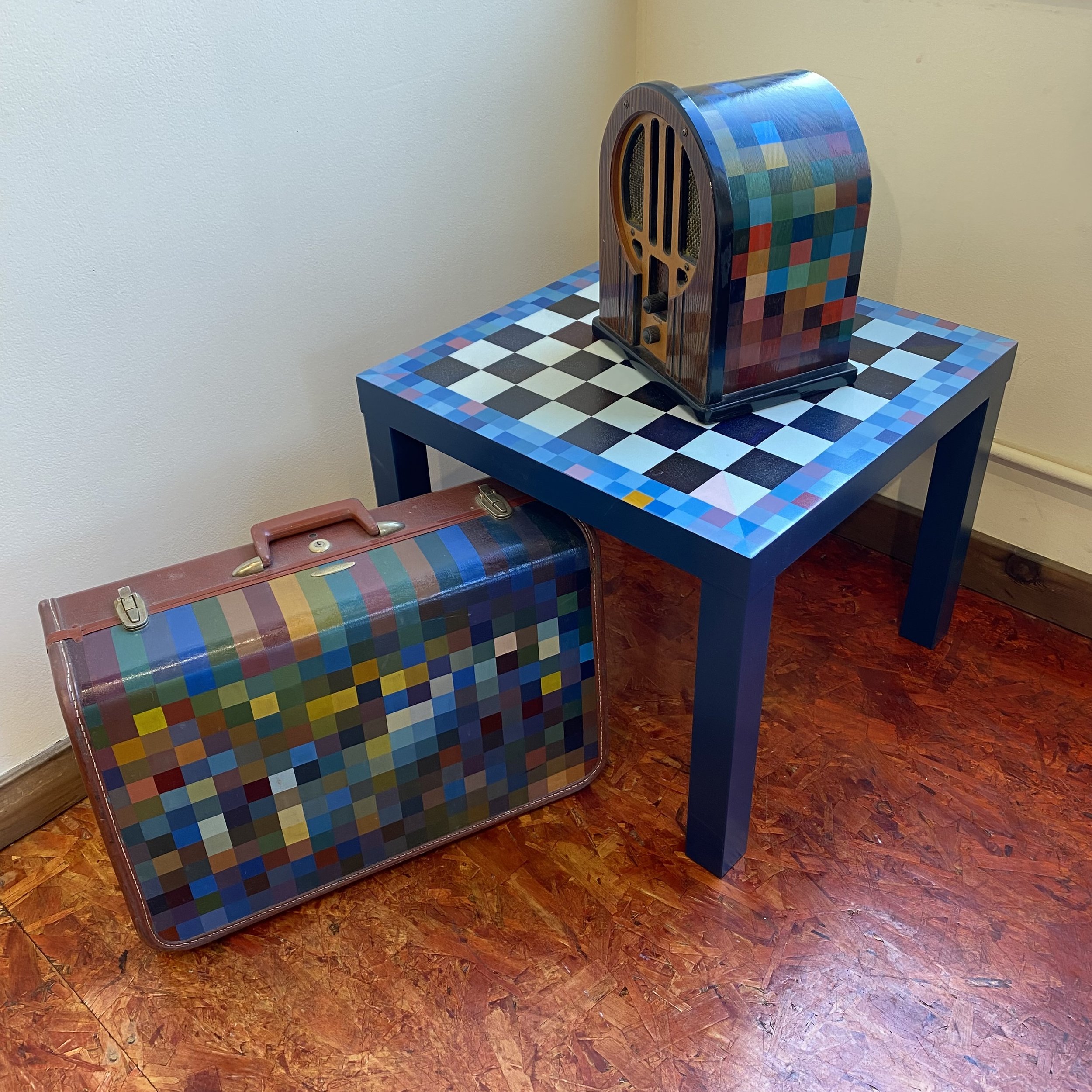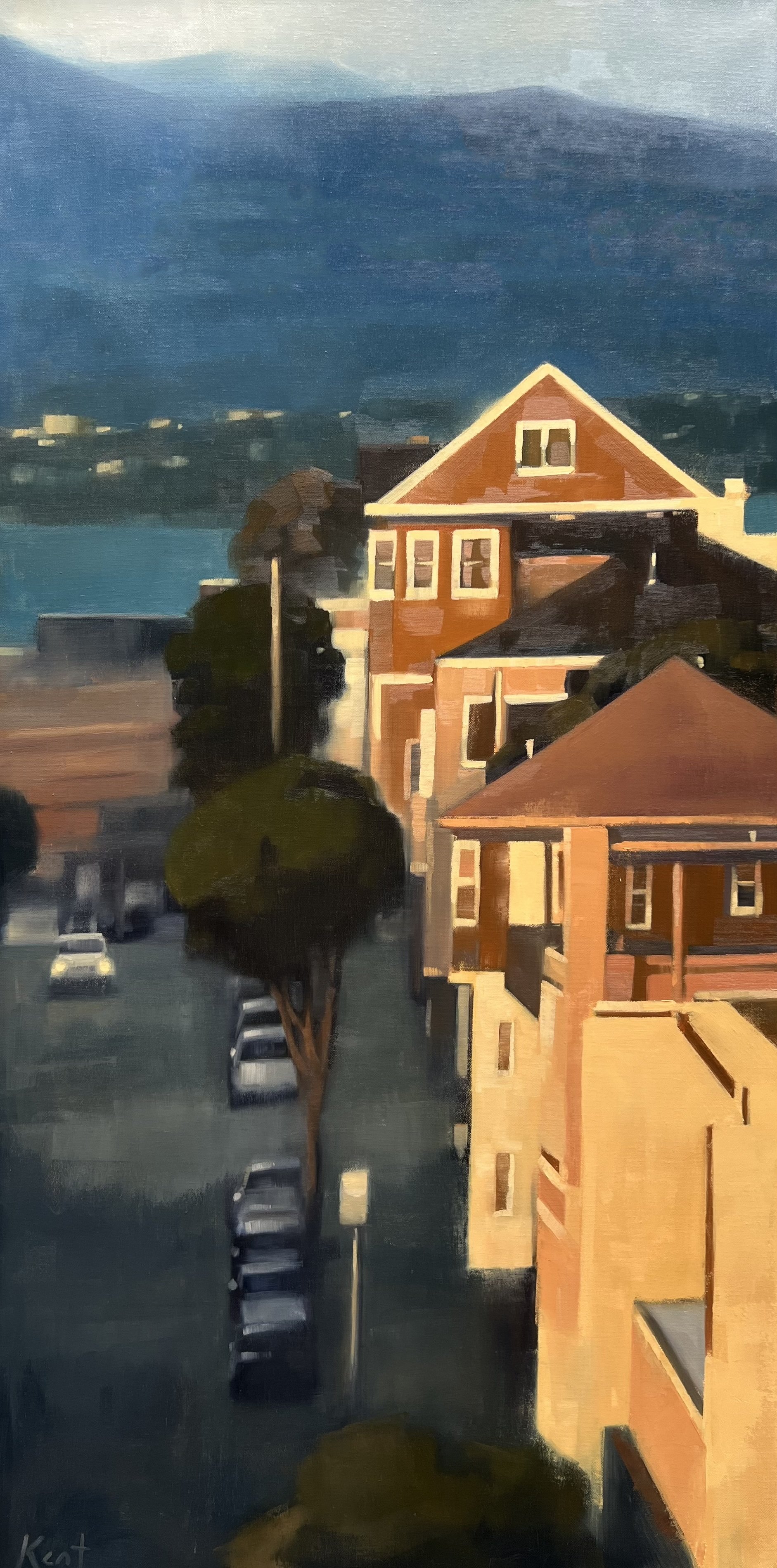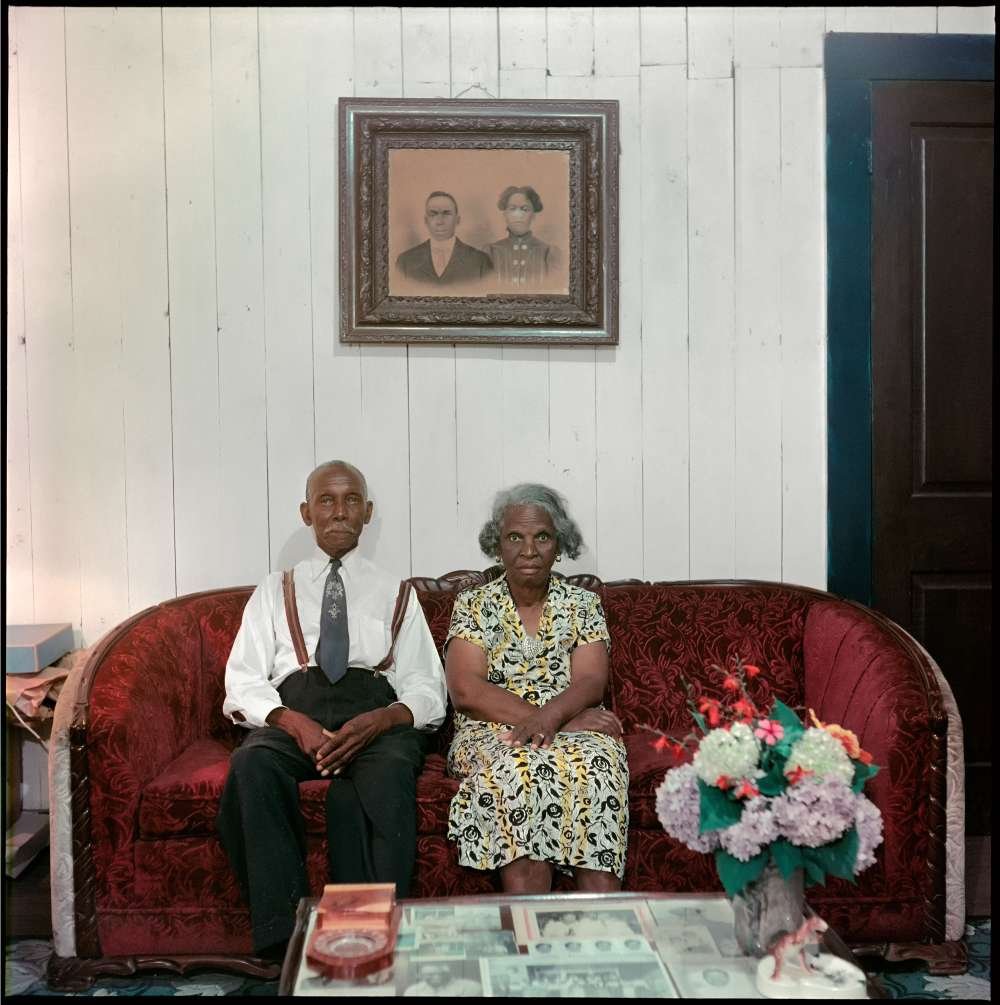Cj Hendry's Flower Market,






















Event Photo Credit: Antonio Ajam
New York, NY - Ralph Waldo Emerson once said, “Many eyes go through the meadow, but few see the flowers in it." Contemporary artist Cj Hendry not only sees the flowers, but has designed a greenhouse filled with 100,000 plush flowers as her meadow, and invites us to meander. There is no more perfect way to end the summer than visiting contemporary artist Cj Hendry’s upcoming collaboration with global luxury beauty brand Clé de Peau Beauté and in partnership with Four Freedoms Park Conservancy.
Known for creating art on a grand scale, Cj’s latest extraordinary exhibit, Flower Market, is no different and features a 120-foot by 40-foot greenhouse built on the lawn of the FDR Four Freedoms State Park on Roosevelt Island. The greenhouse will be filled with 100,000 meticulously crafted plush flowers inspired by the natural radiance and botanicals used in Clé de Peau Beauté products.
“When the architect Louis Kahn designed this memorial, he said, ‘The garden is somehow a personal kind of control of nature.’ A lot of my work, and in this exhibition especially, is about manipulating my environments and building a space that takes participants out of their ordinary. I hope Flower Market inspires joy and beauty well after the greenhouse is empty, every time we see flowers - plush or otherwise.”
One significant botanical that inspired Cj was the Radiant Lily found in Clé de Peau Beauté’s The Serum, an iconic skincare product beloved by Cj. “The meticulous craftsmanship in CPB’s products really resonates with me and mirrors my own process” says Cj. The plush Lilies will be on display, alongside Cj’s 12 original drawings created for this exhibition. Among the other flowers on display are a bouquet inspired by the Roosevelt family; the yellow Eleanor Roosevelt Rose, Tulips for the Roosevelt family's Dutch heritage, red Roses symbolizing the "Roosevelt" name (field of roses), and Peonies, the signature flower of the Roosevelt farm.








Cj Hendry Studios
“I wanted to capture the organic beauty and clean elegance of the Radiant Lily. The simple lines and pure white petals are evocative of my practice in general and really became an entry point for me… Franklin D Roosevelt Four Freedoms Park, in my opinion, is an architectural marvel. The fact that it's between Brooklyn and Manhattan on its own island within New York, I just love it. It is an incredible privilege we’ve been granted, I'm so grateful they're on board with me as an artist and Clé de Peau Beauté as a brand.” - Cj Hendry
Cj Hendry Studios
“I am thrilled to share this collaboration between Clé de Peau Beauté and Cj Hendry,” says Alessio Rossi, Executive Vice President Clé de Peau Beauté US Marketing.“This partnership embodies the essence of our brand, known for its intelligence, uncompromising standards, and exquisite quality. Cj Hendry’s remarkable ability to engage audiences through her masterful craftsmanship and thought-provoking social commentary on luxury perfectly resonates with our values.”






















Event Photo Credit: Antonio Ajam
Exhibit Details:
September 13-15
10am - 4pm
1 Franklin D. Roosevelt Four Freedoms State Park
Roosevelt Island, NY
Ceramides
“CEO of Four Freedoms Park Conservancy, Howard Axel, adds,”We were immediately excited to work with such an exceptional contemporary artist as Cj Hendry and help share her magical work with tens of thousands of visitors. She captures the vision of Louis Kahn and his design ‘to be a place of inspired use’ as she encourages visitors to see the park through her eyes!”
Cj Hendry Studios
About Cj Hendry:
Cj Hendry (b. 1988) is a New York-based artist originally from Brisbane, Australia. Hendry transforms her fascination with contemporary material culture into large-scale, hyper-photorealistic drawings. Cj Hendry’s exhibits are intended to be actively experienced through the engaging, and thought-provoking environments she constructs. For her 2023 exhibition Epilogue, guests were welcomed into a reimagined 1830s Georgian church that was blanketed in falling white petals for ten straight days. At Public Pool (2024), visitors traveled hours into the Las Vegas desert to dip into a temporary Olympic-sized swimming pool, complete with lounge chairs and pool floaties. Each Cj Hendry exhibit, from Miami to Melbourne, draws massive crowds, with attendees sometimes waiting in line for several hours to experience the magic within. Celebrity clientele and avid private collectors mean Hendry’s waitlist is now well over 3,000 collectors deep, with a wait time of up to five years to get their hands on a piece. @CJ_Hendry
About Clé de Peau Beauté:
Clé de Peau Beauté, the global luxury brand from Shiseido Co., Ltd., was founded in 1982 as the ultimate expression of elegance and science. Clé de Peau Beauté means the key to skin’s beauty. The philosophy of the brand is to unlock radiance by harnessing makeup technologies and advanced skincare from around the world. Forever guided by an exquisite aesthetic sensibility and intelligence, Clé de Peau Beauté has instilled its products with modernity, enchantment, and dynamism to emerge as an industry leader in delivering radiance so remarkable, as if it emanates from within. Available in 26 countries and regions worldwide*. @CledePeauBeauteUS
About Four Freedoms Park Conservancy:
Four Freedoms Park Conservancy (FFPC), founded in 2011, operates under a Friends Agreement with New York State Parks to produce and curate public programs at Franklin D. Roosevelt Four Freedoms State Park. The park, designed by the groundbreaking American modernist architect Louis Kahn, is among the most significant architectural masterpieces in New York City. By leveraging this spectacular architecture and the unique location of the park, FFPC strives to produce events, installations and public art and works with nonprofit partners that can ignite conversations about the Four Freedoms and the legacy of President Franklin D. Roosevelt. @4FreedomsPark
About New York State Parks, Recreation and Historic Preservation:
The New York State Office of Parks, Recreation, and Historic Preservation oversees more than 250 parks, historic sites, recreational trails, golf courses, boat launches, and more, which saw a record 84 million visits in 2023. For more information on any of these recreation areas, visit here and download the free NY State Parks Explorer app or call 518.474.0456. Join us in celebrating our Centennial throughout 2024, and connect with us on Facebook, Instagram, X (formerly Twitter), YouTube, Flickr, and the OPRHP Blog.@NYStateParks
Free Ticket Registration here.
Visitors are invited to explore the vibrant field of flowers and take one home with them. Those who cannot experience Flower Market in person can explore a virtual flower market and personalize their own plush white Lily inspired by the Radiant Lily.
For more information about Cj’s art please visit her site here and on Instagram.
Carrie Moyer: Timber!
Mommy Long Legs, 2024 Signed, titled, and dated on verso Acrylic, pumice, and fiber paste on canvas 40 x 28 in (101.6 x 71.1 cm) Courtesy of the artist and Alexander Gray Associates, New York © 2024 Carrie Moyer
Alexander Gray Associates, New York presents Carrie Moyer: Timber!, the artist’s first solo exhibition with the Gallery. Moyer’s new abstract paintings and works on paper speak to the sensations provoked by social and environmental instability. The show’s title, Moyer writes, “is a warning best imagined in a comic strip. It brings awareness to one’s surroundings. Waiting for something to fall, the other shoe to drop.”
Throughout her career, Moyer has deployed abstraction as a vehicle for queer expression and politics. As she attests, “The main impetus for my work is always what can I do with this material, acrylic paint, and what can it suggest (poetically, conceptually, materially, physically, etc.)?” In her recent paintings, movement, gravity, and stasis are investigated anew through an expanded repertoire of materials that radically alter the surface of the canvas as well as the flow of poured paint. Inspired by the magnitude of geological processes, atmospheric currents, and planetary orbits, Moyer explains, “I am thinking about very large forces, and how they might show up in a painting.” The artist’s recent canvases such as Tears on My Pillow (2024) incorporate pumice, an extrusive volcanic rock. Other compositions like Etna’s Folly (2024) integrate powdered minerals derived from semi-precious stones, metal, and graphite. Using these shimmering natural substances, Moyer invokes associations between painting and alchemy. In doing so, she complicates an art historical lineage stretching back to prehistoric cave painting by adopting materials linked to extractive industries.
Moyer’s canvases and collages present physical and social transformation as a process that occurs across multiple strata of perception. “I want to make surfaces that are expansive, that operate both microscopically and macroscopically,” she states. Her carefully layered compositions juxtapose vivid, fluid drips and luminous expanses of pigment with fixed contours and matte grounds. Works such as Crying – Waiting – Hoping (2024), with its undulations of fiber paste, echo both anatomical curves and molten flows, while compositions like Pyroplastica (2024) interlock bodily and natural phenomena in moments of uncanny sensual contact. Emphasizing the sensorial, the artist employs techniques drawn from the legacy of post-war abstraction—drawing, pouring, staining, rolling, sprinkling, and mopping—while integrating strategies of graphic design. Meanwhile, the quick-witted titles of these works point toward, per Moyer, “the myriad problems we face as humans, as nations, as a planet … and yet we go on. There’s something funny about it.”



















Installation view: Carrie Moyer: Timber!, Alexander Gray Associates, New York, 2024. Courtesy Alexander Gray Associates, New York. Photo: Dan Bradica
Moyer’s paintings and drawings expand traditional notions of abstraction by imbuing associations between process, form, and content with her feminist socio-political perspective. The artist’s recent works speak to, in her words, “both the pleasure and precarity of the moment.”
Moyer’s work has been the subject of numerous solo and two-person presentations, including Carrie Moyer and Sheila Pepe: Tabernacles for Trying Times, Portland Museum of Art, ME (2020), traveled to Museum of Arts and Design, New York (2021); Carrie Moyer: Pirate Jenny, The Frances Young Tang Teaching Museum and Art Gallery, Skidmore College, Saratoga Springs, NY (2013), traveled to Canzani Center Gallery, Columbus College of Art and Design, OH (2014), and SCAD Museum of Art, Savannah, GA (2014); and Carrie Moyer: Interstellar, Worcester Art Museum, MA (2012), among others. Moyer has participated in many group exhibitions, including Making Their Mark, Shah Garg Foundation, New York, NY (2023), traveling to Berkeley Art Museum and Pacific Film Archive, CA (forthcoming 2024); Whitney Biennial 2017, Whitney Museum of American Art, New York (2017); Agitprop!, Brooklyn Museum, New York (2015), and others. The artist’s works are represented in public collections, including Birmingham Museum of Art, AL; The Frances Young Tang Teaching Museum and Art Gallery at Skidmore College, Saratoga, NY; The Metropolitan Museum of Art, New York; Rose Art Museum, Brandeis University, Waltham, MA; and Whitney Museum of American Art, New York, among others. She is the recipient of numerous awards and fellowships, including National Academician, National Academy of Design (2019); Guggenheim Fellowship (2013); Anonymous Was A Woman (2009), and others. Moyer is a Professor and the Co-Director of the graduate studio program at Hunter College in New York. She is also on the Board of Governors at Skowhegan School of Painting and Sculpture in Maine.
The exhibition will open on the 12th of September and close on the 26th of October 2024.
For more information about this exhibition and others at Alexander Gray Associates, please visit their website here. They also can be found on Instagram here.
Zhao Gang : Carnivore
Zhao Gang赵刚 Diamond Beach 2 钻石海岸2 2023 Oil on canvas 布面油画 2 parts. Overall/双联;整体: 70 x 160 x 4.5 cm, 27 1/2 x 63 x 1 3/4 in © Zhao Gang. Courtesy Lisson Gallery
For his first solo exhibition with Lisson Gallery, Zhao Gang presents ‘Carnivore’ , featuring a series of new paintings that represent the artist's exploration of the interweaving psychology, emotions, and lifestyles across history and the present. These works delve into the distorted and obscured perceptions and experiences resulting from such interactions, probing the fluidity of individual identity amidst cultural conflicts and historical ruptures.
One of the highlights of the exhibition is T. S. Eliot (2024), through which Zhao investigates the American- English poet for first time in his practice. Zhao came across a biography of Eliot from a used bookstore in London, and read it on his flight to New York. The tense relationship between Eliot and his first wife, Vivienne Haigh-Wood, resulted in an extremely difficult marriage, bedeviled by nervous and physical illness on both sides. Eliot’s “elite, super-controlled, white male personality” and the way it tribulated his personal life sparked the
artist's philosophical contemplation on love and intimacy between individuals. In the suite of paintings presented in Beijing, Zhao uses raw pork and lamb legs as primary motifs that symbolically allude to the human form, thereby challenging the audience's preconceived notions through techniques of deconstructivism reminiscent of the 1980s. Adjacent to slabs of meat, portraits of Eliot and Haigh-Wood are rendered deathly pale, mirroring their dissonant union.
Zhao Gang 赵刚 T. S. Eliot T.S. 艾略特 2024 Oil on canvas 布面油画 160 x 130 cm 63 x 51 1/8 in © Zhao Gang. Courtesy Lisson Gallery
Still life remains a recurring motif in Zhao Gang's practice. Sequels to his thematic exploration of still life florals and mounds of meat during the pandemic, select works in this exhibition feature various kinds of meat, vegetables, wine glasses, and flowers arranged in domestic settings.
Zhao Gang 赵刚 Camellia 山茶花 2023 Oil on canvas 布面油画 200 x 260 cm 78 3/4 x 102 3/8 in © Zhao Gang. Courtesy Lisson Gallery
These juxtapositions manifest Zhao’s displaced sensibilities amidst his tumultuous emotional landscape. Having recently relocated to a new studio after years of living abroad, Zhao Gang finds solace in solitary contemplation and reveries in between his creative pursuits; with each relocation, he grows increasingly mindful and appreciative of his surroundings. With a disruptive impulse, as seen in Camellia (2023), the artist manipulates the scale and perspective of the cut of meat and flowers within the pictorial plane, elevating the viewers from reality through a super-magnified lens, prompting introspection on one’s own existential fate within this phenomenological experience.
Representation of food also appears in a series of small paintings rendered in circular, oval, and lozenge forms. These compositions feature raw meat-cuts, cooked and uncooked fish, as well as partially consumed fruits and vegetables. In traditional Chinese culture, the image of bountiful food symbolises aspirations for a prosperous life, where chicken, duck, fish, and pork are the four main dishes prevalent among banquets and feasts. These works reflect the artist's enduring yearning for a stabile and reclusive life, after years spent drifting overseas.
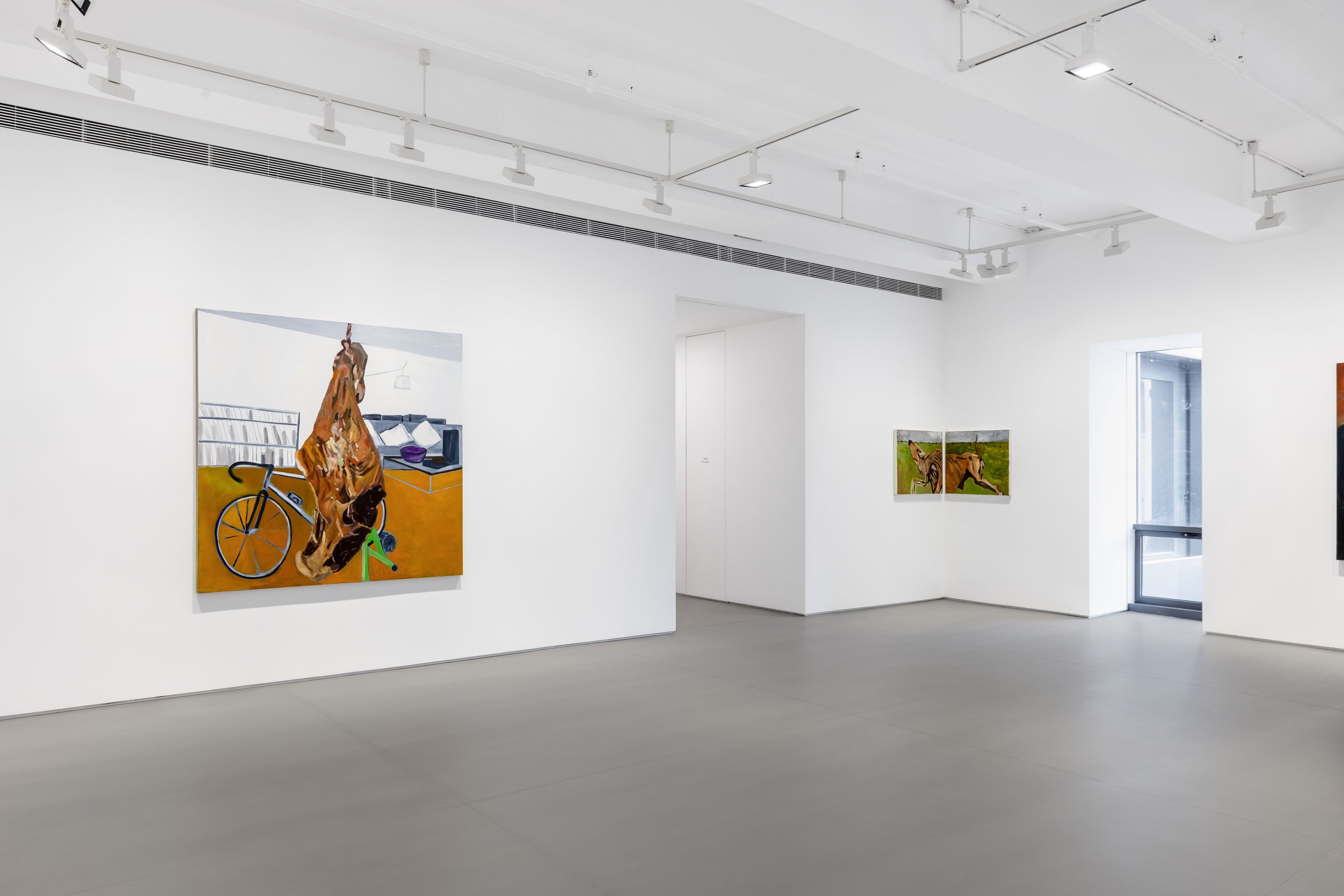
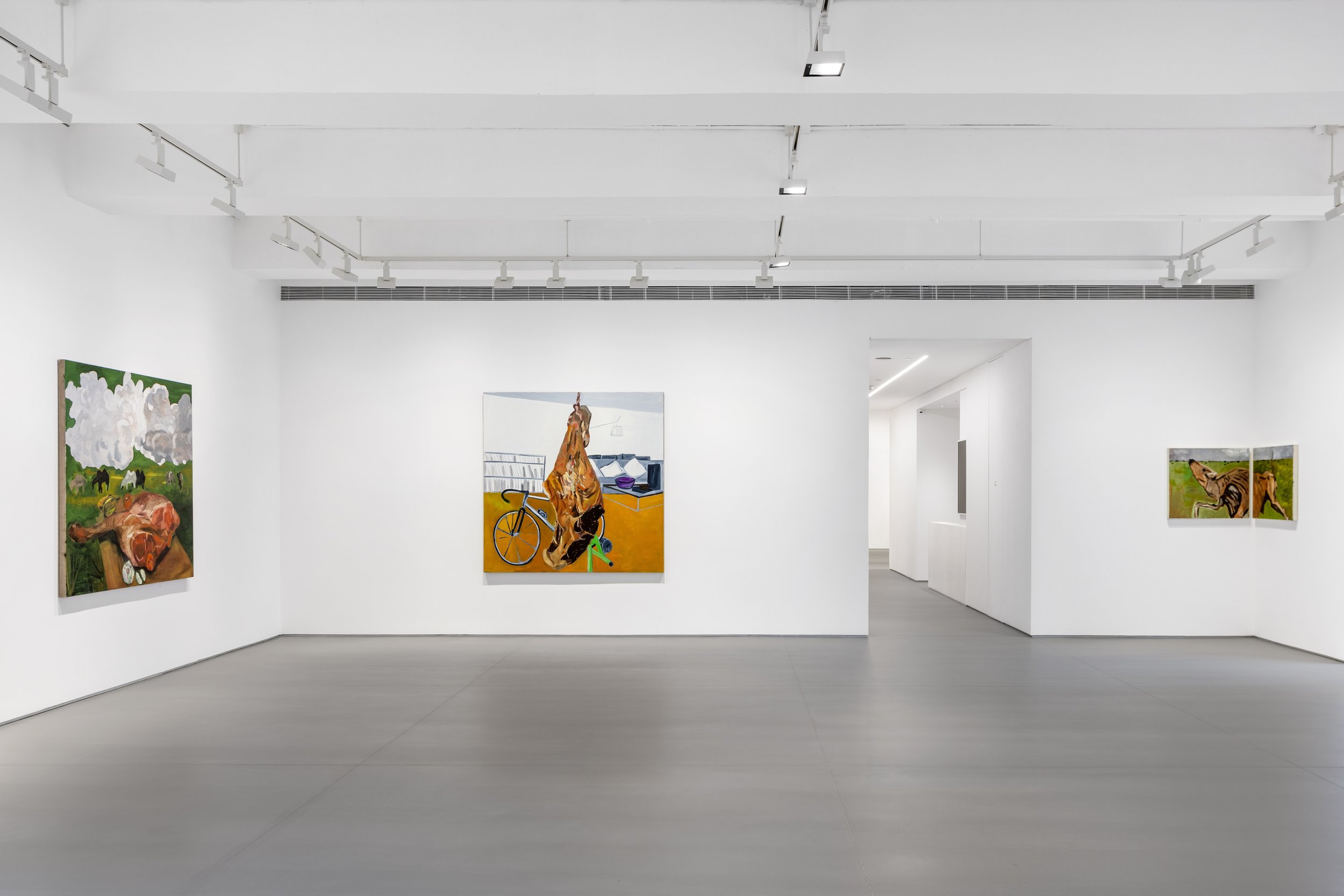
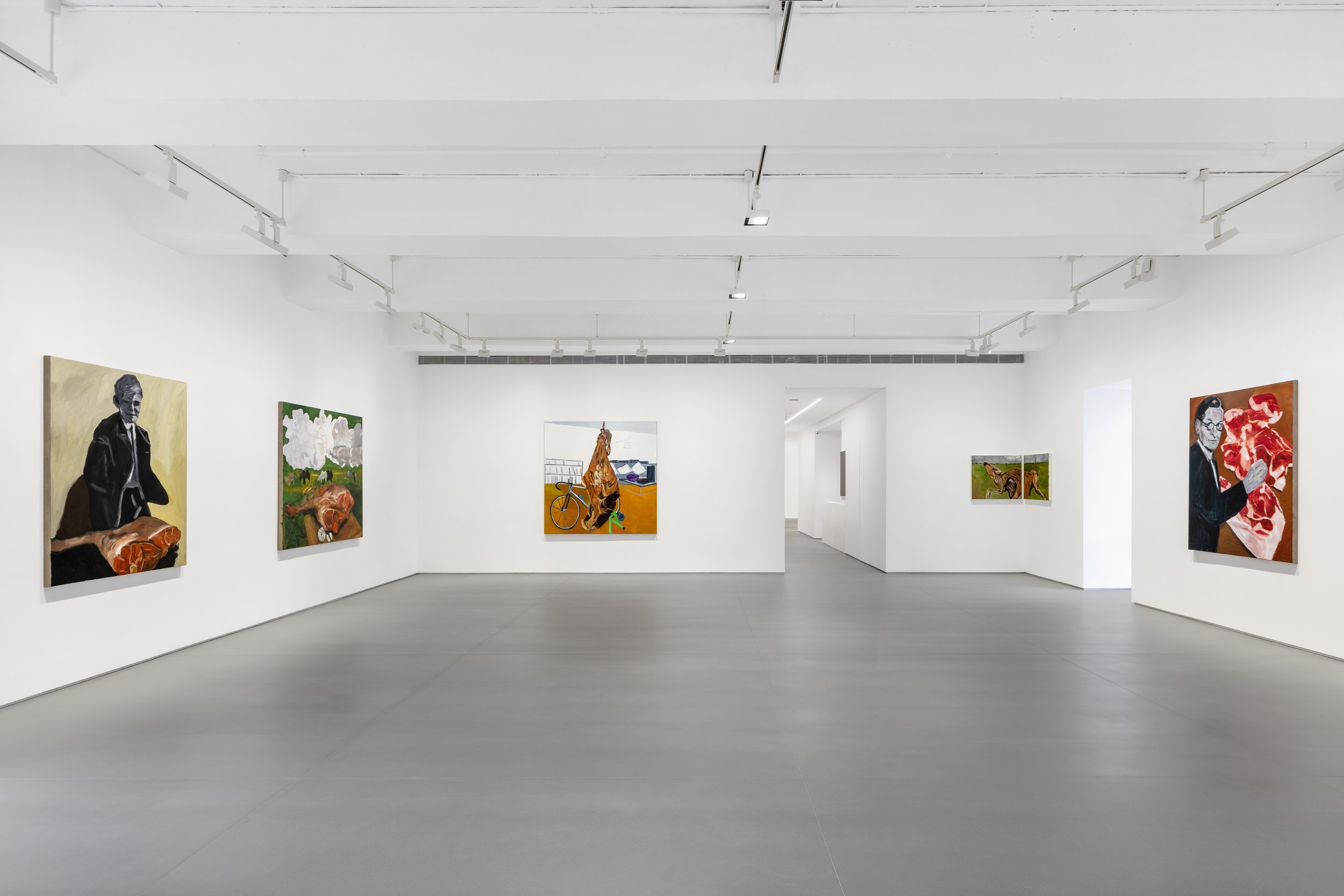

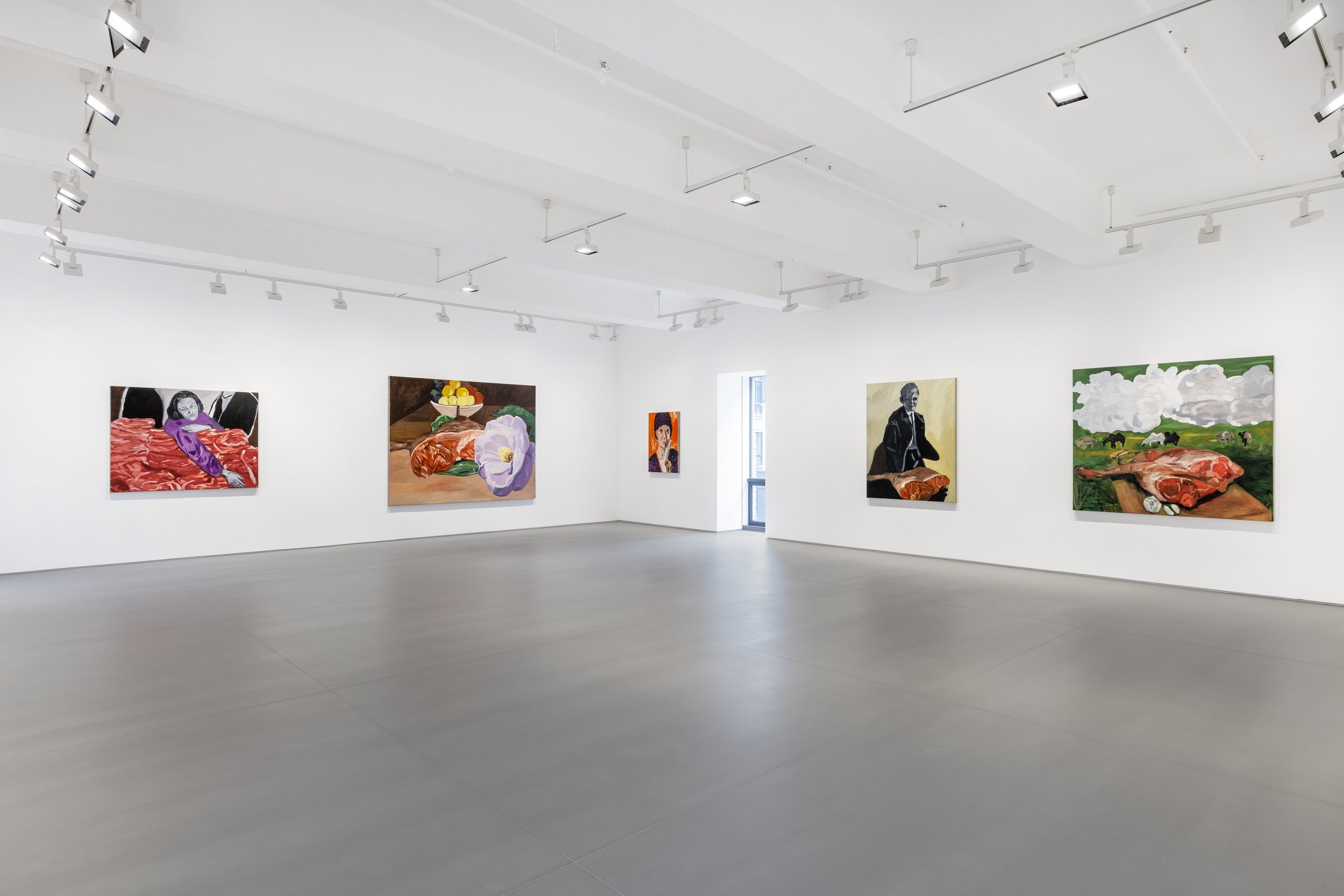
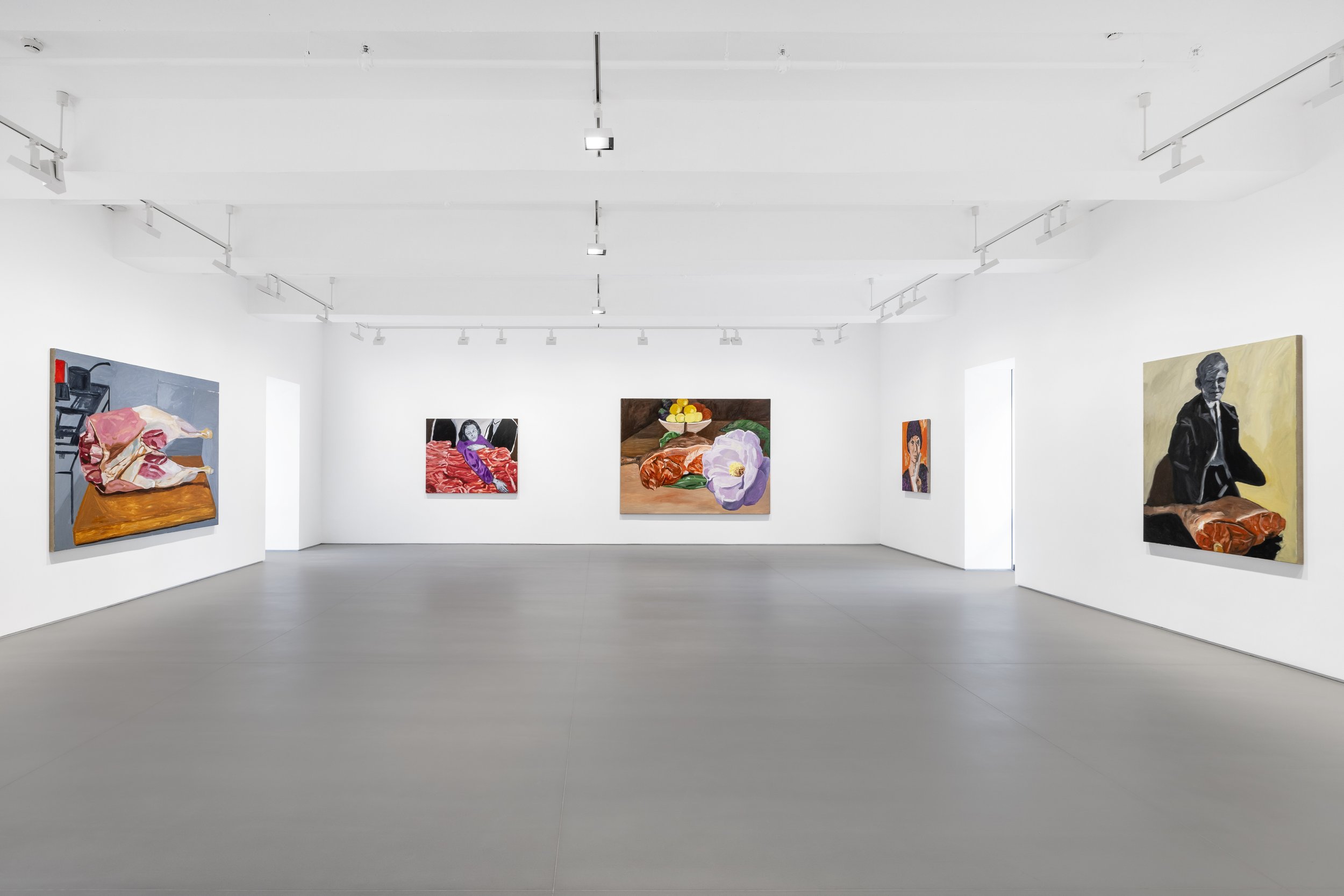

Installation view of Zhao Gang: Carnivore, Lisson Gallery, Beijing, 18 May – Autumn 2024 © Zhao Gang. Courtesy Lisson Gallery. Photography by Yang Hao 赵刚个展「肉食者」现场图,里森画廊,北京,2024年5月18日至2024年秋季 © 赵刚。图片由里森画廊提供,由杨灏拍摄
This series also portrays large animal carcasses exposed in the outdoors. The depicted grasslands and mutton are symbols of a nomadic lifestyle, echoing Zhao’s past experiences living in places scattered across the globe, intertwined with his pursuit of inner peace by traversing the prairies on motorcycle. Zhao Gang once said, "I believe the most important thing in life is, regardless of your status, you always have the ability to let go, and pick up where you left off at any given moment." With his intellectual preoccupation seeping through the canvas, Zhao reflects on what his diasporic identity means in the present, while elucidating the significance of those seemingly mundane yet deeply treasured aspects of his daily life.
About the artist
Zhao Gang delves into the fluidity of individual identities, the clash of cultures, and the intricate interplay of fragmented historical events. His works are deeply rooted in a rich and nuanced cultural heritage, drawing inspiration from both classical and contemporary, Western and Chinese influences. Within his work, patterns and concepts gracefully unfurl, expertly deconstructing visual narratives. At the age of 18, Zhao Gang became the youngest member to join the avant-garde artist group known as the ‘Star Group’, heralding the onset of the
modern art movement in China. Driven by a pursuit of artistic and political freedom, they laid the foundational stones of contemporary Chinese art. Zhao Gang’s artistic style is characterized by audacious and almost exaggerated narrative techniques and brushwork. These elements serve not only as a perpetual reaffirmation of his own existence but also as a defiant stance against the prevailing trend of artistic refinement. His works celebrate the unfettered freedom and authenticity inherent in painting. His experience of studying abroad and living overseas since 1983 has given his works a diverse style with distinctive international characteristics. Upon returning to Beijing in around 2006, Zhao Gang redirected his focus to the intricate interplay between his unique cross-cultural experiences and the annals of Chinese history. Born in this land, yet traversing the path of a new immigrant, he grapples with the sentiment of estrangement that threads through his art.
Born in Beijing in 1961, Zhao Gang currently works and lives in New York and Beijing. He attended the Maastricht Institute of Arts (formerly Stadsacademie voor Toegepaste Kunsten) in The Netherlands (1983), and Vassar College, New York (1984-1987). He obtained a Master of Arts degree from Bard College, New York in 1999. Zhao Gang has held solo exhibitions at various institutions, including the Long Museum (Chongqing Branch), Chongqing, China (2022); Long Museum (West Bund Branch), Shanghai, China (2021); Kuandu Museum of Fine Arts, Taipei (2020); Pérez Art Museum, Miami, FL, USA (2019); Museum of Contemporary Art, Santiago, Chile (2016); Ullens Center for Contemporary Art, Beijing, China (2015); Suzhou Museum, Suzhou, China (2015); Today Art Museum, Beijing, China (2011); Hong Kong Arts Centre, Hong Kong, China (2008); and He Xiangning Art Museum, Shenzhen, China (2006), among others. His works have also been featured in numerous group exhibitions, including the Solomon R. Guggenheim Museum, New York, NY, USA (2017); Beijing Minsheng Art Museum, Beijing, China (2015); OCAT Contemporary Art Terminal (Xi'an Branch), Xi'an, China (2014); Guangzhou Triennial, China (2008); Performa Biennial, New York, NY, USA (2007); and Yokohama Triennale, Japan (2005).
About Lisson Gallery
Lisson Gallery is one of the most influential and longest-running international contemporary art galleries in the world. Today the gallery supports and promotes the work of more than 60 international artists across spaces in London, New York, Los Angeles, Shanghai and Beijing. Established in 1967 by Nicholas Logsdail, Lisson Gallery pioneered the early careers of important Minimal and Conceptual artists, such as Art & Language, Carl Andre, Daniel Buren, Donald Judd, John Latham, Sol LeWitt, Richard Long and Robert Ryman among many others. It still works with many of these artists as well as others of that generation from Carmen Herrera to the renowned estate of Leon Polk Smith. In its second decade the gallery introduced significant British sculptors to the public for the first time, including Tony Cragg, Richard Deacon, Anish Kapoor, Shirazeh Houshiary and Julian Opie. Since 2000, the gallery has gone on to represent many more leading international artists such as Marina Abramović, Ai Weiwei, John Akomfrah, Susan Hiller, Tatsuo Miyajima and Sean Scully. It is also responsible for raising the international profile of a younger generation of artists led by Cory Arcangel, Ryan Gander, Van Hanos, Hugh Hayden, Haroon Mirza, Laure Prouvost, Pedro Reyes and Wael Shawky.
The exhibition opened on May 18 and will end in Autumn 2024, the opening was held from 3-6pm on May 18 2024, Lisson Gallery is located at 4/F, Building D7, Yard No.3, Jinhang East Road, Beijing.
For more information about this exhibition and others, please visit the Lisson Gallery here. The gallery can also be found on Facebook, YouTube, and Instagram.
Matisse: The Red Studio
© Succession H. Matisse 2024
In the Spring of 2024, Fondation Louis Vuitton is reaffirming its mission: promoting the art of our time to the widest possible audience. Committed to the presentation of ‘landmark works of modernity,’ the Fondation also undertakes to celebrate artists who, while having a connection with the history of modernity, have proposed new models and disrupted perceptions. At the same time, the Fondation supports contemporary creators who boldly set out to reinvent their times, while the Open Space program continues to support and disseminate emerging talent.
From May 4 to September 9, 2024, a landmark exhibition dedicated to The Red Studio (1911) by Henri Matisse (1869-1954) is being presented at the same time as a new retrospective of the work of Ellsworth Kelly (1923-2015) featuring paintings, sculptures, photographs and drawings.
In addition, in the context of the Olympic Games in Paris, the Fondation presents a selection of works from the Collection which relate to sports, offering an alternative and poetic vision of this international event.
The exhibition was organized by Ann Temkin - Marie-Josée and Henry Kravis Chief Curator of Painting and Sculpture at The Museum of Modern Art - and Dorthe Aagesen, Chief Curator and Senior Researcher at the SMK - National Gallery of Denmark, Copenhagen, with the collaboration of the Archives Henri Matisse.
Presentation in Paris
Head curator
Suzanne Pagé, Artistic Director of the Fondation Louis Vuitton
Associated curator
François Michaud, assisted by Magdalena Gemra
FONDATION LOUIS VUITTON
Bernard Arnault President of the Fondation Louis Vuitton
Jean-Paul Claverie Advisor to the President
Suzanne Pagé Artistic Director
Sophie Durrleman Executive Director
Fondation Louis Vuitton, in collaboration with The Museum of Modern Art (MoMA), New York and the SMK - National Gallery of Denmark, Copenhagen - is hosting the exhibition “Matisse: The Red Studio”, focusing on the genesis and history of this famous 1911 masterpiece, one of The Museum of Modern Art’s iconic works since its acquisition in 1949. The large canvas depicts the artist’s studio filled with his paintings and sculptures, furniture, and decorative objects. This exhibition reunites the artworks shown in The Red Studio for the first time since they left Matisse’s studio in Issy- les-Moulineaux. The presentation also includes archival material and related paintings and drawings.
© Succession H. Matisse 2024
“Now over 110 years old, The Red Studio is both a landmark within the centuries-long tradition of studio paintings and a foundational work of modern art”, says Ann Temkin, The Museum of Modern Art chief curator. “The picture remains a touchstone for any artist taking on the task of portraying their studio. Matisse’s radical decision to saturate the work’s surface with a layer of red has fascinated generations of scholars and artists, including Mark Rothko and Ellsworth Kelly. Yet much remains to be explored in terms of the painting’s origin and history.”
The core of the exhibition features The Red Studio alongside the surviving six paintings, three sculptures and one ceramic depicted in it. Created between 1898 and 1911, these objects range from familiar paintings, such as Young Sailor (II) (1906) - which will be exhibited in France for the first time in 31 years - to lesser-known works, such as Corsica, The Old Mill (1898), and objects whose locations have only recently been discovered.
Three of these paintings - Bathers (1907), Le Luxe (II) (1907-08), and Nude with a White Scarf (1909) - belong to SMK as part of a significant collection of Matisse’s works, while the artist’s 1907 ceramic plate, depicted in the foreground, comes from The Museum of Modern Art.
The exhibition also includes a number of paintings and drawings closely related to The Red Studio, such as The Museum of Modern Art The Blue Window (1913), and the MNAM/Centre Pompidou’s Large Red Interior (1948), which help us narrate the painting’s complex path from Matisse’s studio to its eventual acquisition by The Museum of Modern Art. A rich selection of archival materials such as letters and photographs - many published or exhibited for the first time in connection with this project - disclose new information on the painting’s subject, evolution, and reception. The exhibition also includes a video devoted to conservation science, which presents recent discoveries about the process of making the painting.
Matisse’s The Red Studio depicts the artist’s work environment in the town of Issy-les-Moulineaux. The Red Studio was painted as part of a sequence of works requested by Sergei Shchukin, Matisse’s most loyal and courageous early patron. Shchukin eagerly purchased the painting’s predecessor, The Pink Studio, but declined to acquire The Red Studio. The painting remained in Matisse’s possession for 16 years, during which time it traveled to the Second Post-Impressionist Exhibition in London in 1912 and to New York, Chicago, and Boston for the 1913 Armory Show.
The Red Studio was finally purchased in 1927 by David Tennant, the founder of the Gargoyle Club in London, a members-only club that catered to artists and aristocrats alike. The paining hung in the Gargoyle Club until the early 1940s; soon after, it was purchased by Georges Keller, director of the Bignou Gallery in New York. In 1949, The Red Studio was acquired for The Museum of Modern Art.
The work then got a second life. From 1949, New York artists and all those who happened to be passing through stopped in front of this painting, whose radical novelty was suddenly rediscovered. In the late 1940s, Matisse himself referred to what made the 1911 work unique: its “abstraction”, owing to the haunting prevalence of the color red, despite the precise depiction of the furniture, paintings and objects in Matisse’s Issy-les-Moulineaux studio at the time. Matisse would come up with a new series of paintings using the artist’s studio environment as their subject, particularly the 1948 Large Red Interior, which entered the collections of the Musée National d’Art Moderne in 1950 after being exhibited in New York by his son Pierre Matisse in February 1949. This work is present in the exhibition, evoking the importance of Matisse’s painting in the post-war years in Paris as well as in New York, and emphasizing the artist’s presence at the MNAM as well as at The Museum of Modern Art.
The dialogue between The Red Studio of 1911 and the Large Red Interior of 1948 will be highlighted especially in the Fondation’s exhibition, demonstrating how, within a span of nearly 40 years, Matisse reinterprets this pioneering painting at a time when his work is undergoing profound change. The two paintings go on to lead parallel lives, serving as inspiration to many American and European artists.
The exhibition was organized by Ann Temkin - the Marie-Josée and Henry Kravis Chief Curator of Painting and Sculpture at The Museum of Modern Art - and Dorthe Aagesen, Chief Curator and Senior Researcher at the SMKi- National Gallery of Denmark, Copenhagen, with the collaboration of the Archives Henri Matisse.
The exhibition “Matisse: The Red Studio” was presented from May 1 to September 10, 2022 at the The Museum of Modern Art in New York and from October 13, 2022 to February 26, 2023 at the SMK - National Gallery of Denmark in Copenhagen.
For more information about this exhibition and the Louis Vuitton Fondation please visit their site here or on Facebook, Instagram, YouTube, and TikTok.
Christopher Le Brun : Phases of the Moon
Christopher Le Brun 克里斯多夫·勒·布伦 Phases of the Moon II 月相II 2023 Oil on canvas 布面油画 Overall: 201 x 554 x 4 cm Overall: 79 1/8 x 218 1/8 x 1 5/8 in © Christopher Le Brun. Courtesy Lisson Gallery
British artist Christopher Le Brun returns to China for a solo exhibition at Lisson Beijing with a new series of paintings that highlight the musicality that is inherent in his artistic practice, weaving together a profound harmony of nature and melody. These ambitiously scaled works epitomise the artist’s classical technique of painting that nevertheless has its roots in spontaneity and intuition. Allowing each gesture to flow freely and drawing directly with tubes of paint without preliminary outline or under-painting, Le Brun evokes complex
spaces filled by his abundant pictorial imagination. This presentation follows Le Brun’s previous exhibitions at Lisson Shanghai in 2019, a solo exhibition at The Red Brick Art Museum and a dual presentation with Su Xinping at the Museum of Contemporary Art & Urban Planning, both in 2021.
Upon walking into the exhibition space, the spectator is greeted by a dense and extensive triptych entitled Lontano (2023), which shares its title with an orchestral composition by the twentieth-century avant-garde composer, György Ligeti. Mirroring its musical counterpart, Lontano – which is Italian for “far away” or “in the distance” – unfolds its rich interplay of staccato and legato passages (musical terms for disjunctive and flowing) that build and eventually merge into a harmonious whole. The relative quiet and emptiness communicated by light neutral tones are contrasted with episodes of frenetic texture and dark-hued intensity, creating a sense of narrative that is rare in the abstract realm.
Christopher Le Brun 克里斯多夫·勒·布伦 Tidings 潮汐 2023 Oil on canvas 布面油画 130 x 140 x 4 cm 51 1/8 x 55 1/8 x 1 5/8 in © Christopher Le Brun. Courtesy Lisson Gallery
Across the room from this monumental triptych is Le Brun’s latest searching venture into multi-panelled composition. Echoing the artist’s figurative beginnings, Phases of the Moon II (2023) finds inspiration from lunar references throughout art history. Episodes of sunlight and moonlight follow each other, embodied through alternating passages of warm and cool light. Emerging as if from the intervals between consciousness and sleep, Phases of the Moon II speaks in the symbolic language of memory and imagination.
Also presented in this multi-sensory dialogue is the captivating oil on canvas diptych, January Just (2024). Much like Lontano, this large panoramic work resembles an extended musical composition, challenging the viewer to engage with it over time. Through the build up of structure and material, January Just evokes a sense of imminence reminiscent of modern classical music. Painted incidents that emerge within the textured surface are like clues that invite the spectator to trace how its unique appearance came into being.
Christopher Le Brun 克里斯多夫·勒·布伦 January Just一月则刚 2024 Oil on canvas 布面油画 Overall: 160.5 x 401 x 4 cm Overall: 63 1/4 x 157 7/8 x 1 5/8 in © Christopher Le Brun. Courtesy Lisson Gallery
The exhibition also features two single paintings, Promenade (2023) and Tidings (2023). Employing similar motifs as a unifying thread, these works invite the spectator to travel further into the metaphorical landscape that Le Brun has created. In Promenade, the canvas becomes a vast expanse of potentiality akin to the sea, where each colour appears to break the surface or be submerged beneath it, waiting to see and to be seen. While Tidings draws inspiration from the artist's intimate connection to the landscape of the Somerset levels, it is not a literal depiction of a specific scene. Instead, by means of its subtle layers, the painting re-enacts the atmospheric nuances that brings these English grasslands to life.
The exhibition ‘Phases of the Moon’ invites viewers to a visual encounter that transcends the boundaries of traditional pictorial expression. Le Brun’s evocative paintings open up a profound experience of abstraction and sensory perception through his mastery of touch and colour.
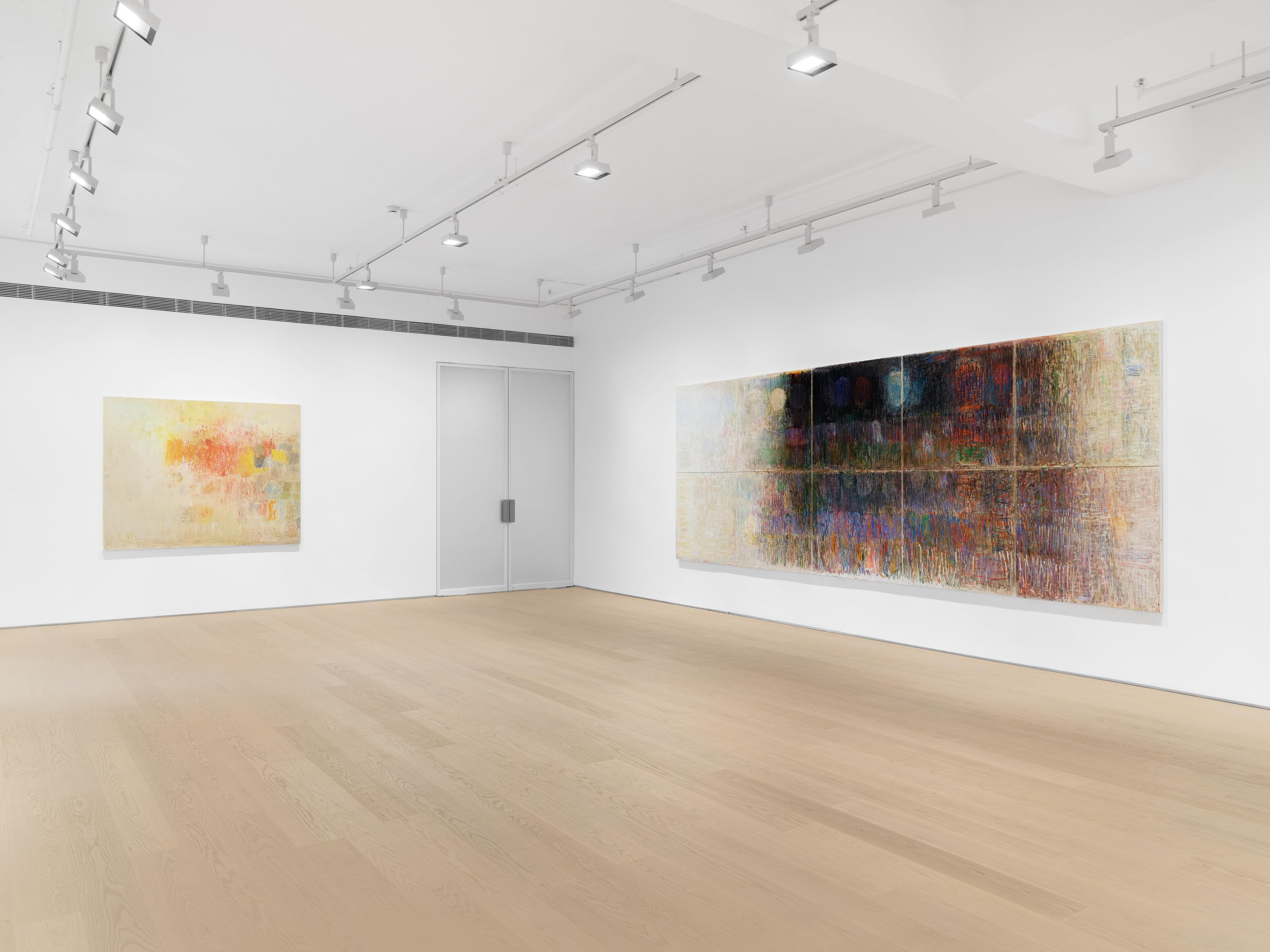
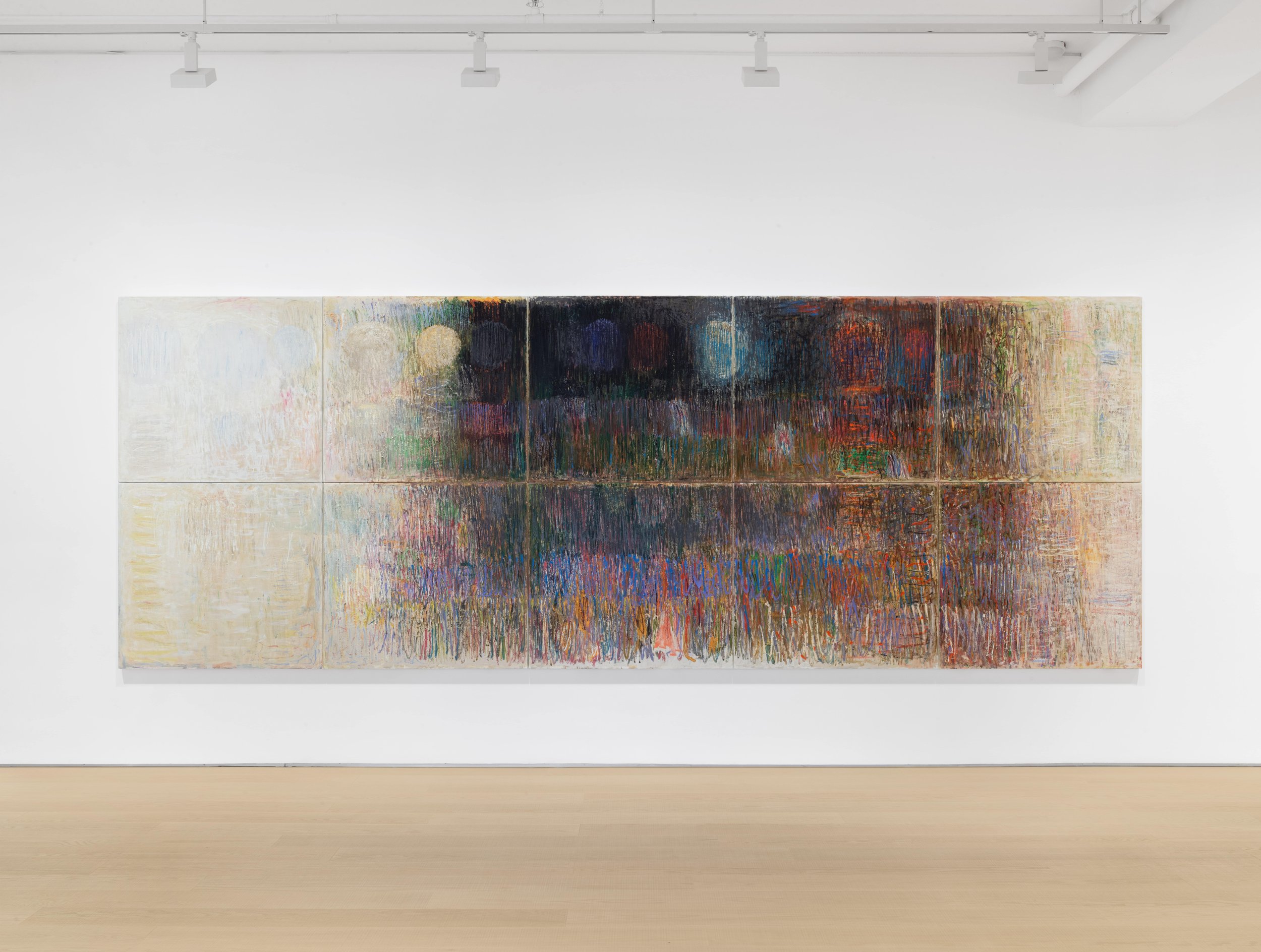
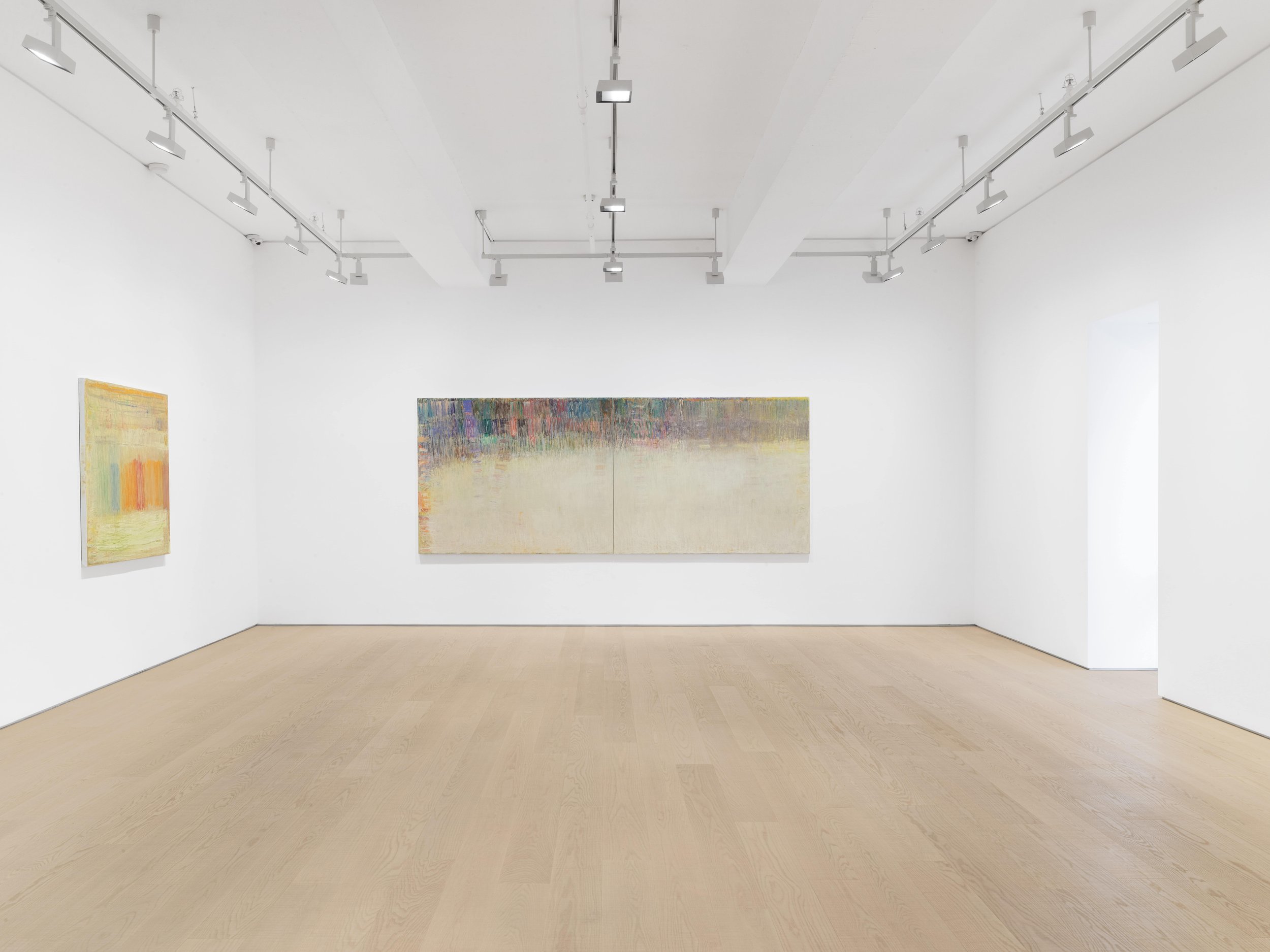

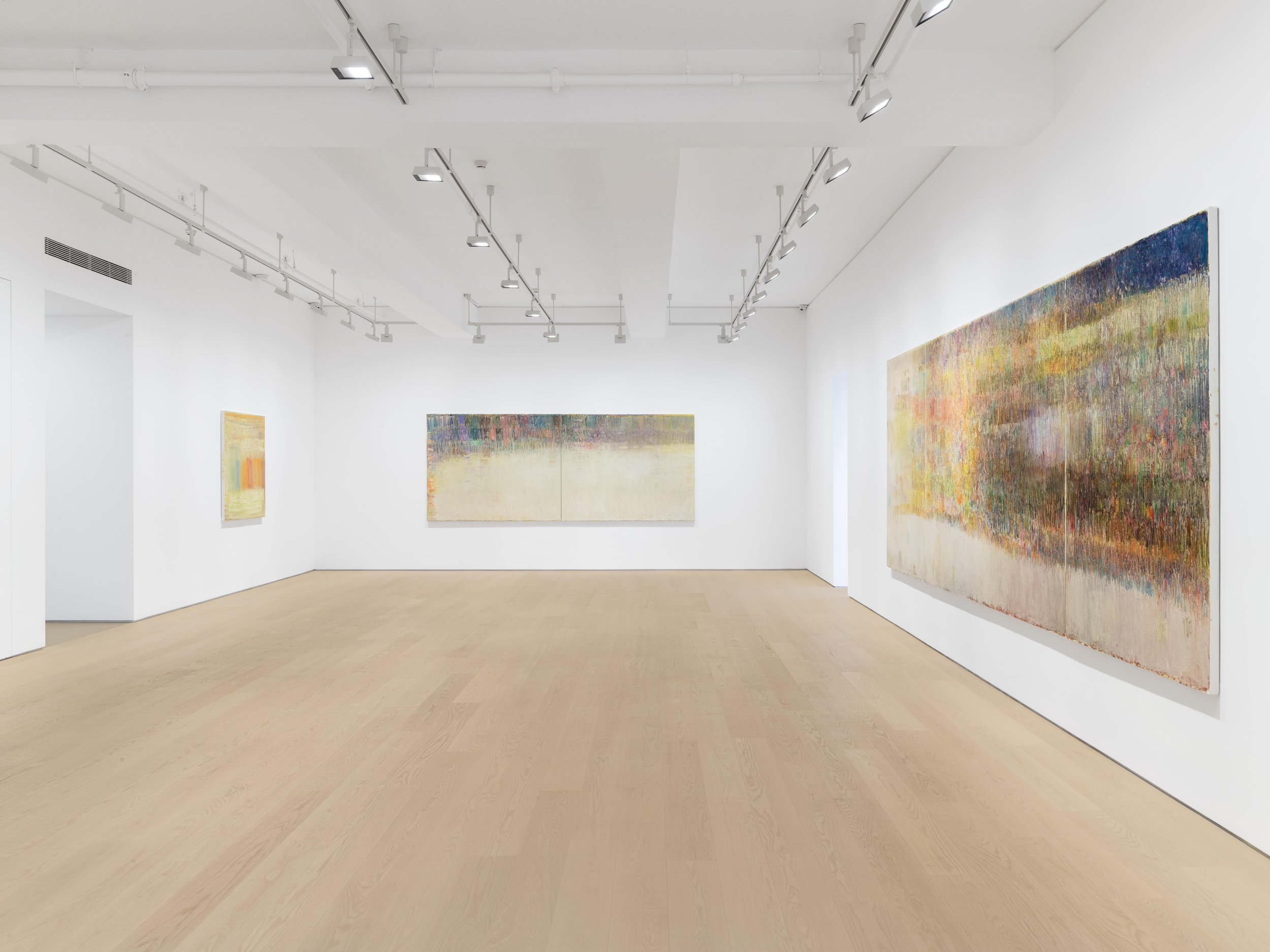
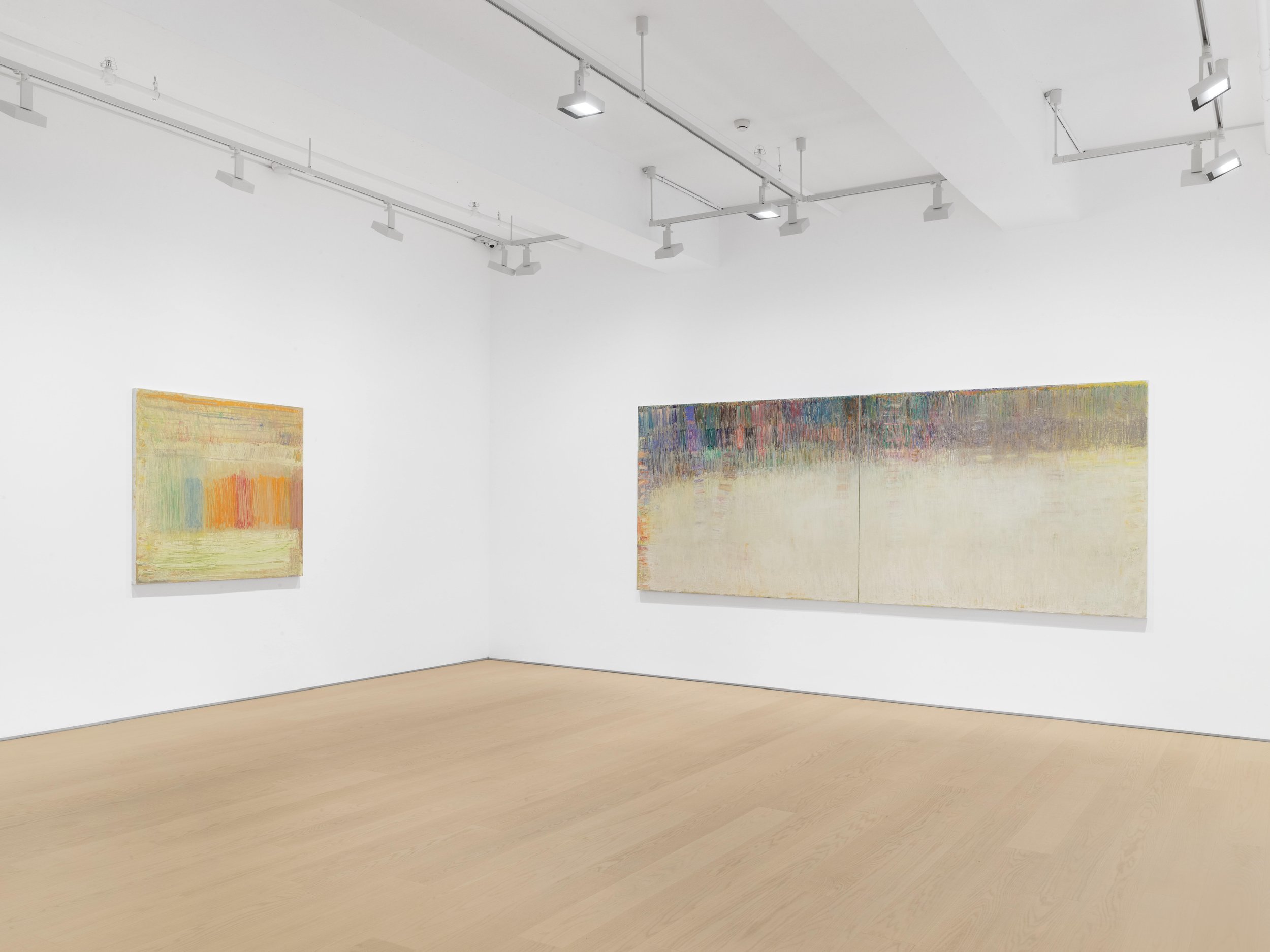
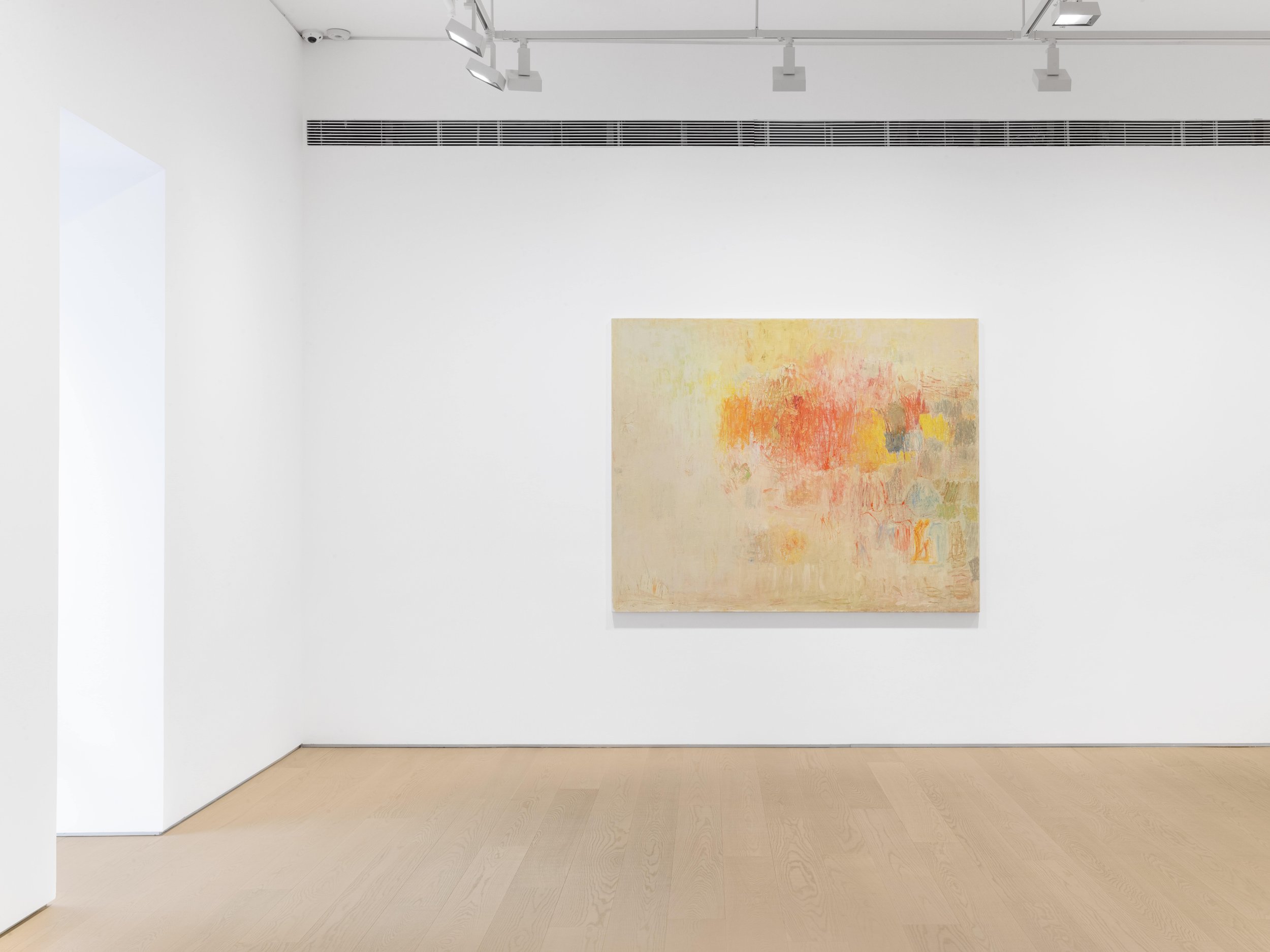

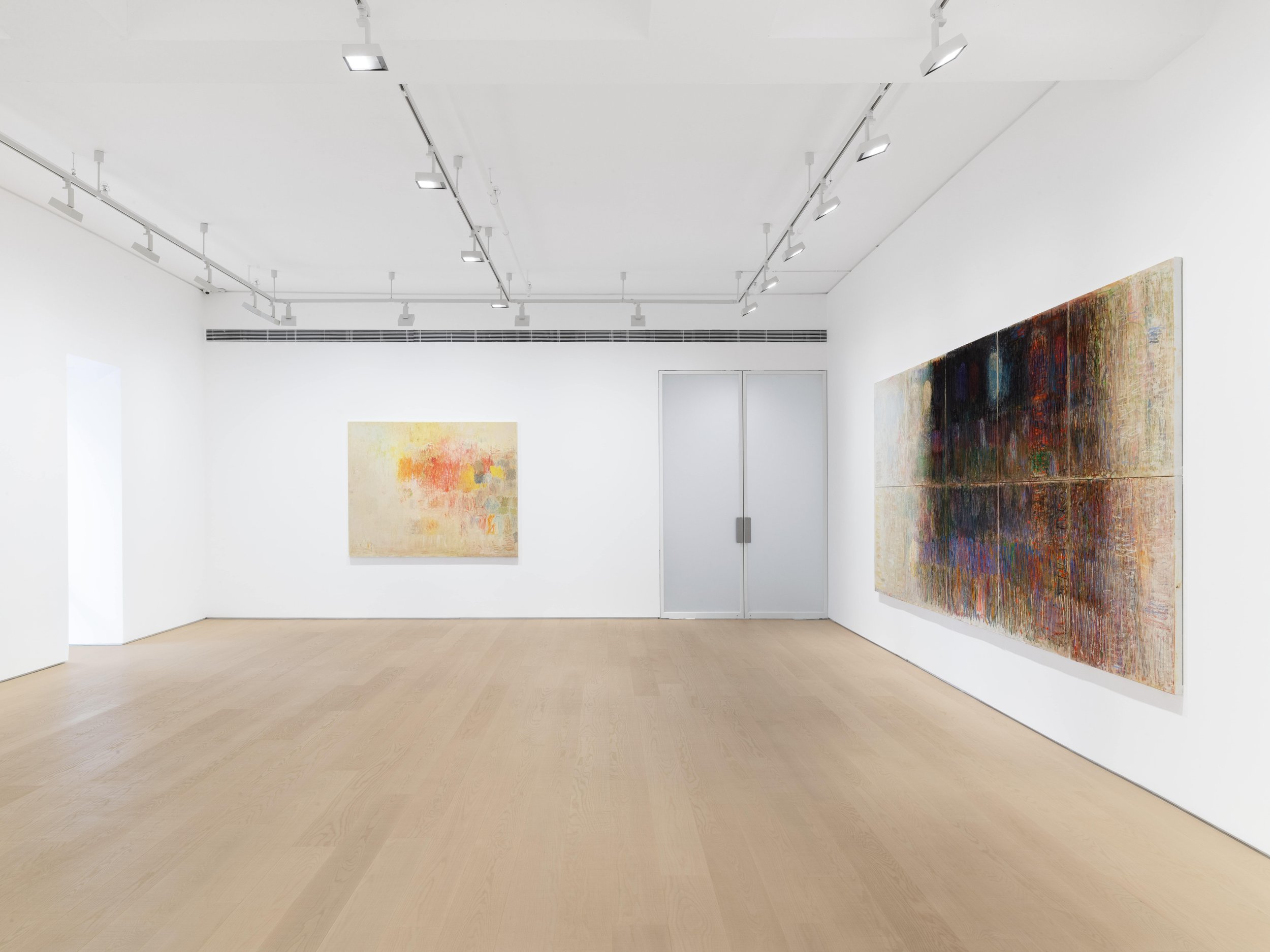
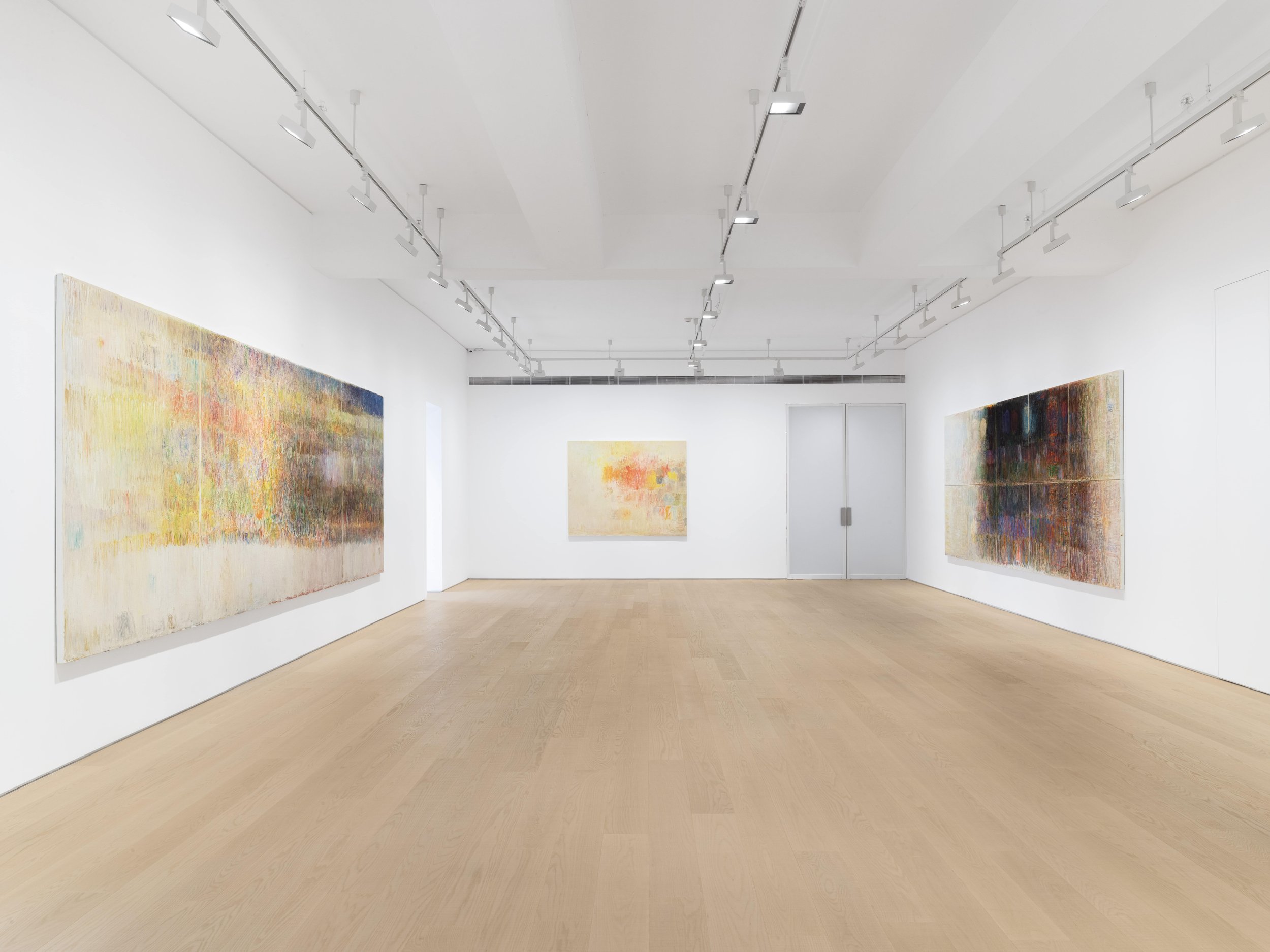
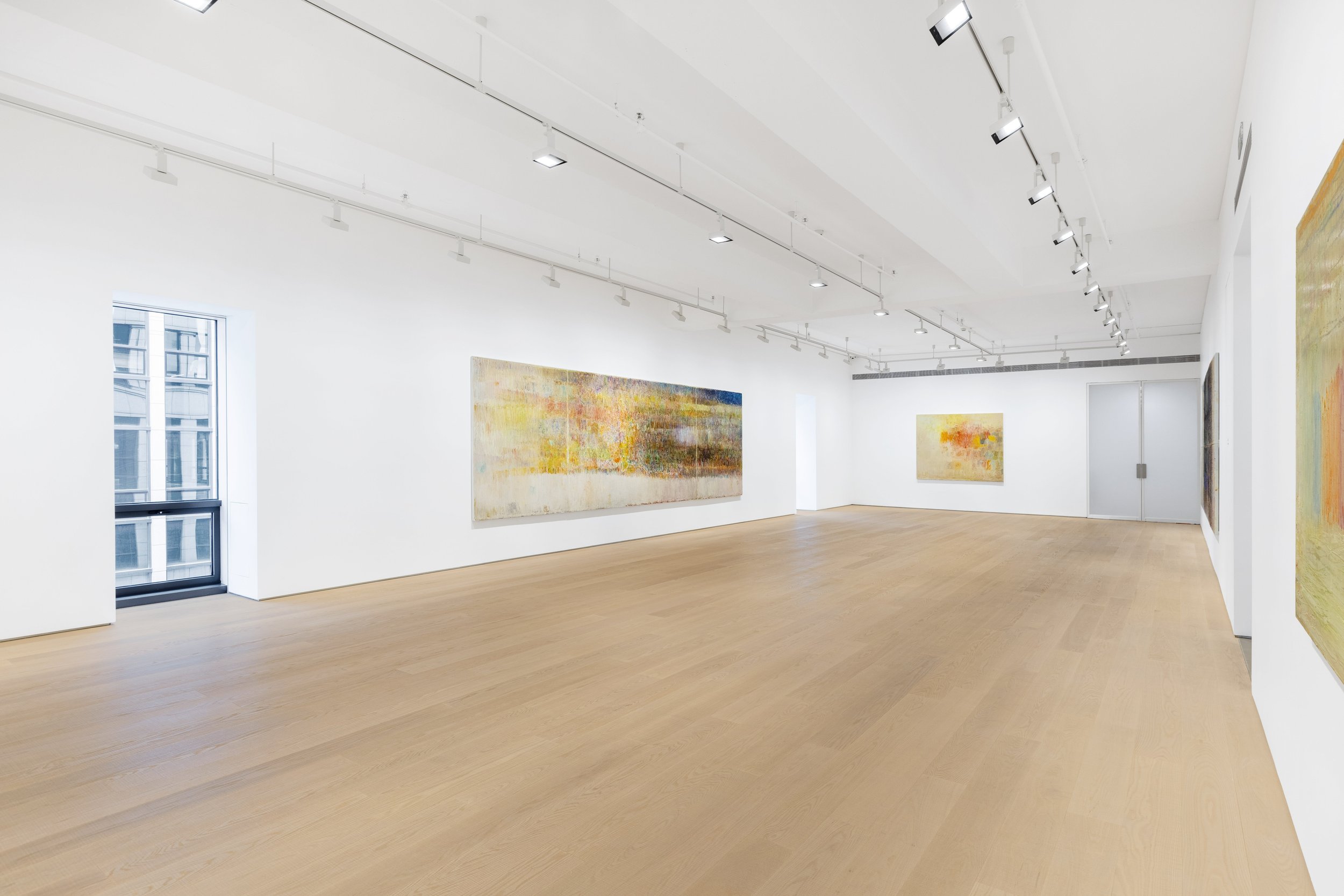
Installation view of Christopher Le Brun: Phases of the Moon, Lisson Gallery, Beijing, 18 May – Autumn 2024 © Christopher Le Brun. Courtesy Lisson Gallery. Photography by Yang Hao 克里斯多夫·勒·布伦个展「月相」现场图,里森画廊,北京,2024年5月18日至2024年秋季 © 克里斯多夫·勒·布伦。图片由里森画廊提供,由杨灏拍摄
About the artist
Sir Christopher Le Brun is one of the leading British painters of his generation, celebrated internationally since the 1980s, making both figurative and abstract work in painting, sculpture and print. He was an instrumental public figure in his role as President of the Royal Academy of Arts in London from 2011 to 2019. He was awarded a Knighthood for services to the Arts in the 2021 New Year Honours. At the beginning of 2023, a further two of his major pieces were added to institutional collections of Tate Gallery in London and the Museum of Contemporary Art & Urban Planning (MoCAUP) in Shenzhen.
Le Brun employs a mastery of touch and colour alongside a profound understanding of art history and a wide range of visual, musical and literary sources. He has remained consistent in adhering to what he feels to be the essential poetry and pleasure of painting for its own sake, led by intuition and visual imagination and resistant to external justification.
His interest in the formal possibilities of painting has led recently to the development of modular compositions from single pieces through to large and highly complex canvases, triptychs and monumental multipart paintings, extending the limits of abstract pictorial composition. A heightened awareness of the physicality of the painting process with its dramatic tension between revealing and covering, has been a central feature of his work that unites all its phases whether abstract or figurative.
Born in Portsmouth in 1951, Christopher Le Brun trained at the Slade and Chelsea Schools of Art, London. In his early career, he was a double prizewinner at the John Moores exhibitions (1978, 1980), also showing in the Venice Biennale (1980) and the ground-breaking exhibition ‘Zeitgeist’ (1982) at the Martin-Gropius Bau, Berlin. His recent solo exhibitions have been held at Albertz Benda, New York, USA (2023); Lisson Gallery, London, UK (2022); Albertz Benda, Los Angeles, USA (2022); Red Brick Art Museum, Beijing, China (2021); Albertz Benda, New York, USA (2020); Lisson Gallery, Shanghai, China (2019); Lisson Gallery, London, UK (2018); the
Southampton Art Gallery, Southampton, UK (2018); Wolfson College, Cambridge, UK (2018); Albertz Benda, New York, NY, USA (2017); The Gallery at Windsor, Vero Beach, FL, USA (2017); Colnaghi, London, UK (2015); Friedman Benda, New York, NY, USA (2014); New Art Centre, Wiltshire, UK (2010) and The New Art Gallery, Walsall, UK (2008). Le Brun served as a trustee of Tate from 1990–1995; The National Gallery from 1996–2003; the Dulwich Picture Gallery from 2000–2005; and as a founding trustee of the Royal Drawing School from 2003–2016. He was a trustee of the National Portrait Gallery between 2012-19. He was elected the first Professor of Drawing of the Royal Academy, London in 2000, where he also served as President from 2011-2021, the 26th since Sir Joshua Reynolds and the youngest since Lord Leighton in 1878.
His work is in many museum collections including Tate Gallery, London, UK; Museum of Modern Art, New York, USA; Museum of Contemporary Art & Urban Planning (MoCAUP), Shenzhen, China, the British Museum, London, UK; Art Gallery of New South Wales, Sydney, Australia; Metropolitan Museum of Art, New York, USA; Victoria & Albert Museum, London, UK; Scottish National Gallery of Modern Art, Edinburgh, Scotland; The Whitworth, Manchester, UK; Red Brick Art Museum, Beijing, China, Yale Center for British Art, New Haven, USA, and Museum of Fine Arts, Houston, USA. Le Brun’s public sculptures include Union (horse with two discs) at the Museum of London; City Wing on the site of the London Stock Exchange at Threadneedle Street; and The Monument to Victor Hugo on the quayside in St Helier, Jersey.
About Lisson Gallery
Lisson Gallery is one of the most influential and longest-running international contemporary art galleries in the world. Today the gallery supports and promotes the work of more than 60 international artists across spaces in London, New York, Los Angeles, Shanghai and Beijing. Established in 1967 by Nicholas Logsdail, Lisson Gallery pioneered the early careers of important Minimal and Conceptual artists, such as Art & Language, Carl Andre, Daniel Buren, Donald Judd, John Latham, Sol LeWitt, Richard Long and Robert Ryman among many others. It still works with many of these artists as well as others of that generation from Carmen Herrera to the renowned estate of Leon Polk Smith. In its second decade the gallery introduced significant British sculptors to the public for the first time, including Tony Cragg, Richard Deacon, Anish Kapoor, Shirazeh Houshiary and Julian Opie. Since 2000, the gallery has gone on to represent many more leading international artists such as Marina Abramović, Ai Weiwei, John Akomfrah, Susan Hiller, Tatsuo Miyajima and Sean Scully. It is also responsible for raising the international profile of a younger generation of artists led by Cory Arcangel, Ryan Gander, Van Hanos, Hugh Hayden, Haroon Mirza, Laure Prouvost, Pedro Reyes and Wael Shawky.
The exhibition opened on May 18 and will end in Autumn 2024, the opening was held from 3-6pm on May 18 2024, Lisson Gallery is located at 4/F, Building D7, Yard No.3, Jinhang East Road, Beijing.
For more information about this exhibition and others, please visit the Lisson Gallery here. The gallery can also be found on Facebook, YouTube, and Instagram.
THE COLLECTION: A Sports Meeting
Jean-Michel Basquiat & Andy Warhol Olympic Rings, 1985 Acrylic and silkscreen ink on canvas 208 x 466 cm Collection Éditions Enrico Navarra © Estate of Jean-Michel Basquiat. Licensed by Artestar, New York © 2024 - The Andy Warhol Foundation for the Visual Arts, Inc. / Licensed by ADAGP, Paris Photo: © Fondation Louis Vuitton / David Bordes
In recognition of the Olympic flame’s passage through the Fondation, the Louis Vuitton building opened on May 4th and will be on view until the 9th of September 2024.
Select works from our Collection will be displayed on the second level, with creations from five international artists united in Galleries 9 through 11. The depth and breadth of these œuvres provide an uncommon, poetic perspective on the theme of sports.
Abraham Poincheval Walk on Cloud, 2019 [Marche sur les nuages] Digital video, color, sound, 14 min 05 s Fondation Louis Vuitton, Paris © Andreas Gursky / Courtesy Sprüth Magers / ADAGP, 2024
In Gallery 9 is the spectacular installation Walk on Clouds, 2019, by Abraham Poincheval (b. 1972) showing the artist strolling across a cloud canopy. Seeming to hang in thin air, he is actually supported by a hot-air balloon fitted with drones, making it possible for him to be filmed. The video is the product of this performance, one that demanded the artist’s total commitment of mind and body - and such risk-taking that this “walk” appears to be as much an athletic feat as a dream.
Andreas Gursky Engadin, 1995 Chromogenic Print 186 x 291 cm Fondation Louis Vuitton, Paris ©ADAGP, Paris 2024
In the photo Engadin, 1995 by Andreas Gursky (b. 1955), grandiose Swiss peaks are surrounded by an intensely blue sky, creating a sublime, panoramic vision. Humankind - represented by a slender strand of cross-country skiers rendered miniscule by contrast - all but disappears before the power of nature and only seems to exist in man’s determination to challenge the elements.
Gallery 11 holds the installation by Roman Signer (b. 1938), Installation mit Kajaks (“Installation with Kayak”) from 2003, featuring a kayak, an important element of the artist’s visual vocabulary since the late 1980s. This vessel, usually symbolic of movement and speed, is deprived of all utility by being suspended from the ceiling, but thereby also acquires the status of sculpture, showcasing its streamlined beauty.
Omar Victor Diop Diaspora, 2014-2015 Inkjet prints 60 x 40 / 60 x 60 cm chaque (x18) [Albert Badin, 2014 ; Kwasi Boakye, 2014 ; Dom Nicolau, 2014 ; Olaudah Equiano, 2014 ; Juan de Pareja, 2014 ; Jean-Baptiste Belley, 2014 ; Ayuba Suleiman Diallo, 2014 ; Angelo Soliman, 2014 ; August Sabac El Cher, 2014 ; St Bénédicte de Palerme, 2014 ; Don Miguel De Castro, 2014 ; El Moro, 2014 ; Pedro Camejo, 2015 ; Omar Ibn Saïd, 2015 ; Malick Ambar, 2015 ; Ikhlas Khan, 2015 ; Henrique Dias, 2015 ; Frédérick Douglass, 2015], 2014-2015 Fondation Louis Vuitton, Paris © Omar Victor Diop
The work of Omar Victor Diop (b. 1980), Diaspora, resembles a portrait gallery of African figures from the 16th to the 19th centuries, all of whom played an important role outside their home continent. It is, in fact, the artist - costumed and staged - who embodies them all in a sweeping history of the genre, from Mughal miniatures to European court portraits. A red card, a ball, goalie gloves, a whistle: a number of unexpected accessories, symbolic items from the sports world, disrupt the seemingly traditional portrayal of these figures.
Jean-Michel Basquiat Napoleonic Stereotype Circa 44, 1983 Acrylic, oil, and pencil on canvas 167.6 x 152.4 cm Fondation Louis Vuitton, Paris © Estate of Jean-Michel Basquiat Licensed by Artestar, New York Photo: © Fondation Louis Vuitton / Marc Domage
Jean-Michel Basquiat’s desire to bring the “invisible man” into existence and his fascination with heroes are recurrent themes in his works. Boxers like Sugar Ray Robinson and Mohammad Ali feature in this artistic pantheon. Napoleonic Stereotype Circa 44 (1983) is a nod to another boxer, Joe Louis, whose hitherto victorious career was tarnished by a highly symbolic defeat in 1936 against Max Schmeling, who fought on behalf of Nazi Germany.
The official emblem of the Olympic Games - five circles representing the five continents - served as a motif for Warhol, who collaborated with Jean-Michel Basquiat (1960-1988) to produce several works on this theme. In 1985’s Olympic Rings, the geometric acronym of the rings is painted by Andy Warhol (1928-1987) in his consummate style, while Basquiat’s striking contribution is a black, mask-like face in the composition’s centre. This work, on loan from the Éditions Enrico Navarra collection, was a highlight of the 2023 Basquiat x Warhol. Painting Four Hands exhibition at the Fondation Louis Vuitton, and the loan has been generously extended to celebrate the Olympic and Paralympic Games in Paris 2024.
This project has been labeled by Paris 2024 as part of the Olympiade Culturelle.
For more information about this exhibition and the Louis Vuitton Fondation please visit their site here or on Facebook, Instagram, YouTube, and TikTok.
Lu Yang — Open Space #14
Lu Yang, DOKU The Flow (2023) film still, courtesy the artist and Société, Berlin
Lu Yang is a multimedia artist who graduated from the China Academy of Art’s New Media Art Department in Hangzhou. The artist was born in China in 1984 and lives and works in Shanghai and Tokyo. Lu Yang has a multidisciplinary practice and particularly favours the use of advanced digital technologies, and wide-ranging collaborations, including designers, composers, psychologists, dancers, engineers and scientists, through which he creates virtual worlds that unfold in immersive video installations. His fantastic imaginary realm, one with postapocalyptic overtones, is born of a syncretism in which Japanese popular culture - video games, manga, anime, pop music - dovetails with Buddhist spirituality, transhumanist theories and neuroscientific research. From this concoction, the artist brings to life hybrid creatures that transcend identity concepts of gender, sex and nationality to better understand what it means to be human in the 21st century.











Lu Yang, DOKU The Flow (2023) film still, courtesy the artist and Société, Berlin
For Open Space #14, his first solo exhibition in a French institution, Lu Yang conceives a unique video installation centered around his new film DOKU The Flow, the second chapter of the “DOKU” series. Derived from the Japanese word DOKUSHO DOKUSHI, meaning “We are born alone, and we die alone”, DOKU is a virtual character created from the digitization of the artist’s own body. The film depicts the solitary adventures of this multi-faced avatar through which Lu Yang transcends the boundaries of the physical body, exploring a new form of freedom through digital reincarnation. DOKU The Flow was produced with the support of the Fondation Louis Vuitton.
Lu Yang, DOKU The Flow (2023) film still, courtesy the artist and Société, Berlin
Curators: Claudia Buizza and Ludovic Delalande (Fondation Louis Vuitton)
As a partner venue of the Fondation Louis Vuitton (Paris), K11 will host DOKU The Flow by Lu Yang in K11 Shenzhen next spring 2025.
Lu Yang, DOKU The Flow (2023) film still, courtesy the artist and Société, Berlin
Lu Yang (1984, China)
Lives and works in Shanghai (China) and Tokyo (Japan) Recent solo exhibitions: Mudec, Milano; Kunsthalle Basel, Basel; Palais Populaire, Berlin; ARoS Museum, Aarhus; M Woods, Beijing; MOCA Cleveland; Ullens Center for Contemporary Art, Beijing; Zabludowicz Collection, London; Mori Art Museum, Tokyo and Kunstpalais Erlangen. Recent group exhibitions: Centre Pompidou-Metz; Muzeion, Bolzano; La Biennale di Venezia; Rockbund Art Museum, Shanghai; CCA, Tel Aviv; ICA, London; Muzeum Sztuki, Poland; Centre Pompidou, Paris; Hamburger Bahnhof, Berlin; Fridericianum, Kassel. Lu Yang is represented by Société, Berlin.
For more information about this exhibition and the Louis Vuitton Fondation please visit their site here or on Facebook, Instagram, YouTube, and TikTok. for more information about Lu Yang’s work, please visit Lu Yang’s website here and follow them on Instagram.
ELLSWORTH KELLY: SHAPES AND COLORS, 1949-2015
Ellsworth Kelly, Spectrum VIII, 2014 Acrylic on canvas, 12 joined panels 635 × 584,2 cm Fondation Louis Vuitton, Paris © Ellsworth Kelly Foundation Photo: © Fondation Louis Vuitton / Marc Domage
In the Spring of 2024, Fondation Louis Vuitton is reaffirming its mission: promoting the art of our time to the widest possible audience. Committed to the presentation of ‘landmark works of modernity,’ the Fondation also undertakes to celebrate artists who, while having a connection with the history of modernity, have proposed new models and disrupted perceptions. At the same time, the Fondation supports contemporary creators who boldly set out to reinvent their times, while the Open Space program continues to support and disseminate emerging talent.
From May 4 to September 9, 2024, a landmark exhibition dedicated to The Red Studio (1911) by Henri Matisse (1869-1954) is being presented at the same time as a new retrospective of the work of Ellsworth Kelly (1923-2015) featuring paintings, sculptures, photographs and drawings.
In addition, in the context of the Olympic Games in Paris, the Fondation presents a selection of works from the Collection which relate to sports, offering an alternative and poetic vision of this international event.
This exhibition is organized with Glenstone Museum, Potomac, Maryland, United States in collaboration with the Ellsworth Kelly Studio in the context of “Ellsworth Kelly at 100”.
Head curator
Suzanne Pagé, Artistic Director of the Fondation Louis Vuitton
Curators
Emily Wei Rales, Nora Severson Cafritz, Yuri Stone
Curator for the presentation in Paris
Olivier Michelon, assisted by Clotilde Monroe
FONDATION LOUIS VUITTON
Bernard Arnault President of the Fondation Louis Vuitton
Jean-Paul Claverie Advisor to the President
Suzanne Pagé Artistic Director
Sophie Durrleman Executive Director
Ellsworth Kelly, Upper Manhattan Bay, 1957 Collage on postcards 8.6 x 13 cm Private Collection © Ellsworth Kelly Foundation
To celebrate the centenary of the artist’s birth, “Ellsworth Kelly. Shapes and Colors, 1949-2015” will be the first exhibition in France to offer a broad overview of the work of this significant artist of the second half of the 20th century - both in terms of its chronology and in terms of the media on display. Organized with Glenstone Museum (Potomac, Maryland) and in collaboration with the Ellsworth Kelly Studio, the exhibition brings together more than 100 works: paintings and sculptures as well as drawings, photographs and collages. The exhibition has been supported by loans from international institutions (the Art Institute of Chicago, Kröller-Müller Museum, The Museum of Modern Art, San Francisco Museum of Modern Art, Tate, Whitney Museum) as well as private collections.
Ellsworth Kelly is regarded as one of the most significant American abstract painters and sculptors. His career, which spanned seven decades, was marked by his artistic independence from any school or movement, and by his groundbreaking contributions to 20th century painting and sculpture.
Kelly drew inspiration from nature and the world around him to create a singular style which revitalized abstraction in the 20th and 21st centuries. Ten years after his passing, his works still elicit the same fascination, well beyond the habitual boundaries of painting. Fondation Louis
Vuitton has the opportunity to witness this every day: its Auditorium houses the final work ever to have been commissioned from the artist. Designed in a dialogue with the elements of Frank Gehry’s architecture, it extends from the stage curtain (Spectrum VIII) to the walls of the concert hall, which are lifted and animated by a series of red, yellow, blue, green and violet monochromes.



















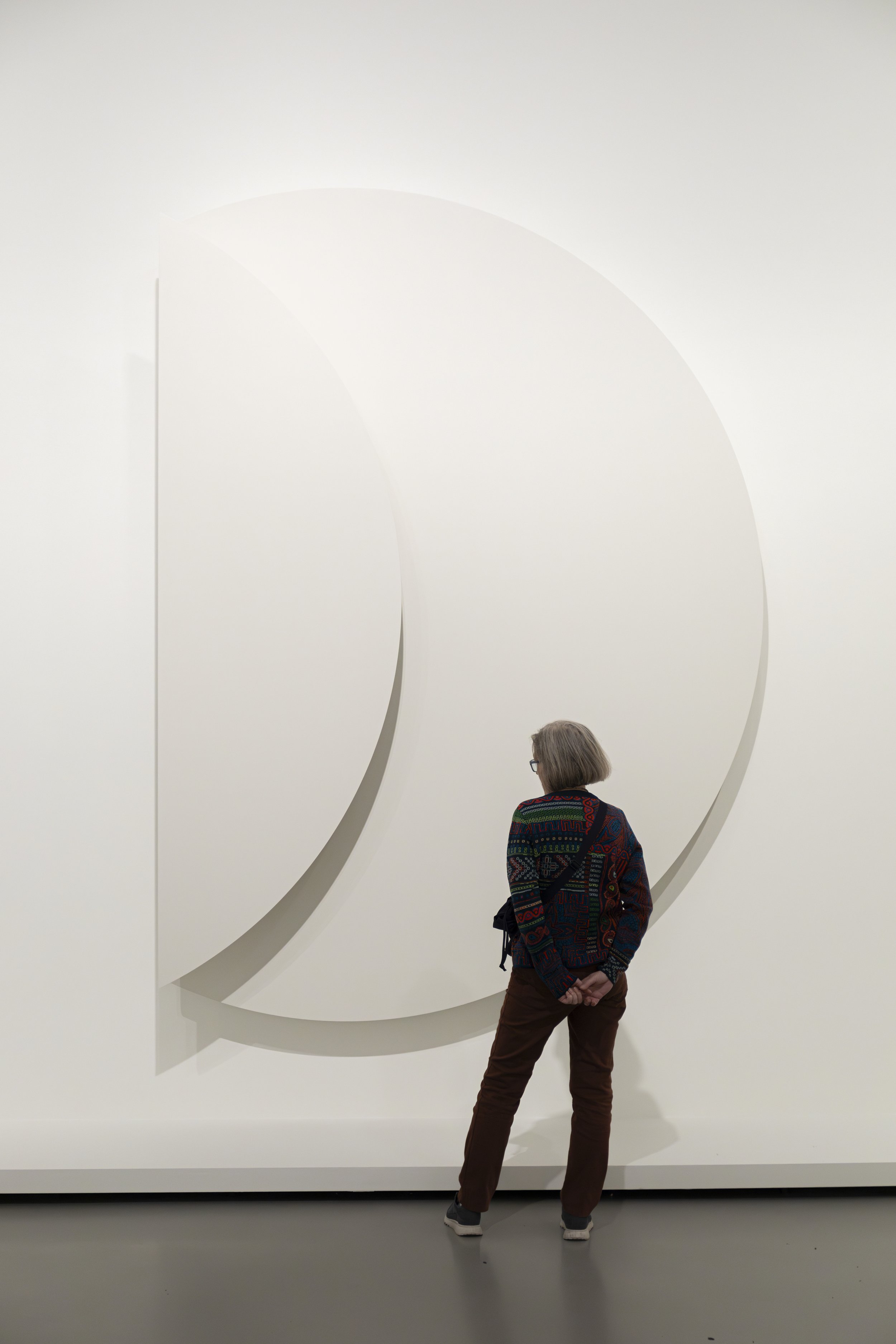










Installation View: Ellsworth Kelly: Shapes and Colors, 1949-2015, May 4 to September 9, 2024, Fondation Louis Vuitton, Paris © Ellsworth Kelly Foundation Photo: © Fondation Louis Vuitton / Marc Domage
The exhibition “Ellsworth Kelly. Shapes and Colors, 1949-2015” traces the artist’s exploration of the relationship between shape, color, line and space through key works from pivotal periods in his career.
The range of works, presented on two floors of the building and across nearly 1,500 square meters, urges the viewer to overlook the deceptive simplicity of Ellsworth Kelly’s artistic vocabulary and to appreciate a body of works that features surprising vitality and richness. Often monochrome, and seemingly rigid in their composition, these works don’t emerge from a system or from adherence to particular rules. They are the result of a visual quest in which shapes and colors go hand in hand with hedonism.
Presented in the Fondation’s ground and first floors, the exhibition includes around 100 works from the collections of the Glenstone Museum, the Fondation Louis Vuitton and major international museums, particularly the Centre Pompidou, Art Institute of Chicago, Philadelphia Museum of Art, Kröller-Müller Museum (The Netherlands), San Francisco Museum of Modern Art, Tate (London), Walker Art Center (Minneapolis) and the Whitney Museum of American Art (New York). Major works have also been generously loaned by the Ellsworth Kelly Studio and by private collections.
The exhibited works cover the wide range of media used by the artist: from painting to sculpture to works on paper - collage and photography. Exhibition highlights include paintings from the artist’s youth, such as Tableau Vert (1952) - the first monochrome made after Ellsworth Kelly’s visit to Giverny - or Painting in Three Panels (1956), a key example of the painter’s commitment to architecture. These early works are exhibited ahead of examples from the now canonical Chatham and Spectrum series. Prominently featured are a selection of drawings of plants produced throughout the artist’s career, as well as a collection of rarely exhibited photographs.
Striking works in the exhibition include Yellow Curve (1990), the first in a series of large-scale floor paintings by Ellsworth Kelly, displayed in a specially-designed space. The installation, which extends over more than 60 square meters, is the first presentation in Europe of Yellow Curve since its creation in 1990 for an exhibition in Portikus, Frankfurt am Main.
Ellsworth Kelly, Atlantic, 1956 Oil on canvas, two panels 203.5 x 289.6 cm Whitney Museum of American Art, New York; purchase © Ellsworth Kelly Foundation
Another monumental work - a permanent one in this case - is the commission completed in 2014 by Ellsworth Kelly for Fondation Louis Vuitton’s Auditorium, in a dialogue with the architect Frank Gehry. Integrated in the exhibition, it will be presented to viewers in a documentary room that looks back on this project and its inclusion in the artist’s œuvre.
The exhibition “Ellsworth Kelly. Shapes and Colors, 1949-2015” is presented as part of “Ellsworth Kelly at 100,” a travelling exhibition organized by Glenstone Museum (Potomac, Maryland) where it was held until March 17, 2024. The French version of the exhibition has been adapted especially in light of Ellsworth Kelly’s contribution to the Fondation Louis Vuitton’s Auditorium. After Paris, where Ellsworth Kelly developed some of his most radical ideas as a young artist, a new presentation will be held at M7 in Doha (Qatar), marking the first exhibition of the artist’s work in the Middle East.
Ellsworth Kelly, Blue Curves, 2014 Painted aluminum 228.6 x 161.3 x 10.5 cm Ellsworth Kelly Studio, Spencertown © Ellsworth Kelly Foundation
This exhibition is accompanied by a fully illustrated catalogue, co-published by Glenstone Museum, Fondation Louis Vuitton, and Les Éditions Hazan, with contributions by Suzanne Hudson, Jean-Pierre Criqui, Peter Eleey, Alex Da Corte, Yuri Stone, Corey Keller and Sarah Rogers.
For more information about this exhibition and the Louis Vuitton Fondation please visit their site here or on Facebook, Instagram, YouTube, and TikTok.
Patternmaker's Maze 编织者迷宫
Wang Ye王也 Woman with Pails: Dynamic Arrangement 提桶的女人:动态组合 2021 Silk on silk handmade embroidery 手工刺绣 19.8 x 19.9 x 4.5 cm 7 3/4 x 7 7/8 x 1 3/4 in © Wang Ye. Courtesy Lisson Gallery
“Assuming that the global art industry, which revolves around everything from creation to collection, is a maze, then are the practitioners the ones setting it up or the ones finding a way out? Are we able to choose? How do we navigate through the tangled paths in this maze?”

















Installation view of Patternmaker’s Maze, Chapter I: Maze, Lisson Gallery, Shanghai, 20 July – 24 August 2024. Courtesy Lisson Gallery. Photography by Alessandro Wang
Taking its name from the labyrinth in the fantasy novel series A Song of Ice and Fire by George R. R. Martin, the group exhibition Patternmaker’s Maze attests to the complexity with which art and the artists engage in reality and the spiritual world. Extending beyond their physical existence, the artworks in this exhibition are recognized as both receivers and active contributors within a maze of socio-political, economic, and natural forces. They interact with the existing world of signs, visuality, and materiality while simultaneously questioning its structures and boundaries, breaking new grounds for interpreting the past, experiencing the present, and shaping the future.
In A Song of Ice and Fire, it is said that “only those who learn to walk [the maze] properly will find wisdom.” Presented in two chapters, ‘Maze’ and ‘Patternmakers’ , this exhibition brings together a group of artists who speak to the challenges and inspirations in the process of navigating and transforming the art world, utilising and being subject to the power dynamics within and across distinct social fields. The artworks presented in Lisson’s Shanghai gallery share a space of conversation, interweaving into a larger collective narrative while preserving their unique perspectives of being in the world. Ding Hongdan’s personal encounters in Estonia have informed the creation of the Toy Museum series, which points to the possibility of different choices made in distinct situations through figures wearing masks with multiple faces. Dressing Mirror (2024) examines human beings’ imagination for fortune and status via the stereotype perfect female image and the multi-dimensional worlds – the physical world, the world of fantasy and desire – divided by the mirror frame depicted in the composition and the frame of this painting.
Ryan Gander瑞安·甘德 Irresistible Force Paradox (LY1A) 不可抗拒的力量悖论 (LY1A) 2023 Paint on aluminium 颜料、铝材 180 x 122 x 5 cm 70 7/8 x 48 x 2 in © Ryan Gander. Courtesy the artist and Gallery Hyundai
Ryan Gander’s practice follows an associative process that bridges the mundane with the mysterious, challenging established notions of language and knowledge while reimagining the presentation and creation of artworks. In recent pieces he approaches “small things that may seem forgettable and insignificant but command our attention without requesting it, etching themselves into our memories.” In Natural Sign / Time Management (Solemn estranged moon) (2021), the artist depicts a full moon witnessed during the pandemic, a period when he experienced a drought of difference and inspiration; while the bold and colourful painting Irresistible Force Paradox (LY1A) (2023) is inspired by the cartoon Tintin – a childhood obsession and longstanding reference for Gander. Here, expressions of energy are visualised in a circle of instinctively comprehensible ‘action marks’ that signify movement, emotions and interactions between characters.
Channa Horwitz夏纳·霍维兹 Rhythm of Lines, 6-7 线条的韵律,6-7 1988 Casein and 23 karat gold leaf on Mylar 酪酸涂料、23克拉金箔、聚酯薄膜 76.2 x 101.6 cm 30 x 40 in © Channa Horwitz. Courtesy Lisson Gallery
Channa Horwitz's Rhythm of Lines, 6-7 (1988) highlights the artist’s rigorous conceptual structures and self- determined rules to capture space, movement and time with numerical sequence and lines. Each work from the Rhythm of Lines series is composed of a pairing of two sets of angled lines, creating intricate moiré patterns. The areas where the sets of lines cross are filled in with twenty-three-karat gold leaf. While the work may appear to be machine-generated, it was entirely hand-made.
Huang Tinglan黄婷岚 Behind the Reflection 镜面的背面 2024 Tapestry with cotton and wool yarn 单面织 100 x 90 cm 39 3/8 x 35 3/8 in © Huang Tinglan. Courtesy Lisson Gallery
Huang Tinglan’s practice centres around different scenes in daily life. The concept of “boxes”, to which she compares spaces, appears throughout her textile works. Characterised by two distinctive dominant colours, Place, Non-place 1 (2022) and The Exit (2022) depict her experience living in New York. The multiple textile layers resulting from the double-weave technique allude to compacted and enfolding spaces. Elsewhere, Behind the Reflection (2024) is inspired by Huang’s experiences of travel since returning to China. The boundary of “boxes” no longer exists, which is evidenced by the vibrant colour palette, the motifs of scenery and dancelike human bodies.
Christian Jankowski presents The Hunt (1992/1997), one of his earliest video works. This piece shows the artist’s one-week supermarket shopping experience during which, with an intention to rebel against modern society and to return to nature, he 'hunts down' groceries, shooting each item with a bow and arrow. Through comic incongruities, Jankowski humorously suggests that 'natural ways’, such as the act of hunting, and capitalist circulation, are not necessarily mutually exclusive.
Richard Long理查德·朗 Untitled 无题 2010 White china clay on black card 高岭土、黑色卡纸 101 x 143 cm 39 3/4 x 56 1/4 in © Richard Long. Courtesy Lisson Gallery
Richard Long makes a striking image in Untitled (2010) using white China Clay and the most elemental of means, his own hands, demonstrating his primeval fascination with mark-making. “All my work is simple. I like the primal energy of just handprints or fingerprints. It’s like cave painting.” Known for creating works that trace his physical movement through space, Untitled (2010) emphasises Long’s preoccupation with the physical engagement of the body in his work.
Otobong Nkanga奥托邦戈·恩坎加 Silent Anchor I 沉默的锚I 2023 Hand-blown glass and hand woven rope 手工吹制玻璃、手工编织绳索 Installed/装置后尺寸: 16 x 73 x 86 cm, 6 1/4 x 28 3/4 x 33 7/8 in © Otobong Nkanga. Courtesy Lisson Gallery
Otobong Nkanga’s Silent Anchor I (2023) presents a circuitry of hand-dyed rope and biomorphic glass forms, conceived as a spatial cleanser or talisman. A shallow well on the surface of the glass holds an offering of lavender oil, a substance believed to have healing, soothing and anti-inflammatory properties. The sculpture amplifies and extends the concept of energetic intervention beyond the body and into the spatial realm, suggesting a permeable boundary between the two domains.
Ren Jie任倢 Night Watch: The Origin of the World 3 夜巡:世界的起源3 2023 Wood frame with hand-woven reflexive textile and felt 木框、手工编织反光织物和毛毡 30.5 x 30.5 x 2 cm 12 x 12 x 0 3/4 in ed. 1 of 3 + 1 AP © Ren Jie. Courtesy Lisson Gallery
Ren Jie’s Night Watch series coalesces materials, everyday images as well as visual and physical experiences of contemporary life through the lens of the entanglement between textile techniques and modern computer technology. This series invites viewers to engage with the dialogue between space and materiality in a world dominated by fleeting digital viewing experiences, generating new interpretations on the subjects of labour and gender and unleashing the imagination around these topics from a literature perspective.
Shen Ruijun沈瑞筠 Swan Lake 天鹅湖 2016 Mixed-media with plinth综合材料、底座 45 x 120 x 45 cm 17 3/4 x 47 1/4 x 17 3/4 in © Shen Ruijun. Courtesy Lisson Gallery
Shen Ruijun’s mixed media installation Swan Lake (2016) depicts a state of multi-dimensionality, change, and unity of opposites. The piece’s utilisation of one-way mirror glass leads to different images appearing from different viewing angles. Referencing the duality and underlying, multi-faceted nature of the female characters in its namesake ballet masterpiece, the work highlights the perpetual change and repetition in time, places and contexts.
Shi Zheng 施政 BINE 蔓 2019 Single channel video installation, LED screen 单频影像装置、LED屏幕 © Shi Zheng Courtesy Lisson Gallery
Shi Zheng removes the images and texts from the front page of The New York Times, then trains an Artificial Neural Network to learn the data set consisting of lines between the columns. In the resulting single-channel video BINE (2019), the shifting and orderly lines appear and diminish to compose a body that continuously grows. Once acting as "the silhouette" that divided information, event, and time, the work explores “latent space” and delineates time by tracing its varying boundaries and framework.
Cheyney Thompson切尼·汤普森 Caning [4, interval] 藤茎 [4, 子域] 2023 Acrylic on canvas 布面丙烯 Installed/装置后尺寸: 118.1 x 118.1 x 2.2 cm, 46 1/2 x 46 1/2 x 7/8 in Square/画布大小: 83.5 x 2.2 cm, 32 7/7 x 32 7/8 x 7/8 in ©Cheyney Thompson. Courtesy Lisson Gallery
Cheyney Thompson started creating his Caning paintings series in 2004. In Caning [4, interval] made in 2023, the artist continues his exploration of structure through a weaving motif. Living in a highly structured world, Thompson considers the notion that structures are themselves built on contradictions. If a motif carries with it a trace of motivation, then these paintings are concerned with what can happen when structures are strained to a point of failure.
Wang Ye王也 Seated Bather 女坐浴者 2020 Silk on silk handmade embroidery 手工刺绣 19.9 x 15.7 x 4.5 cm 7 7/8 x 6 1/8 x 1 3/4 in © Wang Ye. Courtesy Lisson Gallery
Wang Ye develops his narratives by using traditional, hand-made embroidery techniques, originated in Hunan in the artist’s Embroidernity series. Moth (2022) was inspired by a giant moth he saw on a rusty window in his childhood. Having never seen the same type of moth again, he questioned whether such an experience was a dream or a missing memory. Subsequently, Wang identified the potential species by remembrance. Through this representation, the artist furthers his explorations of Chinese folk art technique and aesthetics.
About Lisson Gallery
Lisson Gallery is one of the most influential and longest-running international contemporary art galleries in the world. Today, the gallery supports and promotes the work of more than 70 international artists across spaces in London, New York, Los Angeles, Shanghai, and Beijing. Established in 1967 by Nicholas Logsdail, Lisson Gallery pioneered the early careers of important Minimal and Conceptual artists, such as Art & Language, Carl
Andre, Daniel Buren, Donald Judd, John Latham, Sol LeWitt, Richard Long and Robert Ryman among many others. It still works with many of these artists and others of that generation, from Carmen Herrera and Olga de Amaral to Hélio Oiticica and Lee Ufan. In its second decade the gallery introduced significant British sculptors to the public for the first time, including Tony Cragg, Richard Deacon, Anish Kapoor, Shirazeh Houshiary and Julian Opie. Since 2000, the gallery has gone on to represent many more leading international artists such as
Marina Abramović, Ai Weiwei, John Akomfrah, Liu Xiaodong, Otobong Nkanga, Pedro Reyes, Sean Scully, Hiroshi Sugimoto and Wael Shawky. It is also responsible for raising the international profile of a younger generation of artists including Dana Awartani, Cory Arcangel, Garrett Bradley, Ryan Gander, Josh Kline, Hugh Hayden, Haroon Mirza, Laure Prouvost and Cheyney Thompson.
Artists:
Ding Hongdan | Ryan Gander | Channa Horwitz | Huang Tinglan | Christian Jankowski | Richard Long | Otobong Nkanga | Ren Jie | Shen Ruijun | Shi Zheng | Cheyney Thompson | Wang Ye
Chapter I: Maze | 20 July – 24 August 2024
Chapter II: Pattern Makers | 31 August – 12 October 2024
There was an opening on July 20th of this year
For more information about this exhibition and others, please visit the Lisson Gallery here. The gallery can also be found on Facebook, YouTube, and Instagram.
DANIEL CHEN:PROCESS
Valise, Checkmate, Frequency
Radian Gallery is pleased to present “PROCESS,” the crystalline and pixelated landscape paintings of California artist Daniel Chen. The show opened on Wednesday June 24th is available for viewing through Saturday, August 31st. There was an opening reception on August 1 2024 from 5:00pm - 7:30pm PT at the gallery.
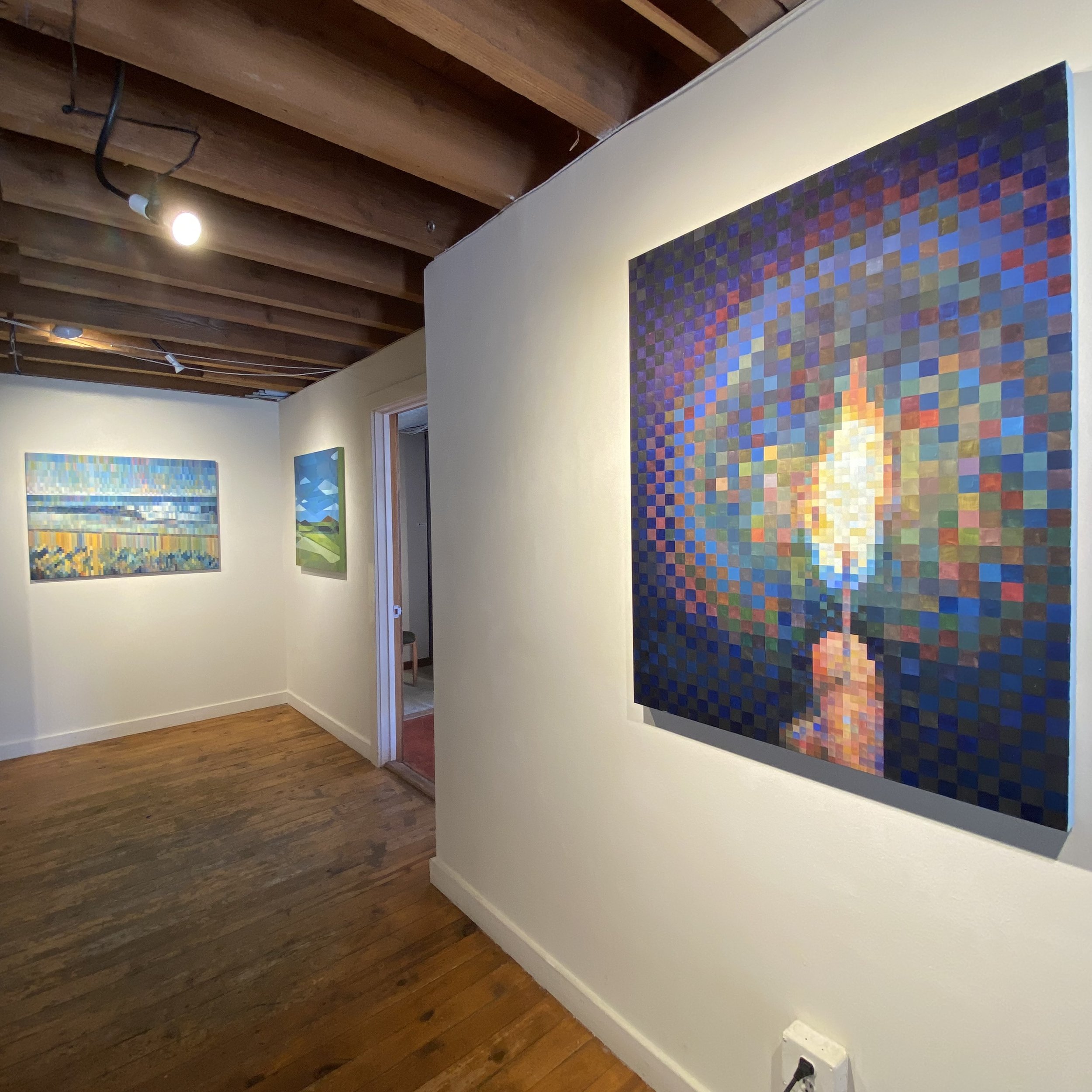
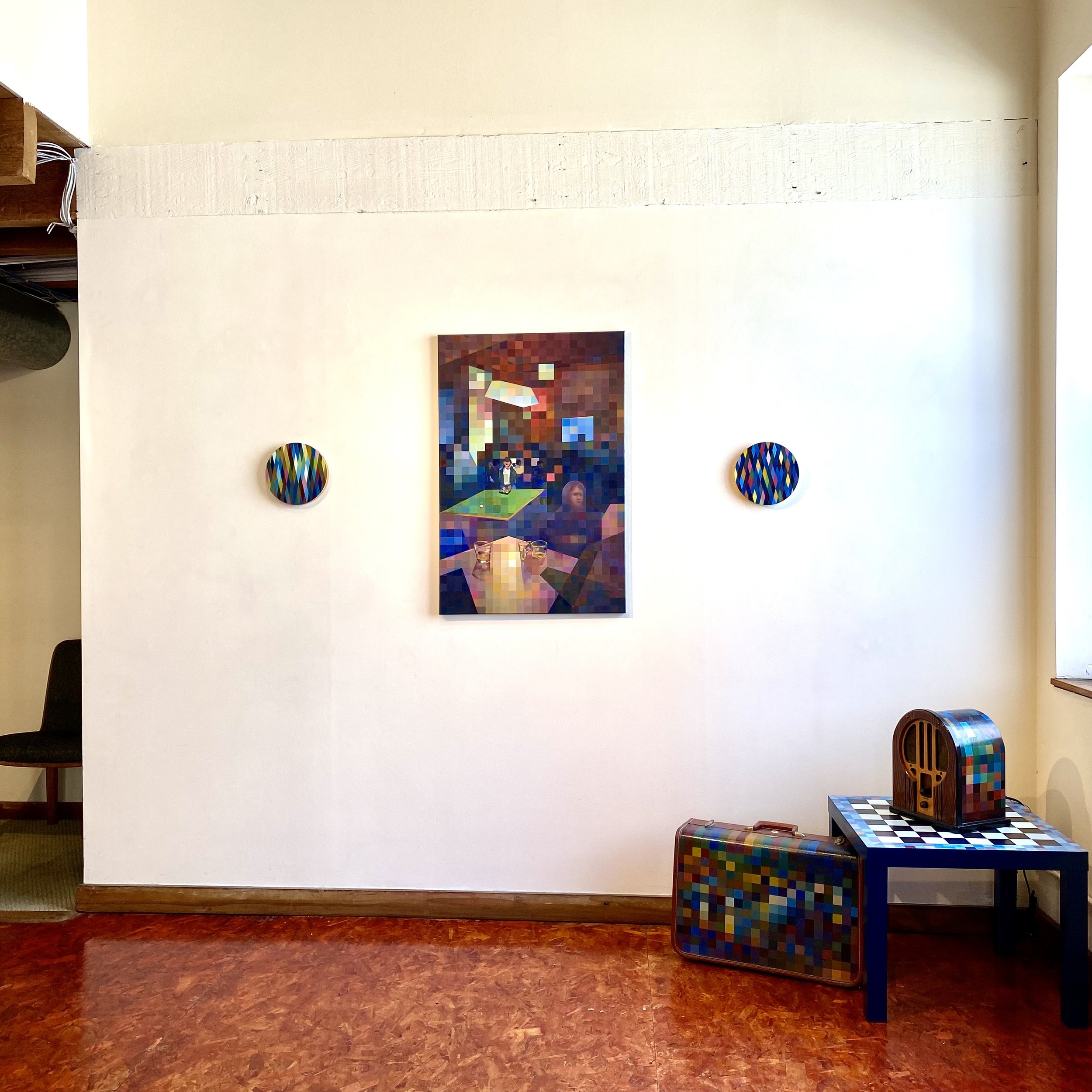
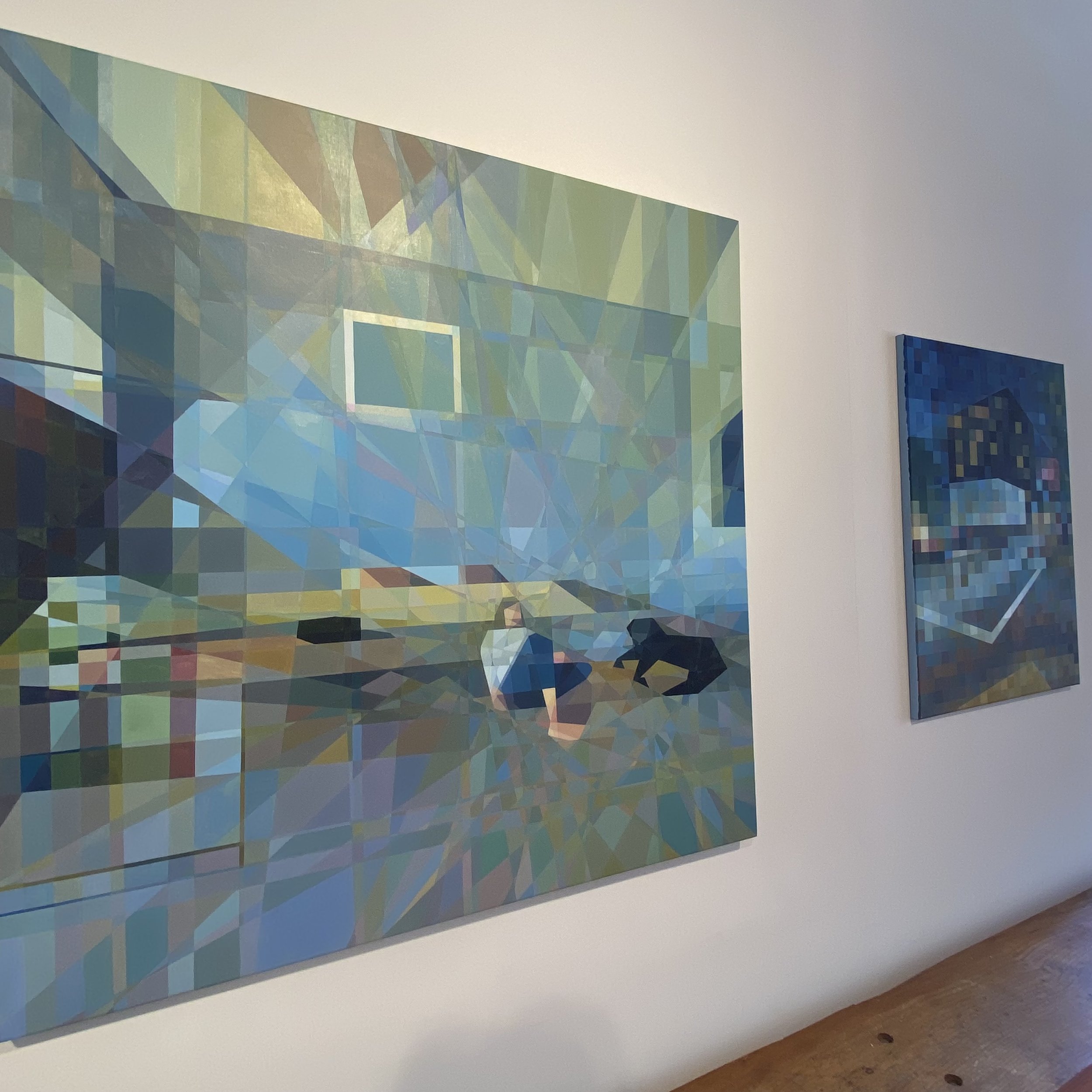
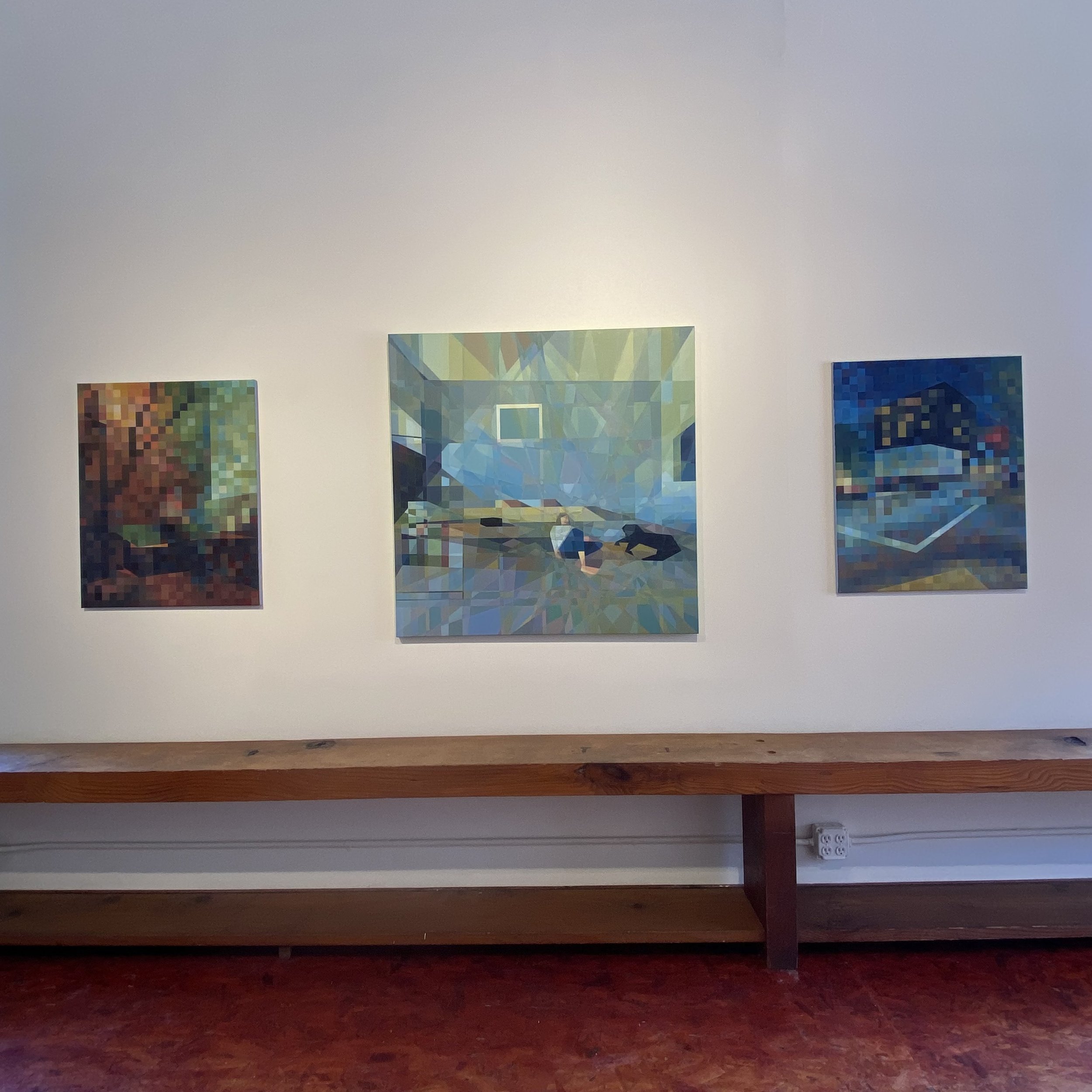



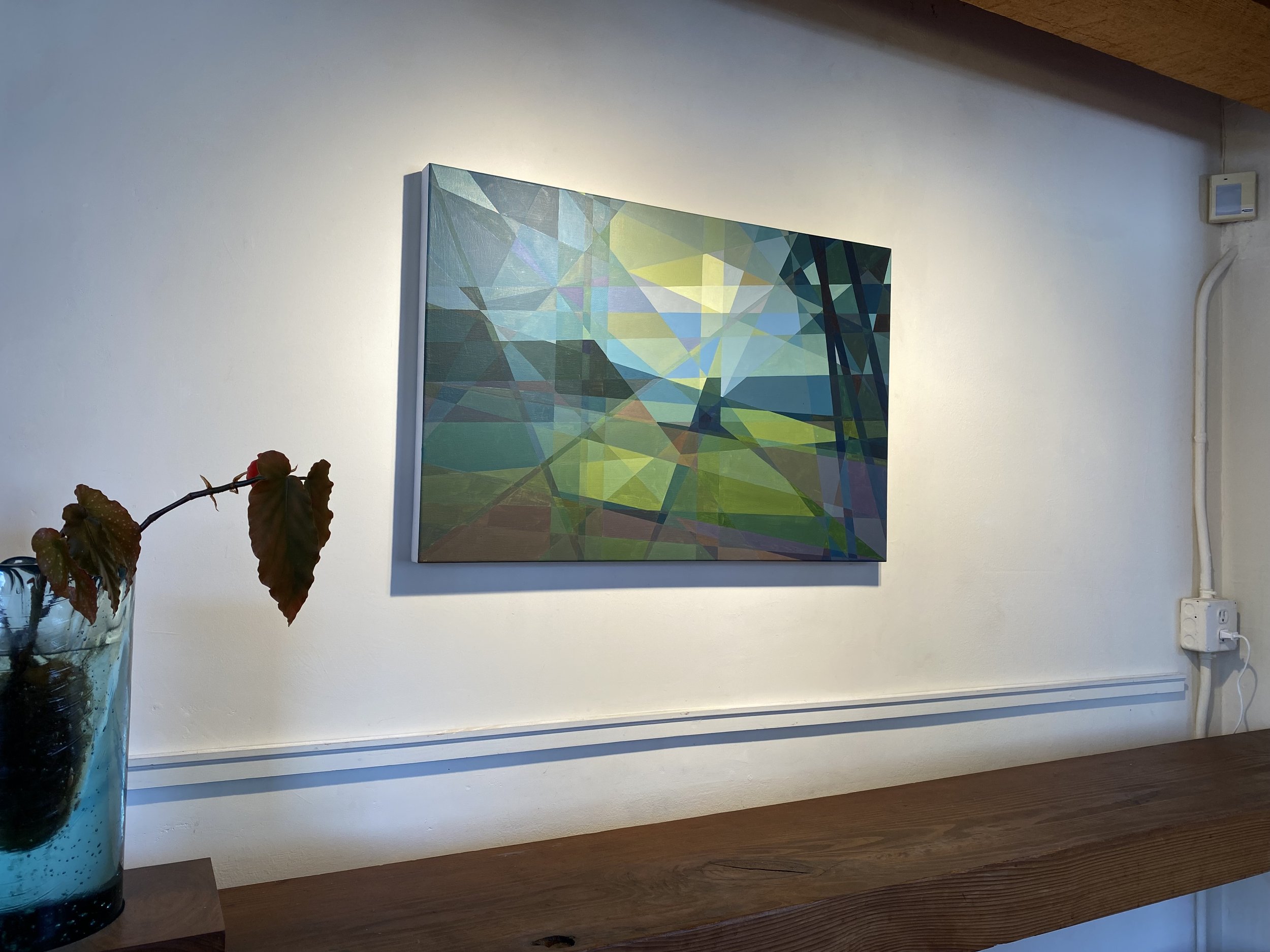
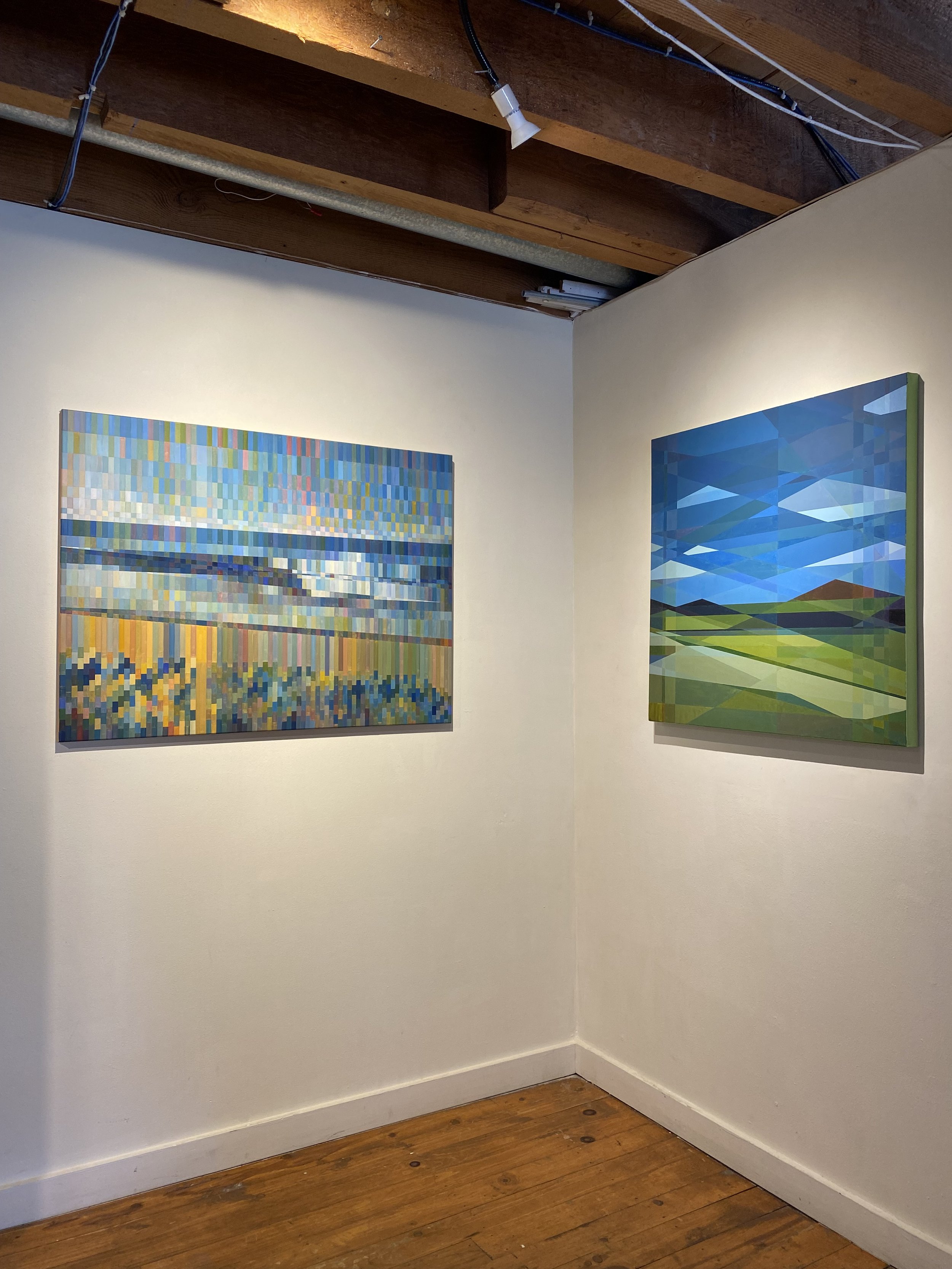
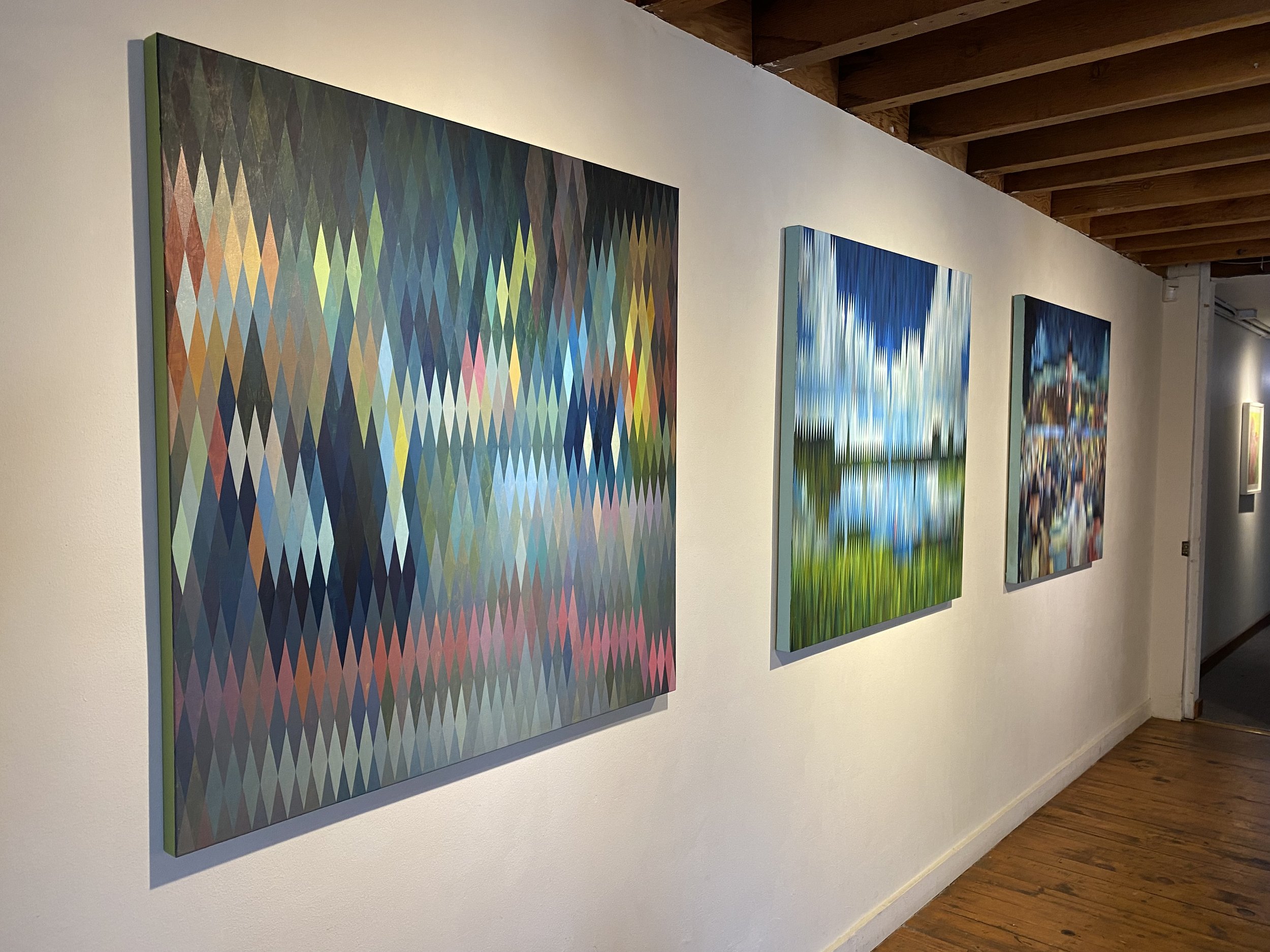
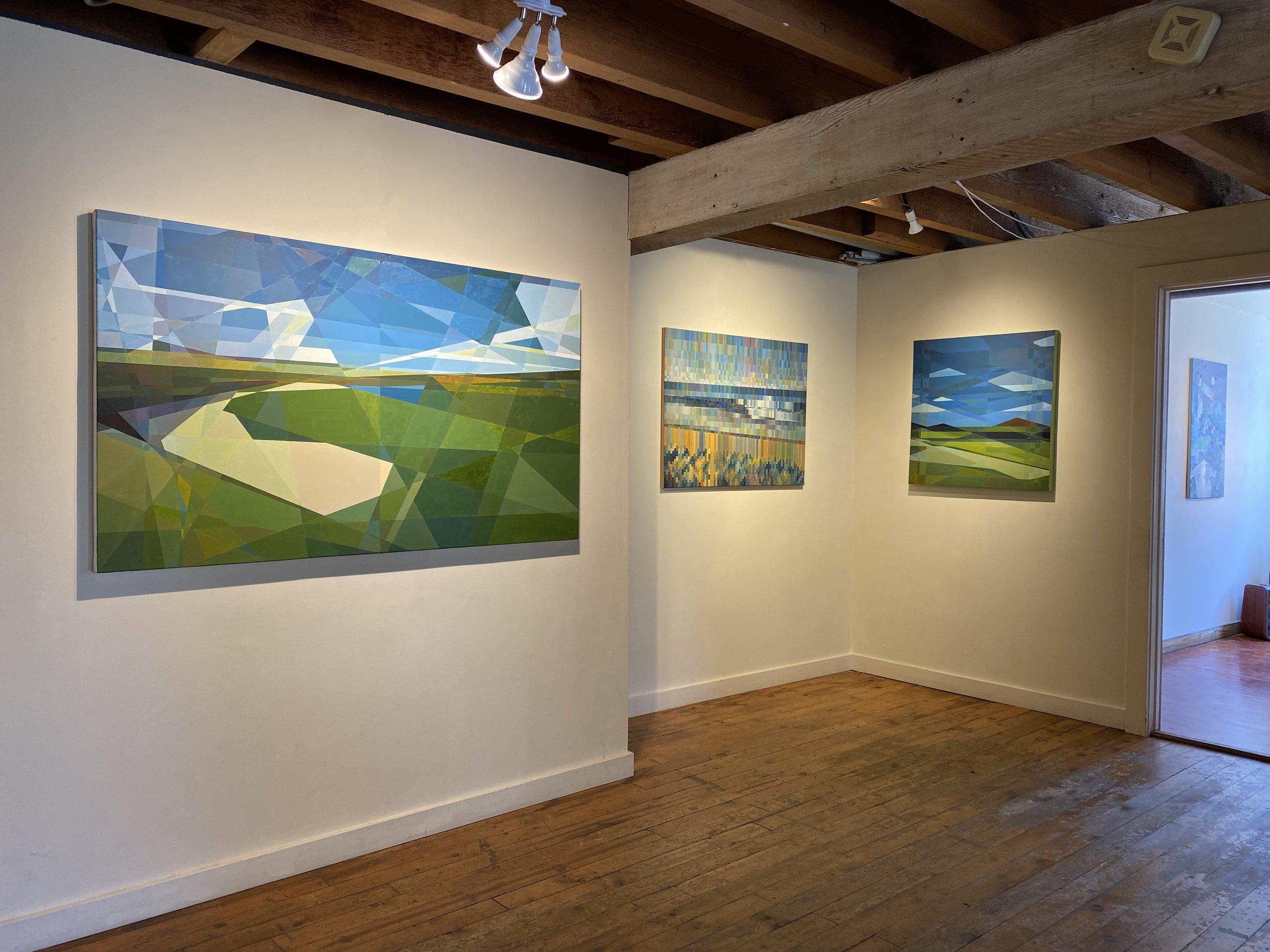
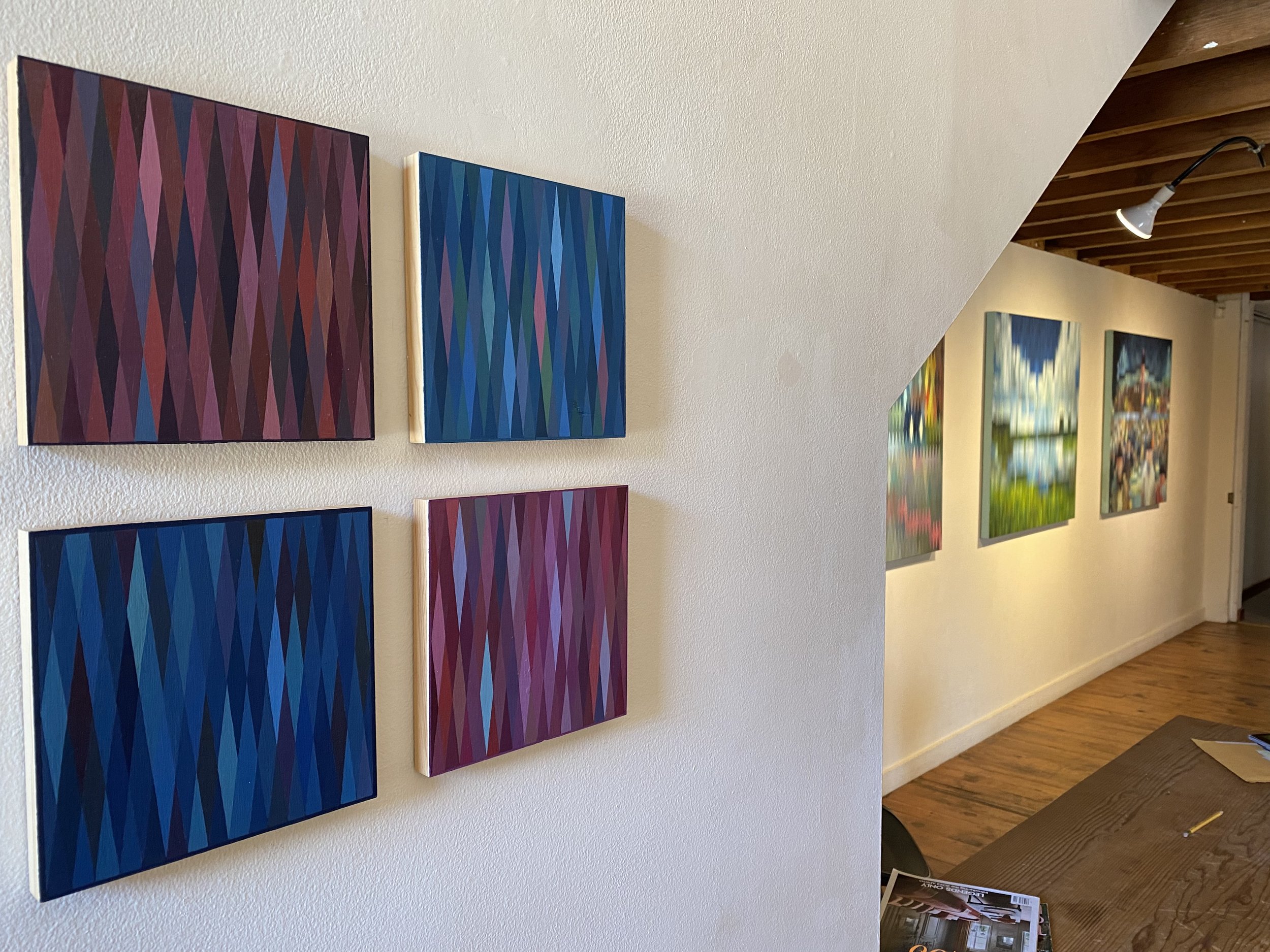
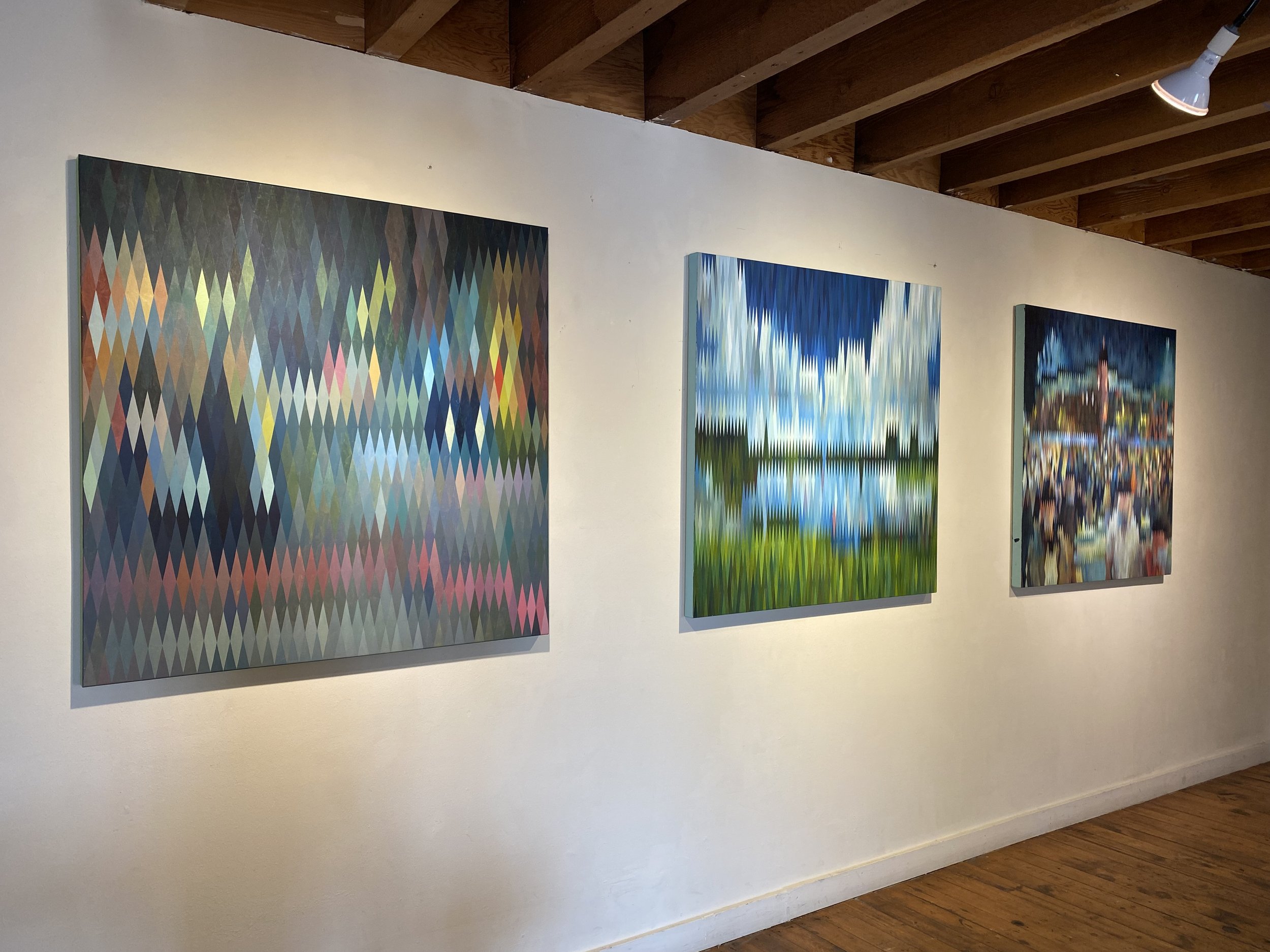
PROCESS, 2024, installation view © Courtesy Radian Gallery
PROCESS is Radian Gallery’s first solo show of Chen’s oil paintings. In PROCESS, Daniel Chen asks the viewer to consider both the artist’s technical and conceptual approach (his process), as well as the way they regard, internalize, and contextualize their own experience with his work (their process).
About Daniel Chen
Daniel Chen is a painter based in San Francisco, California, who spent his formative years between the SF Bay Area and Taiwan. Instead of pursuing a legal career after college, he chose to follow his true passion. Daniel holds degrees from the Academy of Art University and the California College of the Arts. Daniel's artistic practice revolves around the exploration of space, color, and memory. Using oil on canvas, he employs linear planes, pixels, and striking color shifts to create enigmatic landscapes and memories. His work draws significant inspiration from Impressionists and currently encompasses two series: 'Pixels' and 'Interiors and Exteriors.' Influenced by artists like Claude Monet, Francis Bacon, and David Choe, Daniel's work represents a unique fusion of diverse artistic elements. His first lessons in painting came from his maternal grandfather, a traditional calligraphy painter and art teacher. In addition, his mother, based in Kaohsiung, Taiwan, is also an oil painter.
About Radian Gallery
Radian is dedicated to showing California contemporary art. Located in San Francisco’s SoMa District, the gallery, under Founding Director Tony Wessling, a University of Michigan School of Art graduate and successful creative agency entrepreneur, has been steadily building a folio of highly talented rising artists whose work engages viewers with the combination of technical skill and conceptual exploration that is the hallmark of the Golden State’s ethos. “Radian” is the mathematical term for the angle that underpins an arc, and Radian, the gallery, aims to provide California artists with an angle of approach to the broader contemporary art conversation that underpins an upward arc of their career.
Please visit our website here or our Instagram here. For more information about Daniel’s artwork please visit his site here, and you can also find him on Instagram here. His interview with the magazine can be found here also.
Christina Kent: CAPTURE








San Francisco, CA - Radian Gallery is pleased to present “CAPTURE,” the atmospheric and introspective landscape paintings of California artist Christina Kent. The show is opened on June 24th and will on view through August 31st 2024, there was an opening reception on August the 1st from 5:00pm - 7:30pm.
Fog on Haight Street 40x30, Oil on Canvas
CAPTURE is Radian Gallery’s first solo show of Kent’s oil paintings. Throughout CAPTURE, Christina collects ephemeral slivers of the sublime created by the infinite permutations of light upon cityscapes and landscapes, channeling them through the brush and palette knife onto her deeply evocative canvases. Observing the shifts of light and color throughout the year, Kent’s impressionistic and atmospheric paintings highlight the bittersweet nature of fleeting moments.
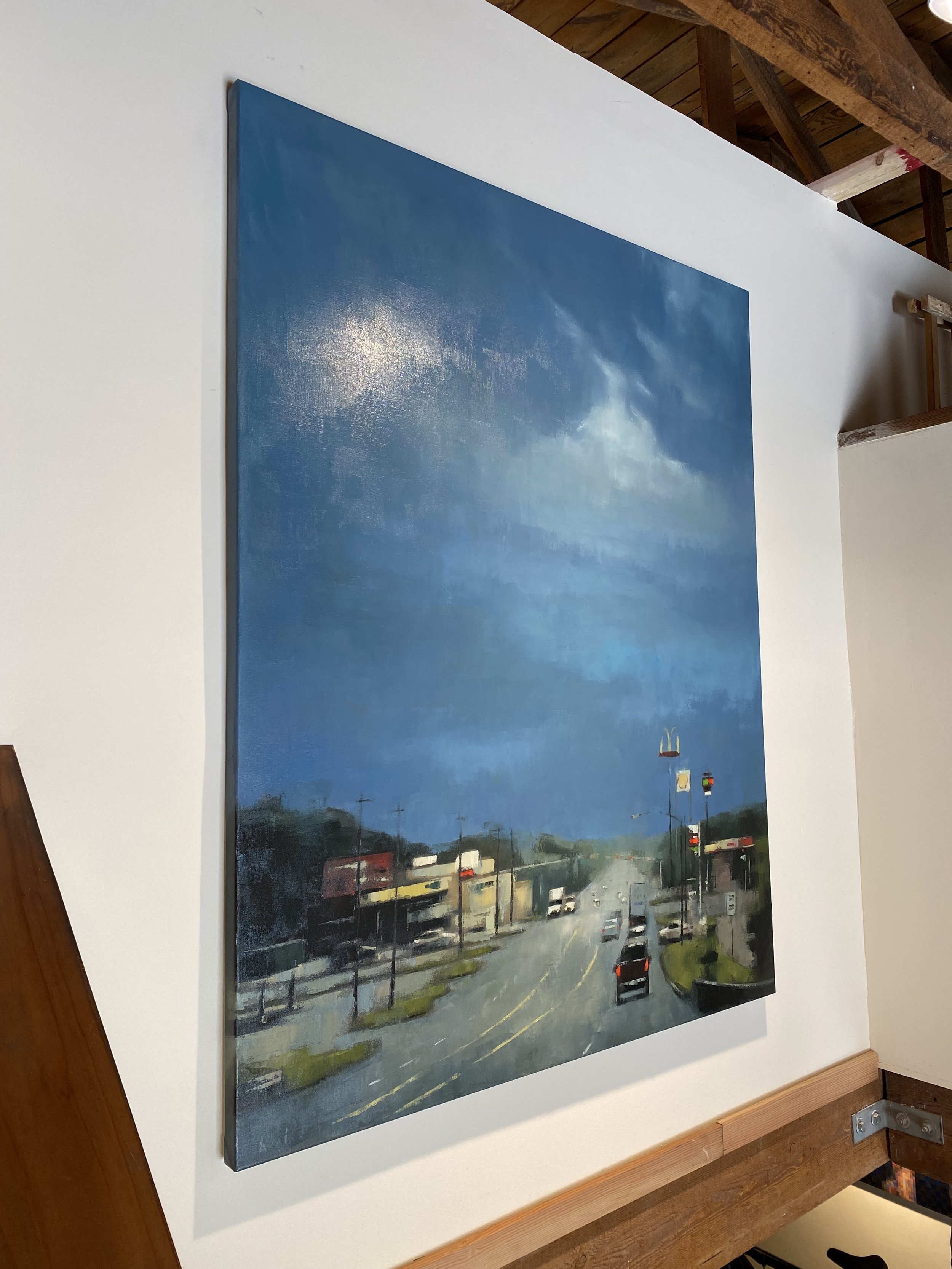
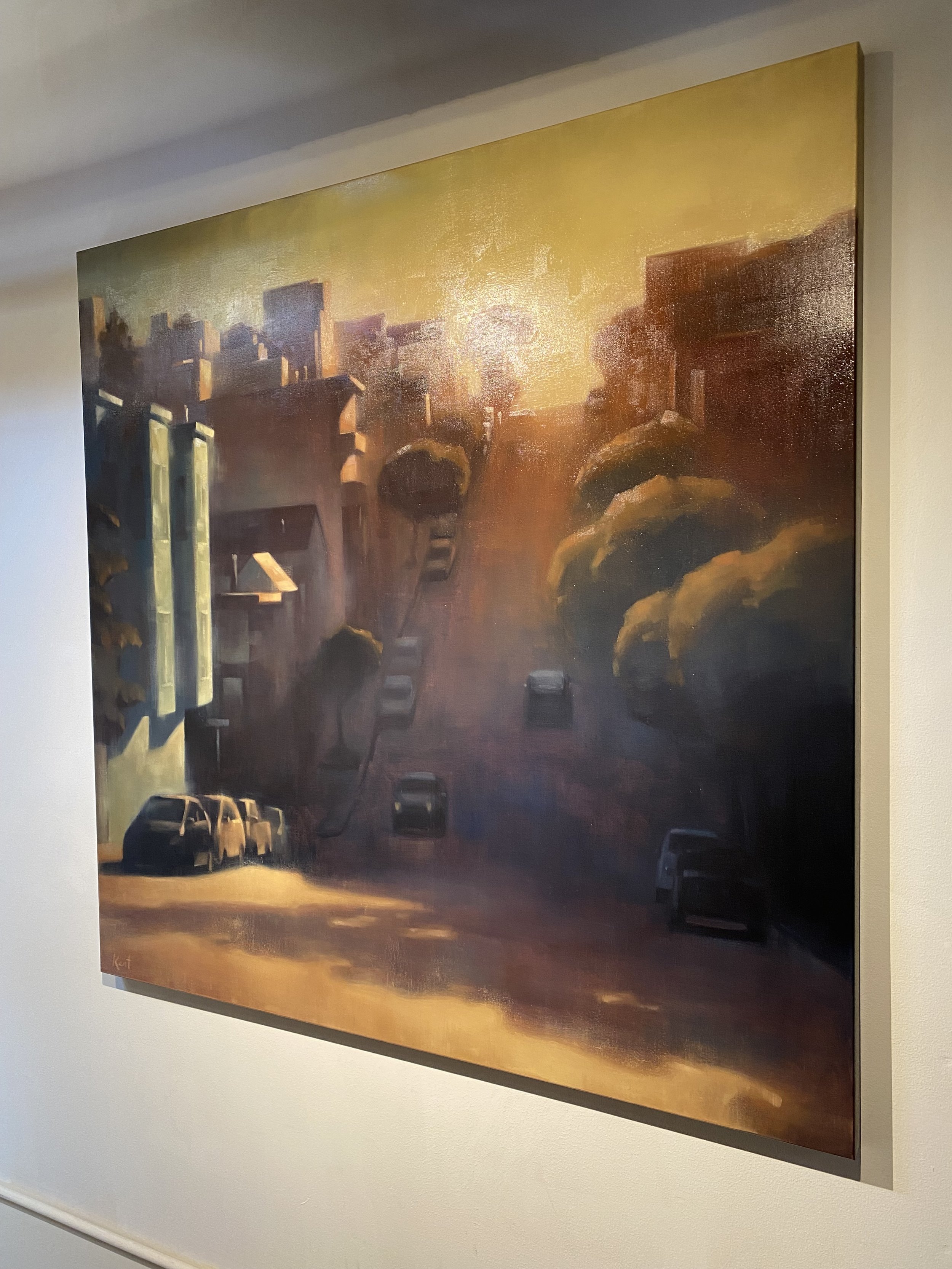

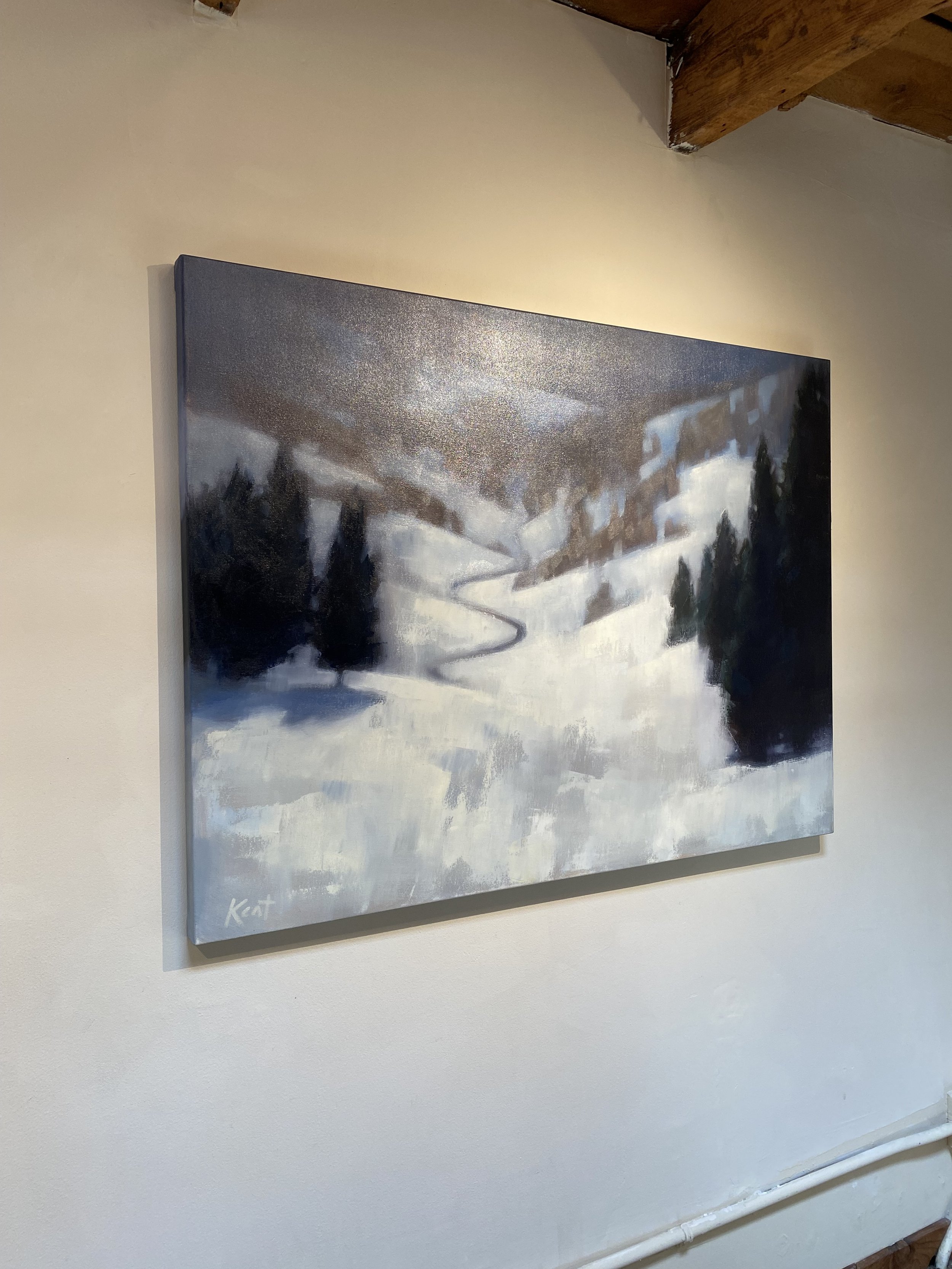


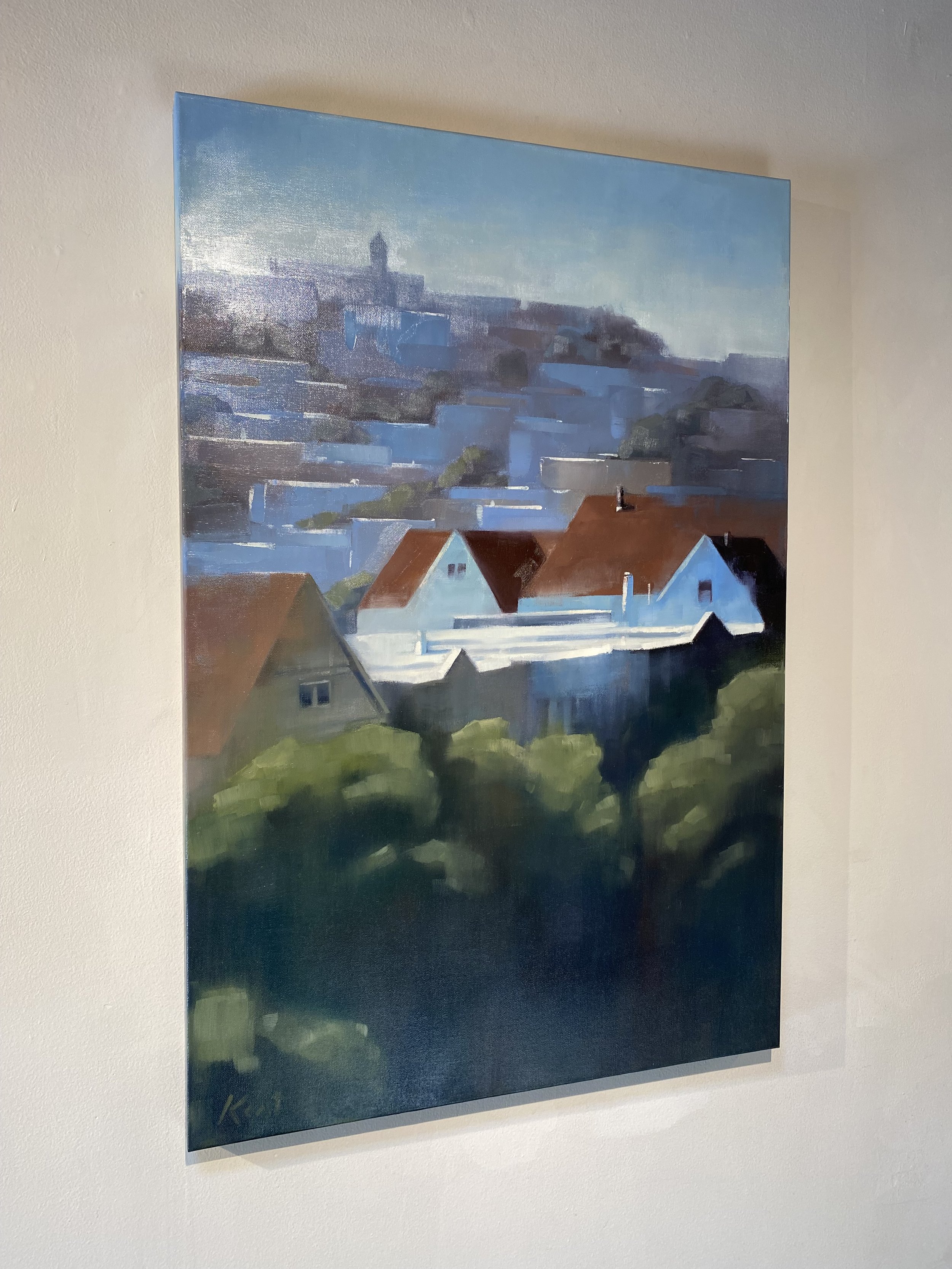
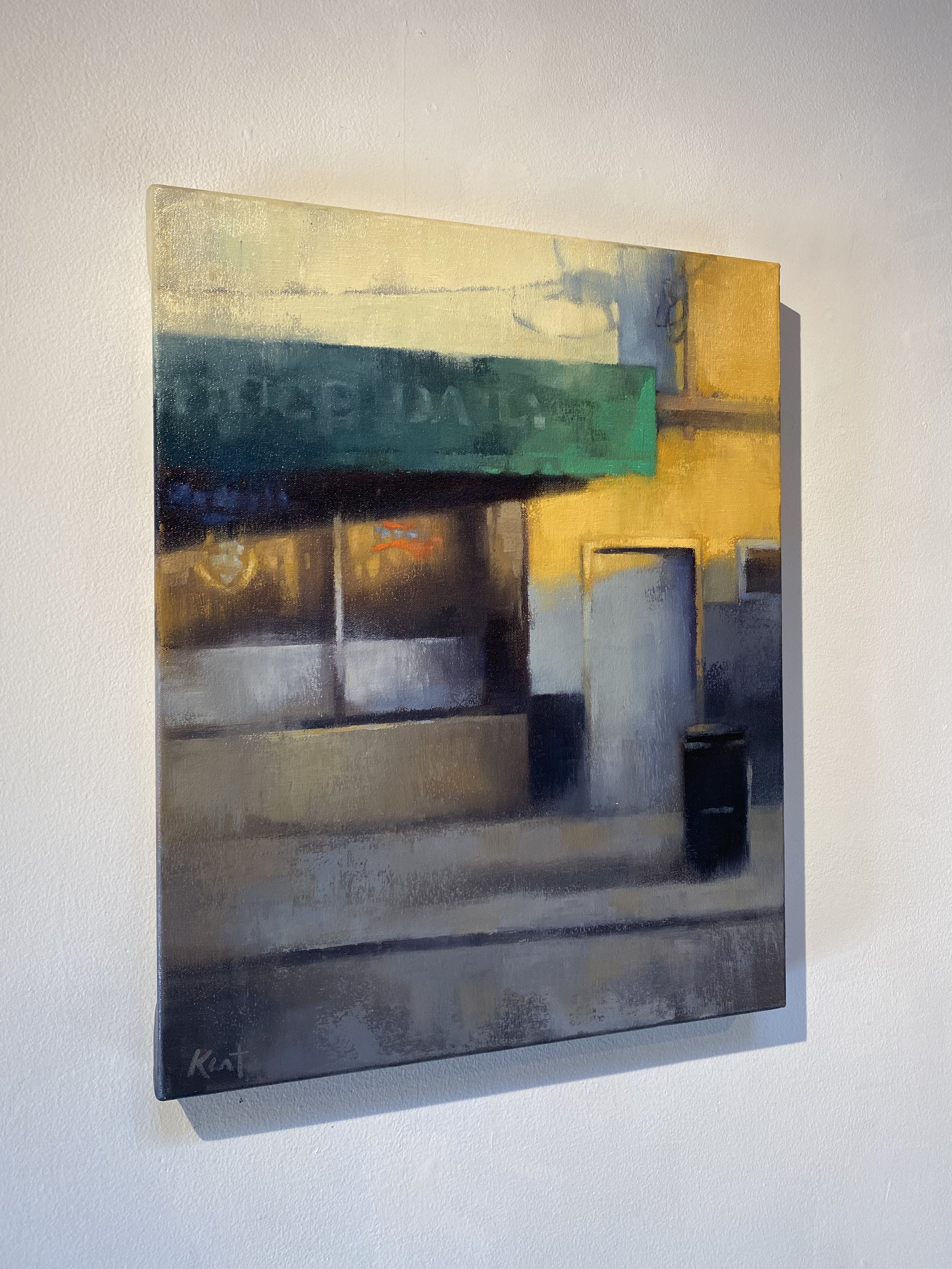
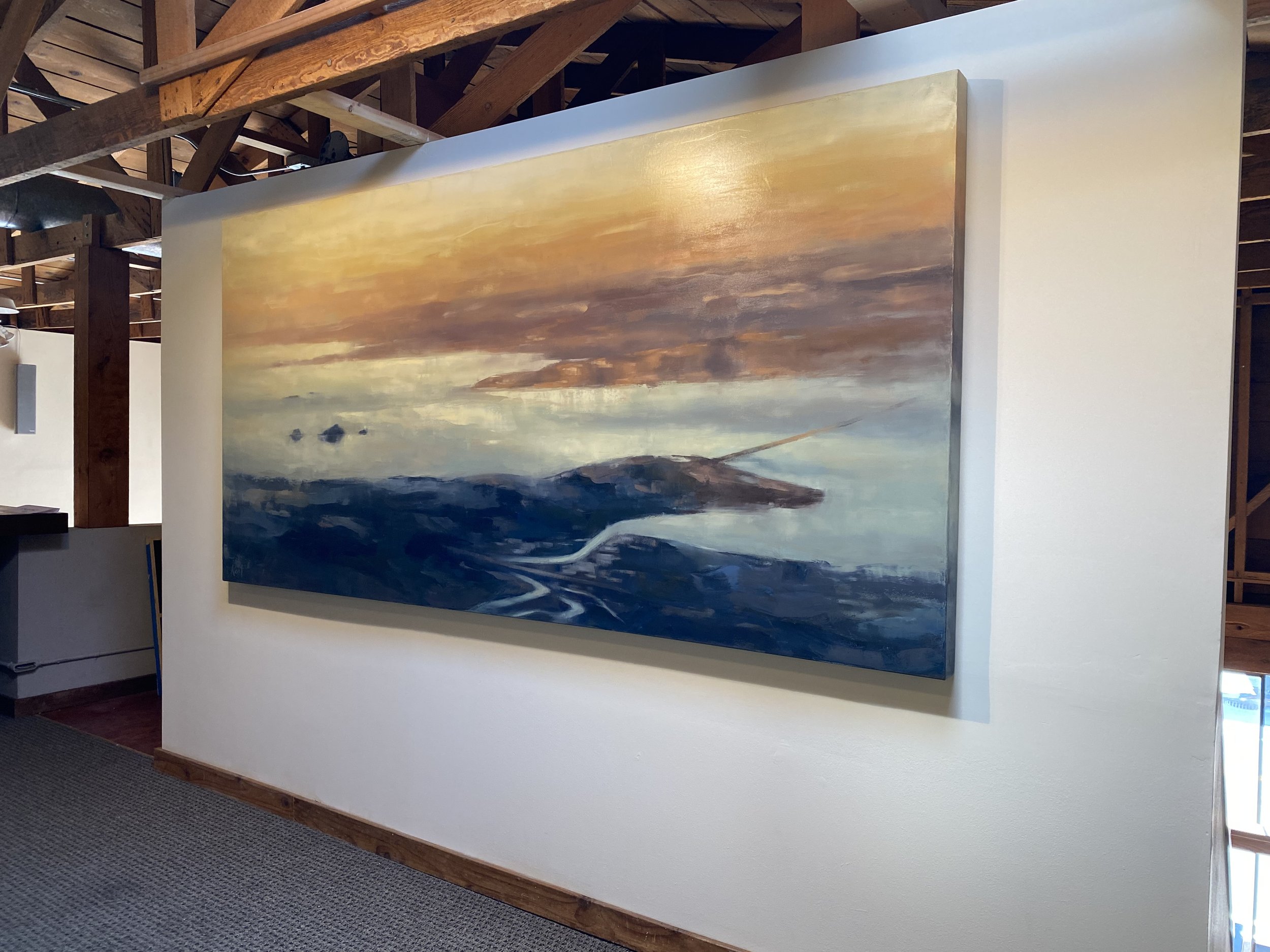
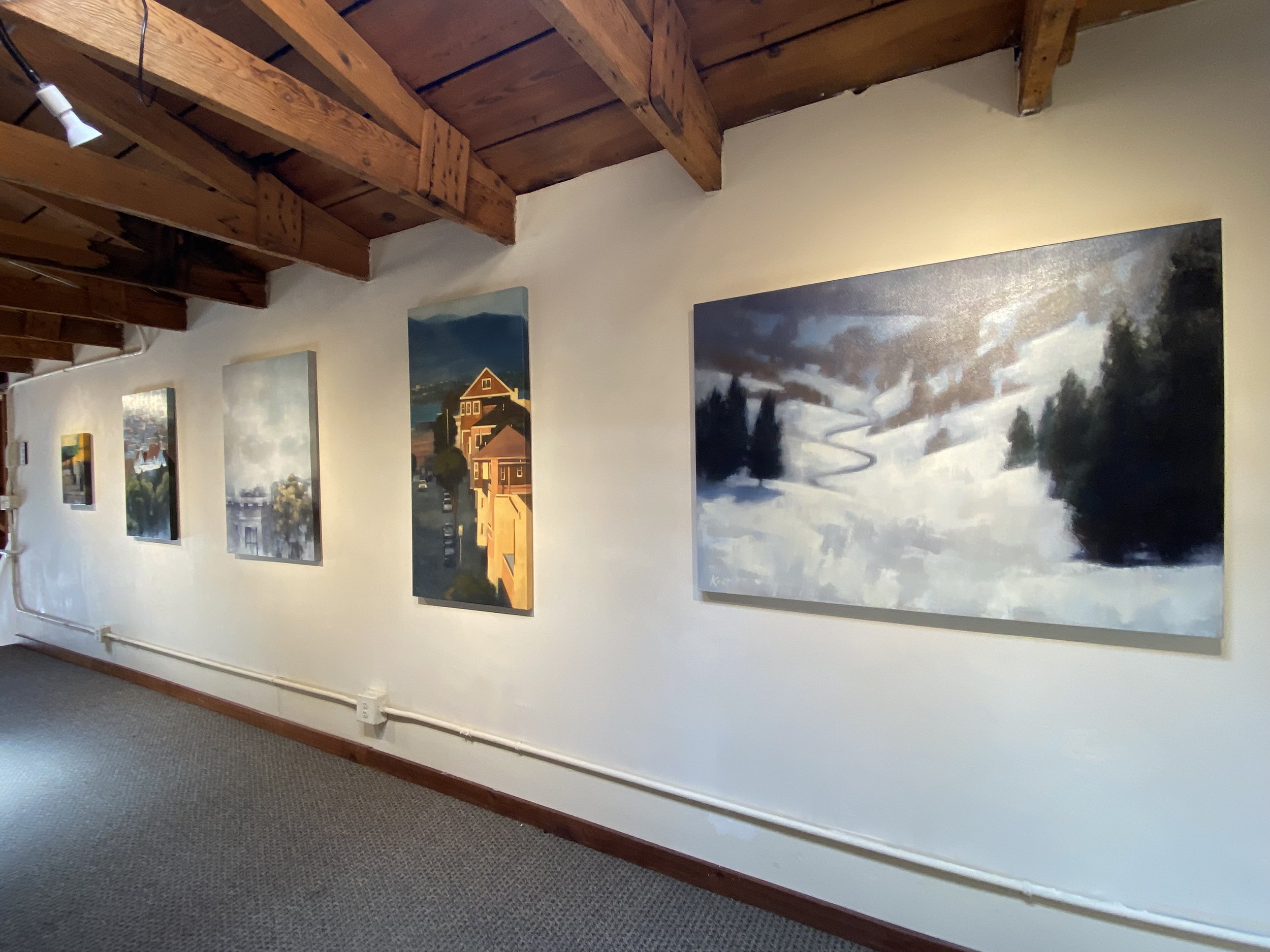
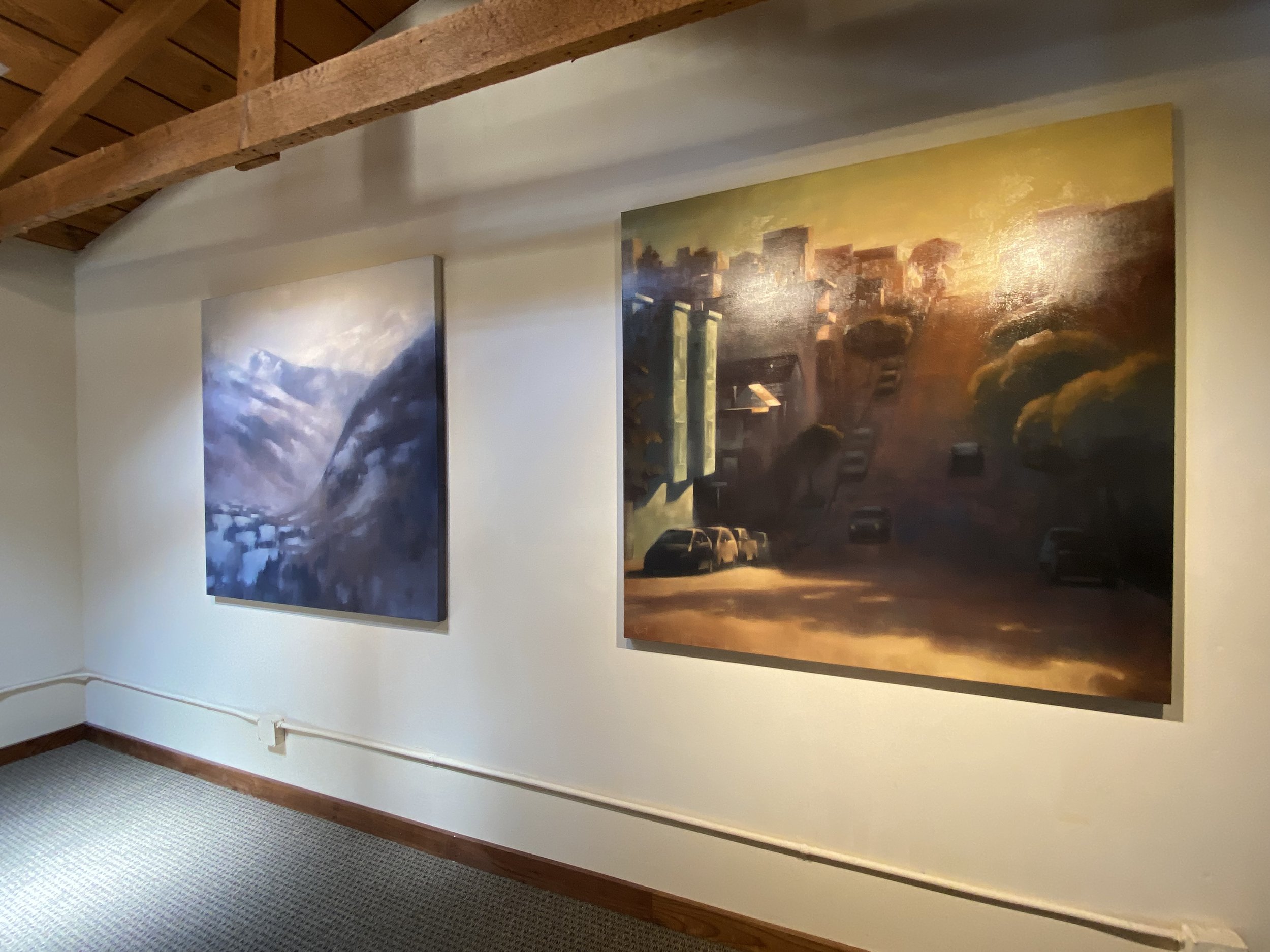
Installation Views: Capture, 440 Brannan Street San Francisco, CA 94107 June 24 through August 31, 2024, Photography courtesy Radian Gallery
About Christina Kent
A former PhD economist, Kent’s transition to painting was catalyzed by a realization that the rational economic lens was insufficient to capture the profound complexity inherent in human experience. Through her paintings, she reflects on the subtle nuances hidden in mundane moments of everyday life.
Texas Storm 60x48 Oil on Canvas
About Radian Gallery
Radian is dedicated to showing California contemporary art. Located in San Francisco’s SoMa District, the gallery, under Founding Director Tony Wessling, a University of Michigan School of Art graduate and successful creative agency entrepreneur, has been steadily building a folio of highly talented rising artists whose work engages viewers with the combination of technical skill and conceptual exploration that is the hallmark of the Golden State’s ethos. “Radian” is the mathematical term for the angle that underpins an arc, and Radian, the gallery, aims to provide California artists with an angle of approach to the broader contemporary art conversation that underpins an upward arc of their career.
Please visit our website here or our Instagram here. For more information about Christina’s artwork please visit her site here, and also you can find her on Instagram here.
The Art of the Olympics
The Art of the Olympics, 2024, installation view © Marc Newson; © Andreas Gursky, VG Bild-Kunst, Bonn, Germany Photo: Thomas Lannes Courtesy Gagosian
“Art enlightens the intelligence, captivates thought, and incites ambition. —”
PARIS,—Gagosian is pleased to announce The Art of the Olympics, a two-part group exhibition organized in association with the Olympic Museum to celebrate the Olympic and Paralympic Games Paris 2024.
The Art of the Olympics, 2024, installation view © Nam June Paik Estate Photo: Thomas Lannes Courtesy Gagosian
The gallery at rue de Castiglione features artworks in various mediums that explore sport’s rich cultural, iconographic, social, and emotional tapestry. Among the selections is Andreas Gursky’s monumental photograph Amsterdam, Arena I (2000), which presents a panoramic aerial view of a football match, reducing the uniformed players and manicured turf to an abstract composition of line and color. Man Ray’s similarly playful Jeux Nocturnes (c. 1970) infuses the soccer ball itself with a spirit of mystery that suggests a hidden dynamic, while Duane Hanson’s polychrome bronze sculpture Bodybuilder (1989–90) portrays an unnamed muscular, shirtless man encountered by the artist at a gym in Hollywood, Florida; the subject’s skin is sheened with sweat and his expression conveys a state of deep self-immersion. Jonas Wood’s Scholl Canyon (2005) transforms the serene landscape of a sprawling golf course into a multilayered abstract composition and Christo’s drawing for Running Fence (1974), a 39.4-kilometer public sculpture, communicates a sense of shared exhilaration akin to a marathon in its nurturing of cultural exchange and unity. The repurposing of fabric used in the artist’s Arc de Triomphe, Wrapped (1961–2021) in tents for the Paris Olympic Games extends his enduring legacy. A further selection includes works by Keith Haring, Takashi Murakami, Marc Newson, Ed Ruscha, Andy Warhol, and others.
Marc Newson Black Surfboard, 2017 Aluminum 72 7/8 x 16 3/8 x 5 3/4 inches (185 x 41.5 x 14.5 cm) Edition of 3 + 2 AP © Marc Newson Photo: Rob McKeever Courtesy Gagosian
The second-floor gallery at rue de Ponthieu features a selection of posters drawn from the Olympic Museum’s collection, which were designed by internationally renowned artists to promote and commemorate previous editions of the Olympic Games. Among the highlights are David Hockney’s summery design for the 1972 Games in Munich, which features an image of an athlete diving into
the undulating blue-and-green waters of a swimming pool; Robert Rauschenberg’s Star in Motion (1982), a fragmented photographic collage selected as the official poster for the 1984 Summer Olympic Games in Los Angeles; Cy Twombly’s poster for the 1984 Winter Olympics in Sarajevo, which draws on the ancient origins of the games in a characteristic scrawl; and Rachel Whiteread’s playful abstract interpretation of the Olympic Games London 2012, which comprises a constellation of overlapping rings of bright colored paint. Other artists represented by specially commissioned graphics include Christo, Michael Craig-Martin, Tracey Emin, Howard Hodgkin, Roy Lichtenstein, Henry Moore, Nam June Paik, Park Seo-Bo, Pablo Picasso, James Rosenquist, Pierre Soulages, Andy Warhol, and Zao Wou-Ki. On view alongside the posters is an array of infrequently exhibited items of correspondence and other artifacts closely related to previous editions of the Olympic Games.
The Art of the Olympics, 2024, installation view © The Estate of Howard Hodgkin. All rights reserved, DACS/Artimage 2024; © Tracey Emin. All rights reserved / Adagp, Paris, 2024; © Michael Craig-Martin; © Rachel Whiteread Photo: Thomas Lannes Courtesy Gagosian
Together, the two parts of The Art of the Olympics celebrate the dynamic interplay between art and sport, fostering a vibrant dialogue that continually rejuvenates and enriches both realms. This exhibition, which pays tribute to the cultural significance of sport in contemporary society, continues a gallery tradition, established in 2019 with An Exhibition for Notre-Dame at rue de Ponthieu, of responding directly to key events in the city.
The Art of the Olympics, 2024, installation view © Keith Haring Foundation Photo: Thomas Lannes Courtesy Gagosian
The display at rue de Castiglione will be visible from the street twenty-four hours a day, while the whole exhibition will remain open to visitors for an extended period through the summer during the Olympic and Paralympic Games.
A portion of proceeds from sales will be donated to the Olympic Refuge Foundation, a nongovernmental organization founded in September 2017 by the International Olympic Committee and based in Lausanne, Switzerland. The foundation’s primary stated goals are to support the protection, development, and thriving of displaced young people worldwide, through sport.
Andreas Gursky Amsterdam, Arena I, 2000 (detail) Diasec-mounted chromogenic print, in artist's frame Framed: 109 1/8 x 81 1/2 x 2 1/2 inches (277 x 207 x 6.2 cm) Edition of 6 © Andreas Gursky, VG Bild-Kunst, Bonn, Germany Courtesy Gagosian
About the Olympic Museum
Located in the Olympic Capital of Lausanne, Switzerland, the Olympic Museum is the official home of the world’s largest and most comprehensive collection of Olympic heritage, including artifacts, archives, images, books, and film. The museum’s international exhibitions and programs connect people of all ages with the diverse stories, art, history, and culture of the global phenomenon that is the Olympic Games. Through educational initiatives inspired by peace, solidarity, and the Olympic values of respect, friendship, and excellence, the Olympic Museum brings together athletes, visitors, students, artists, and an affiliated network of museums across the world. For more information, please visit olympics.com.
Robert Rauschenberg Robert Rauschenberg’s poster for the 1984 Los Angeles Summer Olympics, featuring "Star in Motion" (1982)
Offset-printed poster 24 1/4 x 35 7/8 inches (61.5 x 91 cm), Olympic Museum Collections, Lausanne, Switzerland © Robert Rauschenberg Foundation / Adagp, Paris, 2024 Photo: © International Olympic Committee. All rights reserved. Courtesy Olympic Museum, Lausanne, Switzerland
THE ART OF THE OLYMPICS
In association with the Olympic Museum
The exhibition opened on June 6 and will be on view until September 7, 2024*
9 rue de Castiglione and 4 rue de Ponthieu, Paris
* Both galleries will be closed from Saturday, August 10, through Monday, August 26.
The Art of the Olympics, 2024, installation view © Ed Ruscha; © Man Ray 2015 Trust / Adagp, Paris 2024; © Jonas Wood Photo: Thomas Lannes Courtesy Gagosian
For more information about this exhibition and others presented by Gagosian please visit the gallery’s site here. The gallery can also be found on Pinterest, X, YouTube, Facebook, Instagram, and Artsy. For more information about the Olympic Museum, please visit their site here, and also on Instagram, Facebook, and Youtube.
“Don’t we touch each other just to prove we are still here?”: Photography and Touch
“Don’t we touch each other just to prove we are still here?”: Photography and Touch, 2024. Courtesy of the Princeton University Art Museum. Photo by: Joseph Hu.
PRINCETON, NJ – “Don’t we touch each other just to prove we are still here?”: Photography and Touch, opened on May 11 at the Princeton University Art Museum’s Art at the Hulfish gallery it will be on view until August 4, 2024, and it will explore the role that physical touch plays in our lives and how it is represented in the work of contemporary photographers.
Originally conceived in the depths of the COVID-19 pandemic, when lockdowns and other restrictions led to widespread feelings of isolation and loneliness, the exhibition is devoted to the ways in which lens-based artists have represented touch—the embodiment of connection. The exhibition includes works by the artists Lisa Sorgini, Clifford Prince King, Katrine de Blauwer, Richard Renaldi, Odette England, and Tabitha Soren, among others.
Richard Renaldi(born 1968, Chicago, IL; activeNewYork, NY), Touching Strangers - Chris and Amaira, IL, 2013. Inkjet print; 127 × 152.4 cm. Collection of the artist © Richard Renaldi
While exploring this subject, guest curators Susannah Baker-Smith and Susan Bright became interested in the relationship between touch and the medium of photography. The exhibition proposes that this connection is both inclusive—spanning all possible kinds of relationships— and diverse—relevant to many different approaches and lens-based processes. As such, Photography and Touch includes photographs and snapshots, videos, artist books, fine art prints, and works made for Instagram.
Core themes explored in the exhibition include materiality, affect, embodiment, collaboration, and how the medium of photography can explore touch as a broader sensory and material experience. The exhibition takes its title from Ocean Vuong’s poem “On Earth We’re Briefly Gorgeous,” which also explores themes of touch and intimacy.


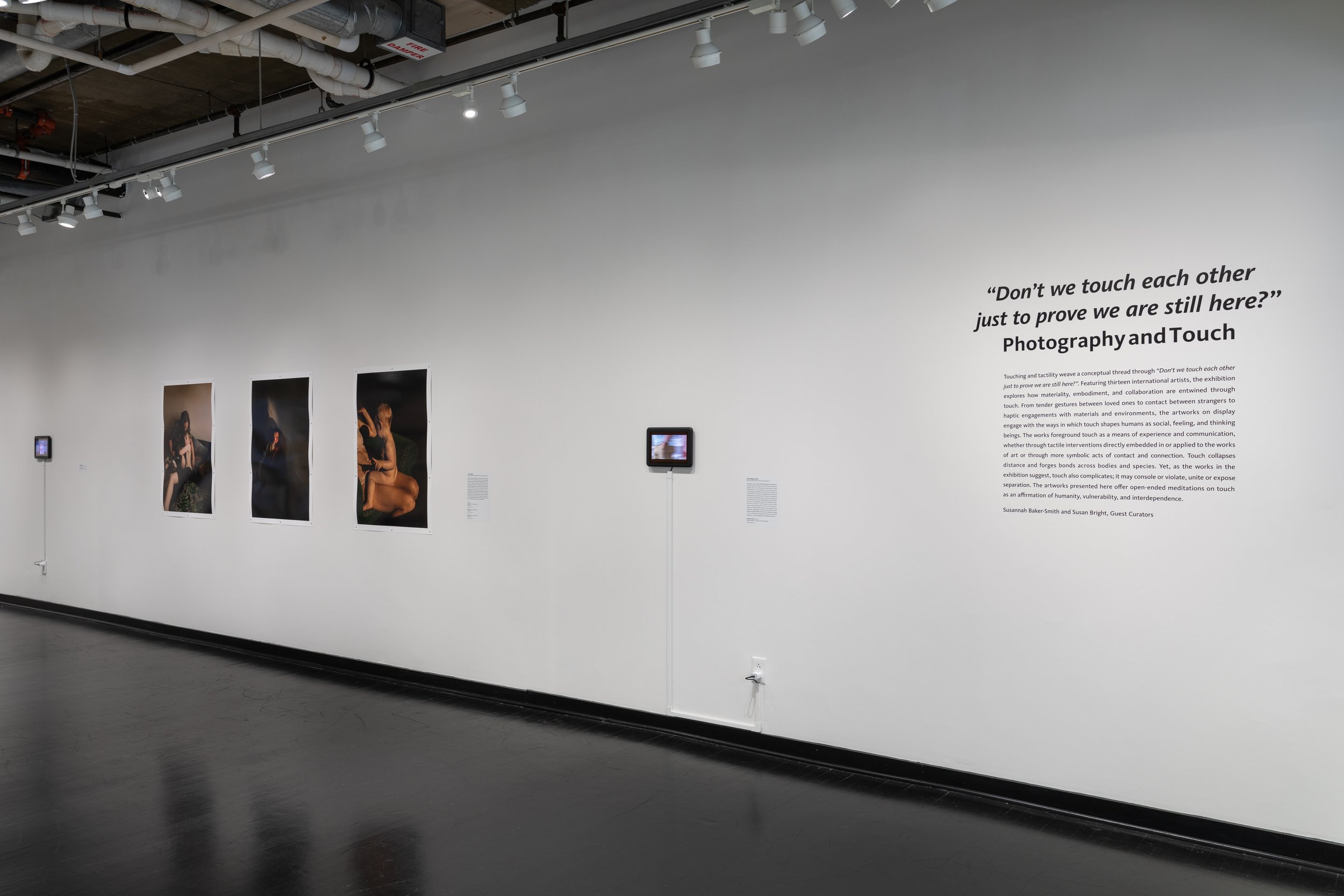























“Don’t we touch each other just to prove we are still here?”: Photography and Touch, 2024. Courtesy of the Princeton University Art Museum. Photo by: Joseph Hu.
“Photography, perhaps more than any other medium, is primed as a way for artists to focus on relationships,” Baker-Smith and Bright said. “To view images about touch encourages the untold stories that gesture can evoke and considers what exactly touch is, who can experience it, and who can’t. Touch is a mutual tool for social connection, a way to communicate, and our means of feeling embodied.”
Among the works in the exhibition are photographs by Lisa Sorigni depicting mothers and children that show the deep emotional bonds forged by touch; works by Clifford Prince King exploring how touch is a vehicle for connection and affirmation; images by Patrick Pound of people with their beloved pets; and a work by Richard Renaldi depicting strangers embracing one another, raising questions about when and where intimacy flourishes.
Lisa Sorgini (born 1980, Adelaide, Australia; active New South Wales), Mother, 2016–2022, printed 2024. Inkjet print; 101.6 × 69.8 cm. Collection of the artist © Lisa Sorgini
“Photography and Touch is both a moving study of the role touch plays in our relationships and a fascinating path of inquiry into how the physical act of touch can transform the photographic medium,” said Juliana Ochs Dweck, chief curator of the Princeton University Art Museum.
“Don’t we touch each other just to prove we are still here?”: Photography and Touch, 2024. Courtesy of the Princeton University Art Museum. Photo by: Joseph Hu.
Photography and Touch is cocurated by Susan Bright, an independent curator who has organized exhibitions at Tate Britain, the National Portrait Gallery, London, and Galleria Nazionale d'Arte Moderna, Rome; and Susannah Baker-Smith, a lens-based artist, curator, and practicing psychotherapist.
About Art@Bainbridge
Art@Bainbridge is made possible through the generous support of the Virginia and Bagley Wright, Class of 1946, Program Fund for Modern and Contemporary Art; the Kathleen C. Sherrerd Program Fund for American Art; Joshua R. Slocum, Class of 1998, and Sara Slocum; Rachelle Belfer Malkin, Class of 1986, and Anthony E. Malkin; Barbara and Gerald Essig; Gene Locks, Class of 1959, and Sueyun Locks; and Ivy Beth Lewis. Additional support for this exhibition is provided by the Africa World Initiative; the Program in African Studies; the Graduate School—Access, Diversity, and Inclusion; the Department of African American Studies; the Princeton African Humanities Colloquium; the Department of Music; and the Program in Linguistics.
Clifford Prince King (born 1993, Tucson, AZ; active New York, NY), Poster Boys, 2000. Inkjet print; 121.9 × 81.3 cm. Quite_Liberace Collection by Shawneil Campbell © Clifford Prince King / courtesy of the artist and STARS, Los Angeles
About the Princeton University Art Museum
With a collecting history that extends back to 1755, the Princeton University Art Museum is one of the leading university art museums in the country, featuring collections that have grown to include more than 115,000 works of art ranging from ancient to contemporary art and spanning the globe. Committed to advancing Princeton’s teaching and research missions, the Art Museum also serves as a gateway to the University for visitors from around the world.
The main Museum building is currently closed for the construction of a bold and welcoming new building, slated to open in 2025.
Art on Hulfish, a gallery project of the Art Museum located at 11 Hulfish Street, is open daily. Art@Bainbridge, a gallery project at 158 Nassau Street, is open Tuesday through Sunday. Admission to both galleries is free.
Please visit the Museum’s website for digital access to the collections, a diverse portfolio of programs, and details on visiting our downtown galleries here. The Museum Store in Palmer Square, located at 56 Nassau Street in downtown Princeton, is open daily, or shop online here.
The Museum can also be found on YouTube, Facebook and Instagram.
Camille Claudel : Retrospective
Visitors at the Camille Claudel exhibition at the Getty Center. Image courtesy of the J. Paul Getty Trust
LOS ANGELES — The J. Paul Getty Museum presents Camille Claudel, an exhibition showcasing nearly 60 sculptures by one of the most daring and visionary artists of the late 19th century. On view at the Getty Center from April 2 to July 21, 2024, the exhibition seeks to reevaluate Claudel’s work and affirm her legacy within a more complex genealogy of modernism.
A trailblazing artist working in France in the late 19th and early 20th centuries, Claudel defied the social expectations of her time to create forceful sculptures of the human form. Her innovative artworks treat the universal themes of childhood, old age, love, and loss with an expressive intensity in a variety of genres, materials, and scales.
Camille Claudel working on her Vertumnus and Pomona marble group, about 1903 Photo: Collection Gregoire / Bridgeman Images
“A pioneer for women artists of the time, in a short but extraordinary career, Claudel established herself as one of the most important sculptors of the late 19th and early 20th-century Europe,” says Timothy Potts, Maria Hummer-Tuttle and Robert Tuttle Director of the Getty Museum. “Revered in France, and now widely sought after by museums around the world, her deeply moving images of the human body are one of the high points of romantic sculpture in Europe, and I am sure will be greatly admired by our visitors and especially the artist community.”
Claudel’s career has often been interpreted through her dramatic personal life, which involved a complicated relationship with her mentor, Auguste Rodin, and mental health issues resulting in a 30-year confinement in a psychiatric institution. While French collectors and critics immediately recognized Claudel’s talent, her art remains little known outside of France.
Organized chronologically and thematically, the exhibition invites visitors to experience a diverse array of sculptures Claudel created during her career and many of the masterpieces that earned her much success.
Young Roman, 1882/1883–1887 Camille Claudel (French, 1864–1943) Painted plaster The Art Institute of Chicago, Through prior bequest of Joseph Winterbotham; purchased with funds provided by an anonymous donor, Anne Searle Bent, and Celia and David Hilliard, 2022.1438 EX.2024.1.14
“Claudel excelled at capturing the likeness of her subjects, depicting individuals at every stage of life with powerful emotion and empathy,” says Anne-Lise Desmas, senior curator of sculpture and decorative arts at the J. Paul Getty Museum. “The support and success she experienced with collectors, fellow artists, and journalists during a time when few women artists were widely regarded is testimony to her rare talent and ceaseless creativity.”






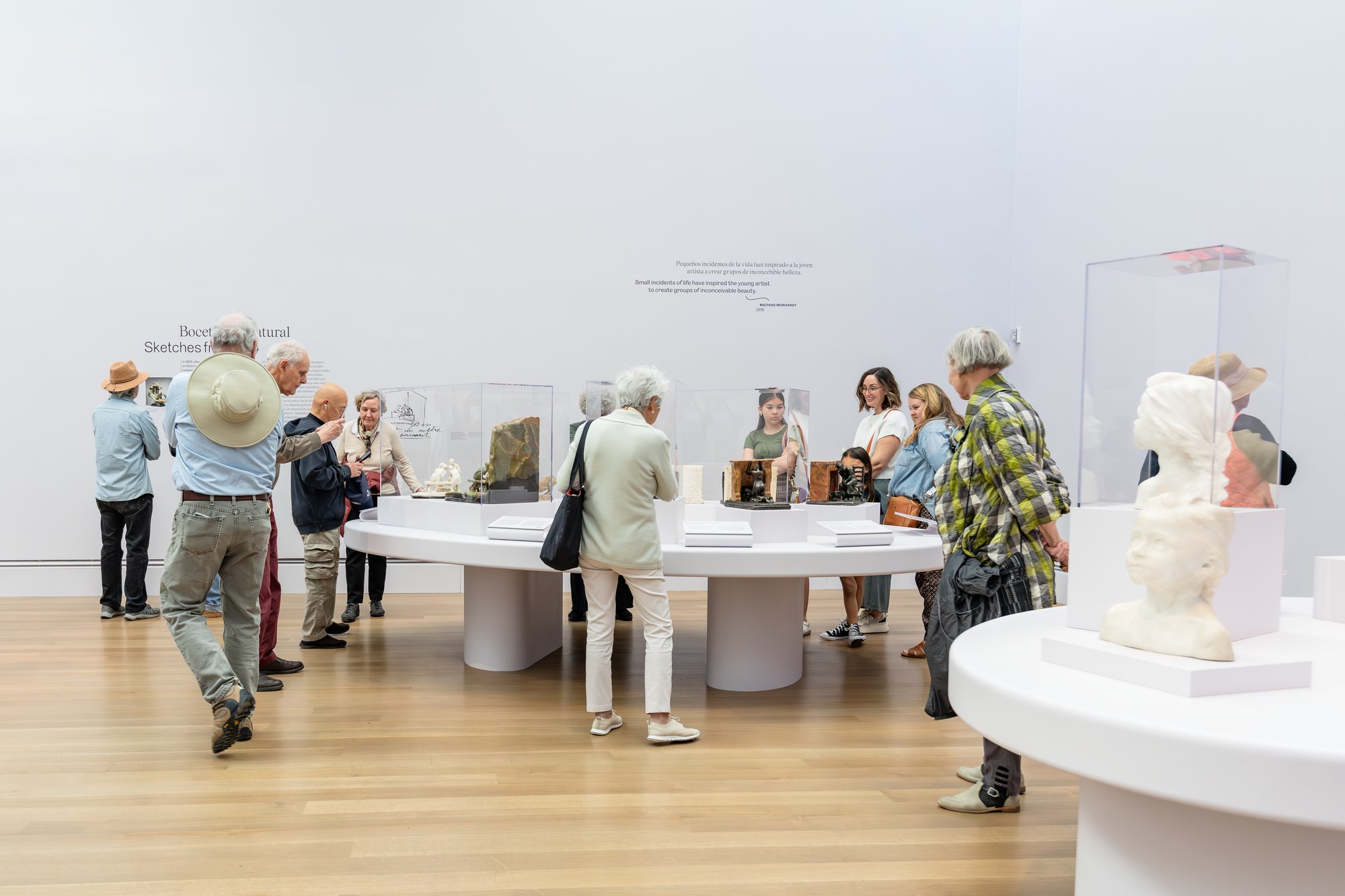

Visitors at the Camille Claudel exhibition at the Getty Center. Image courtesy of the J. Paul
Getty Trust
Claudel impressed critics with compositions that pushed the boundaries, such as The Waltz—a dynamic scene of two lovers surrendering to a dance. The first iteration Claudel created of the sculpture is on view—a unique bronze cast with complex, openwork draperies or “veils” swirling behind the figures. In response to demand from collectors, Claudel produced several inventive versions of the couple at a smaller scale, including a few bronzes which is on view to juxtapose their varied patina effects with brown, green, and gilded surfaces.
Another masterpiece in the exhibition is Age of Maturity, on loan from the Musée d’Orsay. One of her most ambitious sculptures, the three large figures depict life’s tragic journey with Old Age leading Middle Age forward, beyond the grasp of a kneeling, abandoned Youth. When it was exhibited, a critic declared, “We can no longer call Mademoiselle Claudel a student of Rodin; she is a rival.”
Crouching Woman, about 1884–1885 Camille Claudel (French, 1864–1943) Patinated plaster Musée Camille Claudel, Nogent-sur-SeinePhoto: Marco Illuminati EX.2024.1.10
When Claudel embarked on a series of compositions inspired by everyday life, she “created a new art,” as her biographer and art critic Mathias Morhardt noted with amazement. Smaller in scale and often featuring novel materials, these works focus on the intimacy, poetry, and humanity of lived experience. The most famous is The Chatterboxes, which depicts a group of nude women seated on benches, leaning forward to listen as one woman whispers a secret. The Musée Rodin version, rendered in green marble onyx, is reunited with another variation in white marble for the first time. Another compelling example is Fireside Dream, depicting an intimate scene of a woman sitting by a fireplace. Produced in marble and bronze, the sculpture was Claudel’s most reproduced composition: three versions is on display, including one conceived as a nightlight, with a red light bulb mimicking the fire.
In the last decade of her career, Claudel experienced physical, mental, and financial problems. However, she continued to participate in exhibitions, receive commissions, and create compelling works, including powerful Greek mythological scenes like Wounded Niobid and Perseus and the Gorgon. Commissioned by her patron Countess de Maigret, Claudel incorporated her own likeness in the face of Medusa for Perseus and the Gorgon.
Torso of a Crouching Woman, modeled about 1884–1885, cast about 1913 Camille Claudel (French, 1864–1943) Bronze Getty Museum 2018.32
Claudel later became the subject of numerous books, films, and exhibitions. Still, fewer than 10 of her sculptures reside in U.S. museums. Getty’s recently acquired Torso of a Crouching Woman is also on view, a work created during Claudel’s years in Rodin’s studio, highlighting the important role she played as collaborator and muse of the artist. Young Roman, acquired by the Art Institute of Chicago, is also displayed and is a great example of Claudel’s art of portraiture, a genre in which she excelled at a young age.
The exhibition features a hands-on touch experience with reproductions of one of the feet of the Torso of a Crouching Woman in various materials Claudel used in her practice. Additional components of the exhibition include murals of Claudel based on historic photographs and a video about the Musée Camille Claudel in Nogent-sur-Seine.
Vertumnus and Pomona, 1905 Camille Claudel (French, 1864–1943) Marble on a red marble plinth Musée Rodin, Paris Image © Musée Rodin, Photo: Christian Baraja EX.2024.1.32
Camille Claudel is co-curated by Anne-Lise Desmas, senior curator of sculpture and decorative arts at the Getty Museum, and Emerson Bowyer, Searle curator of painting and sculpture of Europe at the Art Institute of Chicago. The exhibition was first on view in Chicago from October 7, 2023 to February 19, 2024.
Complementing the exhibition is a catalogue co-authored by Desmas and Bowyer, with essays that explore the many facets of Claudel’s life and work, along with commentary by sculptor Kiki Smith. Getty hosted an opening day conversation at the Getty Center on April 2 at 2pm with co-curators Desmas and Bowyer, and Musée Camille Claudel director, Cécile Bertran.
The Getty Museum partnered with The Culture List, Inc. to present two immersive six-week art classes for aging seniors at Annenberg GenSpace in Koreatown. Which was led by teaching artist Silvi Naci from the Feminist Center for Creative Work; students considered form, materiality, and the human body in transformation, movement, and gesture through hands-on activities.
At Getty, the exhibition is generously supported by Anissa and Paul John Balson II in honor of Dr. Paul M. Balson, along with City National Bank.
For more information about this exhibition and others at the Getty, please see their site here. The Getty can also be found on Instagram, X, Facebook, and TikTok.
Gordon Parks
Gordon Parks, Mr. and Mrs. Albert Thornton, Mobile, Alabama, 1956 PHOTO archival pigment print 50"×50"(127cm×127cm), paper No. 91533.02 ©The Gordon Parks Foundation, courtesy Pace Gallery
Los Angeles – Pace is pleased to present an exhibition of work by Gordon Parks at its Los Angeles gallery, which opened on July 12 and will be on view until August 30. This show—organized by Pace’s Curatorial Director Kimberly Drew—marks the gallery’s first solo presentation of the artist’s work as part of its ongoing partnership with the Gordon Parks Foundation. The exhibition will be complemented by a guided meditation event at the gallery led by teacher, writer, and speaker Manoj Dias from 12 to 1 p.m. on July 13 and a celebratory public opening from 6 to 8 p.m. that evening.
A photographer, filmmaker, composer, and writer, Parks was one of the most influential artists of the 20th century, describing himself as “an objective reporter with a subjective heart.” Born in segregated Fort Scott, Kansas in 1912, he was first drawn to photography as a young man when he encountered magazine images of migrant workers produced by the Farm Security Administration (FSA). Though he never received formal photographic training, he would go on to create a body of work documenting American society and culture from the 1940s to the 2000s, focusing in on race relations, poverty, civil rights, and urban life.
“I saw that the camera could be a weapon against poverty, against racism, against all sorts of social wrongs,” Parks once said. “I knew at that point I had to have a camera.”
Gordon Parks 1201 South La Brea Avenue, Los Angeles, CA 90019 July 12–August 30, 2024 Photography courtesy Pace Gallery
Following his early work with government agencies—including the FSA and the Office of War Information (OWI)— and the Standard Oil Company, he became the first Black staff photographer for Life magazine in the late 1940s. Covering social issues, fashion, entertainment, and sports, Parks captured iconic images of Muhammad Ali, Malcolm X, Duke Ellington, Adam Clayton Powell, Jr., Stokely Carmichael, and others during his two decades at the publication.
The first exhibition dedicated to Parks’s work to be mounted in LA since a 2019 presentation of his Flávio da Silva series at the Getty, Pace’s upcoming show will bring together some 40 photographs spanning four decades of his career, from the early 1940s to the mid 1980s. Organized thematically, these works reflect the empathy and care with which he approached image making and storytelling, creating nuanced, intimate portraits of his subjects’ interior lives and their private spaces as part of that practice.







Gordon Parks 1201 South La Brea Avenue, Los Angeles, CA 90019 July 12–August 30, 2024 Photography courtesy Pace Gallery
Highlights in the show include American Gothic, Washington D.C. (1942), an iconic image of Ella Watson, a government employee at the FSA, who poses with a mop and broom against an American flag in the background; Baptism, Chicago, Illinois (1953), one of several photographs on view that speak to Parks’s interest in documenting worship and spirituality within Black communities; and a close-up portrait of Ali from 1966. The exhibition will also include selections from Parks’s Segregation Story—a series of more than 70 color photographs of Black life in segregated America that he created in 1956—as well as a video installation of his short film Diary of a Harlem Family (1967).
This exhibition follows past collaborations between Pace and the Gordon Parks Foundation, including the gallery’s presentation of the artist’s work in several recent group shows—Diamonds on the Soles of Her Shoes, an online exhibition in 2020, and Studio to Stage in New York in 2022—and on its booth at Frieze LA in 2024. Located in Pleasantville, New York, the Gordon Parks Foundation preserves the work of the artist, making it available to the public through exhibitions, publications, and programs. The foundation—which Parks himself cofounded in 2006— supports artistic and educational activities that advance what he described as "the common search for a better life and a better world."
Gordon Parks 1201 South La Brea Avenue, Los Angeles, CA 90019 July 12–August 30, 2024 Photography courtesy Pace Gallery
In recent years, major exhibitions of Parks’s work have been presented at the Museum of Modern Art and Jack Shainman Gallery in New York; the Carnegie Museum of Art in Pittsburgh; the Art Institute of Chicago; the Getty Museum in LA; the National Gallery of Art in Washington, D.C.; and other institutions around the world.
The Gordon Parks Foundation supports and produces artistic and educational initiatives that advance the legacy and vision of Gordon Parks—recognized as the most significant American photographer of the 20th century, as well as a writer, musician, and filmmaker, who used the arts to further “the common search for a better life and a better world.” Through exhibitions, publications, and public programs organized in collaboration with national and international institutions at its exhibition space in Pleasantville, New York, the Foundation provides access to, and supports understanding of, the work and contributions of Gordon Parks for artists, scholars, students, and the public. Through its year-round educational programming and annual grant-making initiatives, the Foundation champions current and future generations of artists and humanitarians whose work carries on Parks’s legacy. https://www.gordonparksfoundation.org
Gordon Parks 1201 South La Brea Avenue, Los Angeles, CA 90019 July 12–August 30, 2024 Photography courtesy Pace Gallery
In a career that spanned more than fifty years, photographer, filmmaker, musician, and author Gordon Parks (American, 1912–2006) created a groundbreaking body of work that made him one of the most influential artists of the twentieth century. Beginning in the 1940s, he documented American life and culture with a focus on social justice, race relations, the civil rights movement, and the African American experience. Born into poverty and segregation in Fort Scott, Kansas, Parks was drawn to photography as a young man. Despite his lack of professional training, he won a Julius Rosenwald Fellowship in 1942; this led to a position with the photography section of the Farm Security Administration (FSA) in Washington, D.C., and, later, the Office of War Information (OWI). By the mid-1940s, he was working as a freelance photographer for publications such as Vogue, Glamour, and Ebony. Parks was hired in 1948 as a staff photographer for Life magazine, where more than two decades he created some of his most notable work. In 1969 he became the first African American to write and direct a major feature film, The Learning Tree, based on his semiautobiographical novel. His next directorial endeavor, Shaft (1971) helped define a genre then referred to as Blaxploitation films. Parks continued photographing, publishing, and composing until his death in 2006.
Gordon Parks 1201 South La Brea Avenue, Los Angeles, CA 90019 July 12–August 30, 2024 Photography courtesy Pace Gallery
Pace is a leading international art gallery representing some of the most influential contemporary artists and estates from the past century, holding decades-long relationships with Alexander Calder, Jean Dubuffet, Barbara Hepworth, Agnes Martin, Louise Nevelson, and Mark Rothko. Pace enjoys a unique U.S. heritage spanning East and West coasts through its early support of artists central to the Abstract Expressionist and Light and Space movements.
Since its founding by Arne Glimcher in 1960, Pace has developed a distinguished legacy as an artist-first gallery that mounts seminal historical and contemporary exhibitions. Under the current leadership of CEO Marc Glimcher, Pace continues to support its artists and share their visionary work with audiences worldwide by remaining at the forefront of innovation. Now in its seventh decade, the gallery advances its mission through a robust global program— comprising exhibitions, artist projects, public installations, institutional collaborations, performances, and interdisciplinary projects. Pace has a legacy in art bookmaking and has published over five hundred titles in close collaboration with artists, with a focus on original scholarship and on introducing new voices to the art historical canon.
Today, Pace has seven locations worldwide, including European footholds in London and Geneva as well as Berlin, where the gallery established an office in 2023. Pace maintains two galleries in New York—its headquarters at 540 West 25th Street, which welcomed almost 120,000 visitors and programmed 20 shows in its first six months, and an adjacent 8,000 sq. ft. exhibition space at 510 West 25th Street. Pace’s long and pioneering history in California includes a gallery in Palo Alto, which was open from 2016 to 2022. Pace’s engagement with Silicon Valley’s technology industry has had a lasting impact on the gallery at a global level, accelerating its initiatives connecting art and technology as well as its work with experiential artists. Pace consolidated its West Coast activity through its flagship in Los Angeles, which opened in 2022. Pace was one of the first international galleries to establish outposts in Asia, where it operates permanent gallery spaces in Hong Kong and Seoul, along with an office and viewing room in Beijing. In 2024, Pace will open its first gallery space in Japan in Tokyo’s new Azabudai Hills development.
The exhibition opened on July 12– and will be on view until August 30, 2024, at Pace’s Los Angeles location at 1201 South La Brea Avenue. For more information about this exhibition and others, please visit the Pace Gallery’s website here. Pace Gallery can be found on Instagram and Artsy, too.
King Houndekpinkou: Six Prayers
courtesy of Hayden Phipps/Southern Guild
Southern Guild is pleased to present Six Prayers by Franco-Beninois artist King Houndekpinkou, a series of six large-scale ceramic sculptures, opened on June the 6th and will close on August 22, 2024. Known for his distinctive vocabulary of shape, texture and colour, Houndekpinkou’s work revels in unexpected hybridities, the product of a diasporic world-view that resists cultural borders. He has developed an explorative practice that blends tradition and ancient spirituality with modern techniques, drawing heavily from Japanese and West African culture.
Born in Montreuil, France to Beninese parents in 1987, Houndekpinkou grew up in the suburbs of Paris. His adolescence was shaped by his discovery of Japanese pop culture, anime and video games. A trip to Japan in 2012 awakened an interest in the country’s ancestral pottery, whose ceremonial approach to craft and Shintoism resonated strongly with the animism of Beninese Voudou.
King Houndekpinkou, The Widow of Light: Bruised to the Bone, 2024 courtesy of Hayden Phipps/Southern Guild
Houndekpinkou’s guiding philosophy, the interdependence and divine nature inherent in all aspects of life, is evidenced in his approach to this body of work. Through alchemical processes of clay-making and new forms of magic, sacred geometries meet fractals from the future. He juxtaposes smooth against rough, matt against gloss, rounded shapes against angular forms, spikes that repel next to tentacles that reach out and attract. That draw in as they rebuff.
Houndekpinkou’s work reflects a creolisation of multiple knowledge systems and influences known as syncretism – the fusion of different traditions, beliefs or practices into a new, cohesive whole. It often occurs when diverse cultural or religious systems come into contact and interact, leading to the integration of elements from each tradition.
King Houndekpinkou, Blue Cavilux: Excavated From the Wonders of the Underworld, 2024 courtesy of Hayden Phipps/Southern Guild
Produced over eight weeks while participating in the GUILD Residency in Cape Town, Six Prayers fuses a variety of traditions with future possibilities to offer new myths to new gods, complete with their own ritualistic objects. Houndekpinkou offers these six vessels as super realities in the same multiverse. Having learned the meditative art of wheel-thrown ceramics under master potter Toshiaki Shibuta in Bizen – one of the six ancient kilns of Japan known as the Roku Koyō – he infuses a deep spiritual intent into his process, creating vessel forms that he then stacks and clusters into sculptural totems in which function dissolves into dysfunction.



courtesy of Hayden Phipps/Southern Guild
Houndekpinkou’s use of texture is masterful and unexpected. He self-theorises his work in the same manner that he theorises mythical realms for his sculptures. “What really gives life to a piece is its texture. The texture makes the colour come alive. I want to make pieces that look like they’re living, moving, and breathing.” Clay forms are curved into smooth precision, only to be disrupted by shocks of colour, sharp stalks, and crackling glazes. He scrapes into levelled surfaces, making carvings and incisions. Tiny, coral-like fingers reach out of the cavernous body of a large vessel of royal, marbled blues. Glazes and tints are made to specific, customised formulations. Potions to activate and energise.
The poly-hued vessel The New Deities’ Platter: Enough for All the Gods to Eat embodies the artist’s textural ambitions. A tentacle-covered bowl provides a foundation for the other vessels affixed to it – a vessel comprised of many others. Three-dimensional spindles rise into flat carvings that eventually relent into an even smoothness. As if to push the work to its point of overwhelm, its mid-section is laden with large, knobbly bulbs in a deep glossy glaze, the colour of rich earth. Polytheistic in form and concept, the work is a reference to offerings of food made to deities of no particular religion, its scale and textural range a comment on abundance. “There is enough food for all the gods to eat,” explains Houndekpinkou. “The pieces make me think of a fruit platter with berries, oranges and other fruit.”
King Houndekpinkou, Outer Space Gold Ritual Vessel: I Refused to Let You Down, 2024 courtesy of Hayden Phipps/Southern Guild
The ceramicist uses a number of painting techniques – brushing, spraying, drizzling – but a bulb syringe is responsible for his lavish drippings of paint, a recurring motif reminiscent of candle wax and libations splattered on ritual altars in Voudou. Some glazes crackle, promising undiscovered treasure. Some areas are treacly thick with tint, while others leave the clay naked and vulnerable. Teasing at biomimicry, spikes borrow their form from the natural world. Like thorns, they protect the vessel, allowing it to hold some of its beauty for itself.
Through his multi-textural vessels, King Houndekpinkou presents Six Prayers as contemporaneous alchemy, combining elements of science, pop culture, philosophy, mysticism, and myth.
Six Prayers by King Houndekpinkou opened on June the 6th and will conclude on August 22, 2024, and runs concurrently with Madoda: Let Us Now Praise Famous Men by Madoda Fani and Like Something Almost Being Said by Adam Birch.
For more information about King Houndekpinkou’s artwork, please visit him on Instagram here. Please visit here for information about the Southern Guild and King’s exhibition.
KEMI ONABULÉ : False Spring
Installation View: Kemi Onabulé False Spring June 19- August 24, 2024, Night Gallery EAST Photography courtesy the artist and Night Gallery, Los Angeles
Night Gallery is pleased to announce False Spring, an exhibition of new paintings by Kemi Onabulé, which opened on June 19 and will be on view until August 31, 2024. This is the artist’s debut solo exhibition in the United States and follows her participation in the group show Shrubs, 2022.
Show Me Your Future, I'll Show You My Past, 2024 oil on canvas 66 7/8 x 51 1/8 in (170 x 130 cm)
Throughout her practice, Onabulé is known for her humanoid figures who interact with her vivid, post-apocalyptic landscapes. While broadening her world-making environments, Onabulé takes direct reference from her lived experience in painting bodies in shades of brown as she undermines Western landscape tropes. Where predecessors flattened and exoticized the “Other,” and created endless sightlines to suggest unbounded colonial domination, Onabulé creates contained scenes that reflect the deep, psychic spaces of her figures.
Onabulé’s title derives from a line in Ernest Hemingway’s 1964 memoir A Moveable Feast: “When spring came, even the false spring, there were no problems except where to be happiest.” This “false spring,” and the winter weather that follows, mirrors the ups and downs of the writer’s life in interwar Paris. Onabulé’s “false spring” similarly references a summer that’s come too early, perhaps due to the climate crisis; our increasingly unstable seasons have warped our sense of promised time. The artist views such ecological vicissitudes through the prism of the body: She considers how it responds to shifting landscapes—and may respond to the lush, regenerative climates that arise after the world we know disappears.

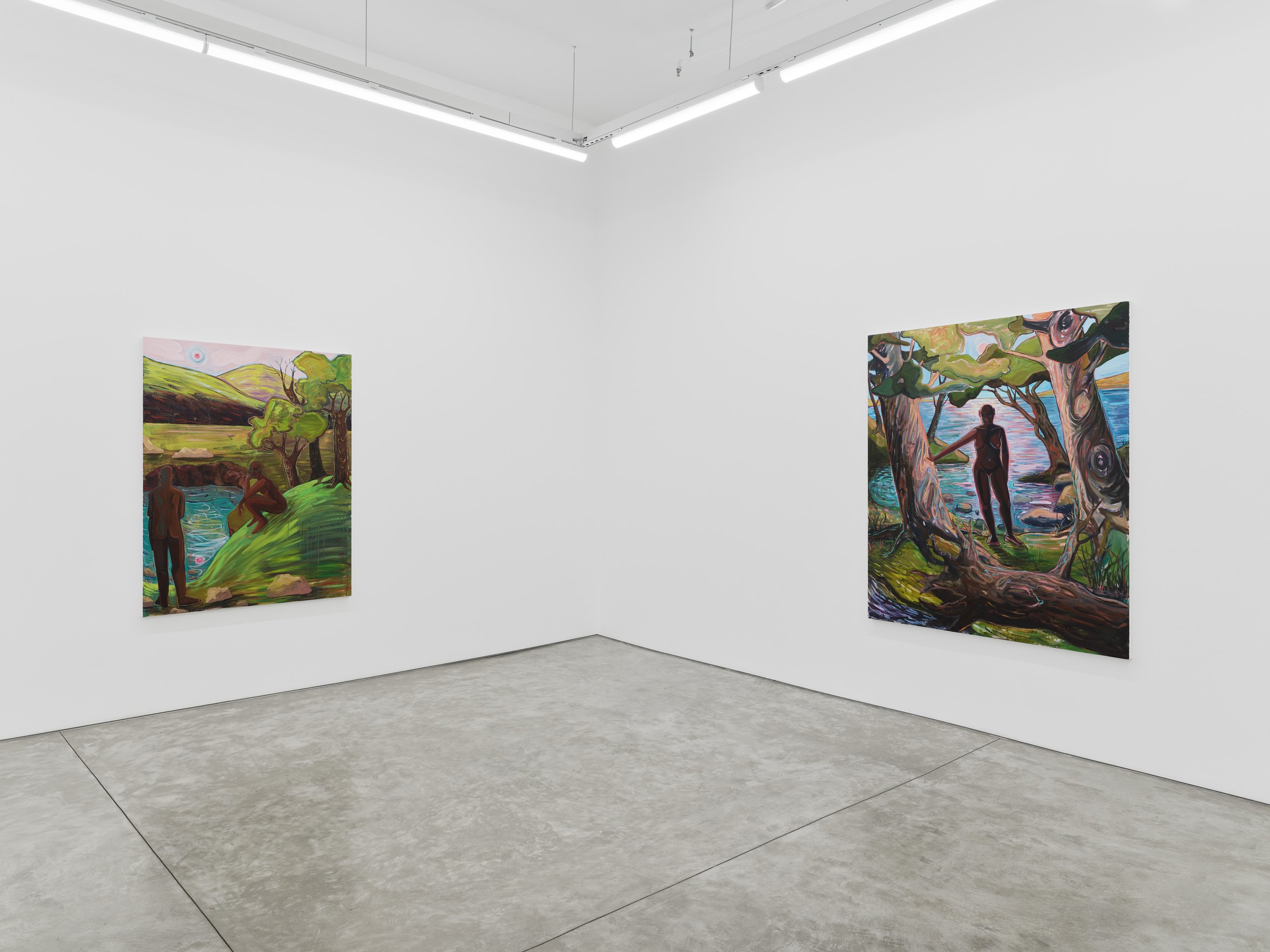



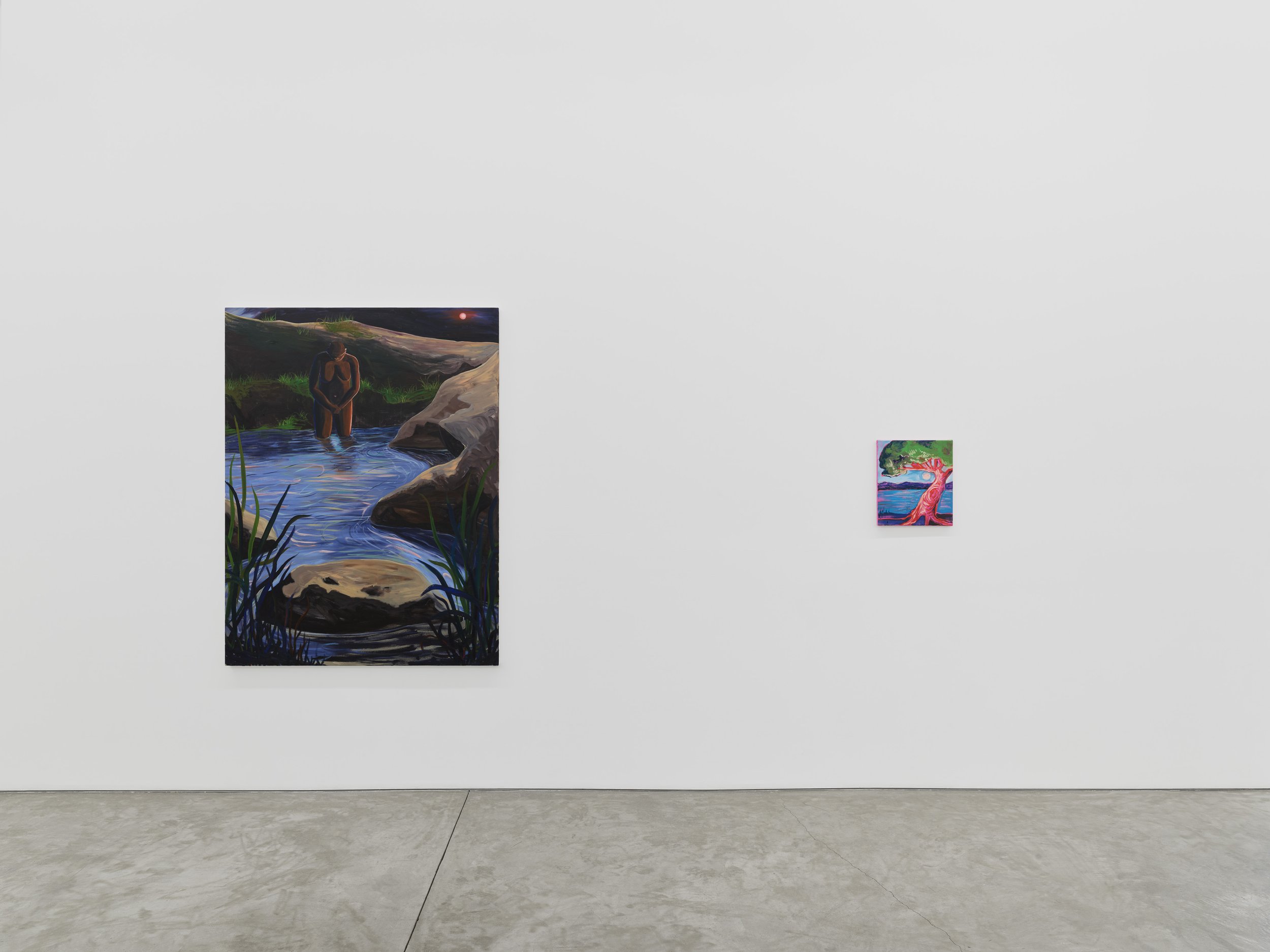
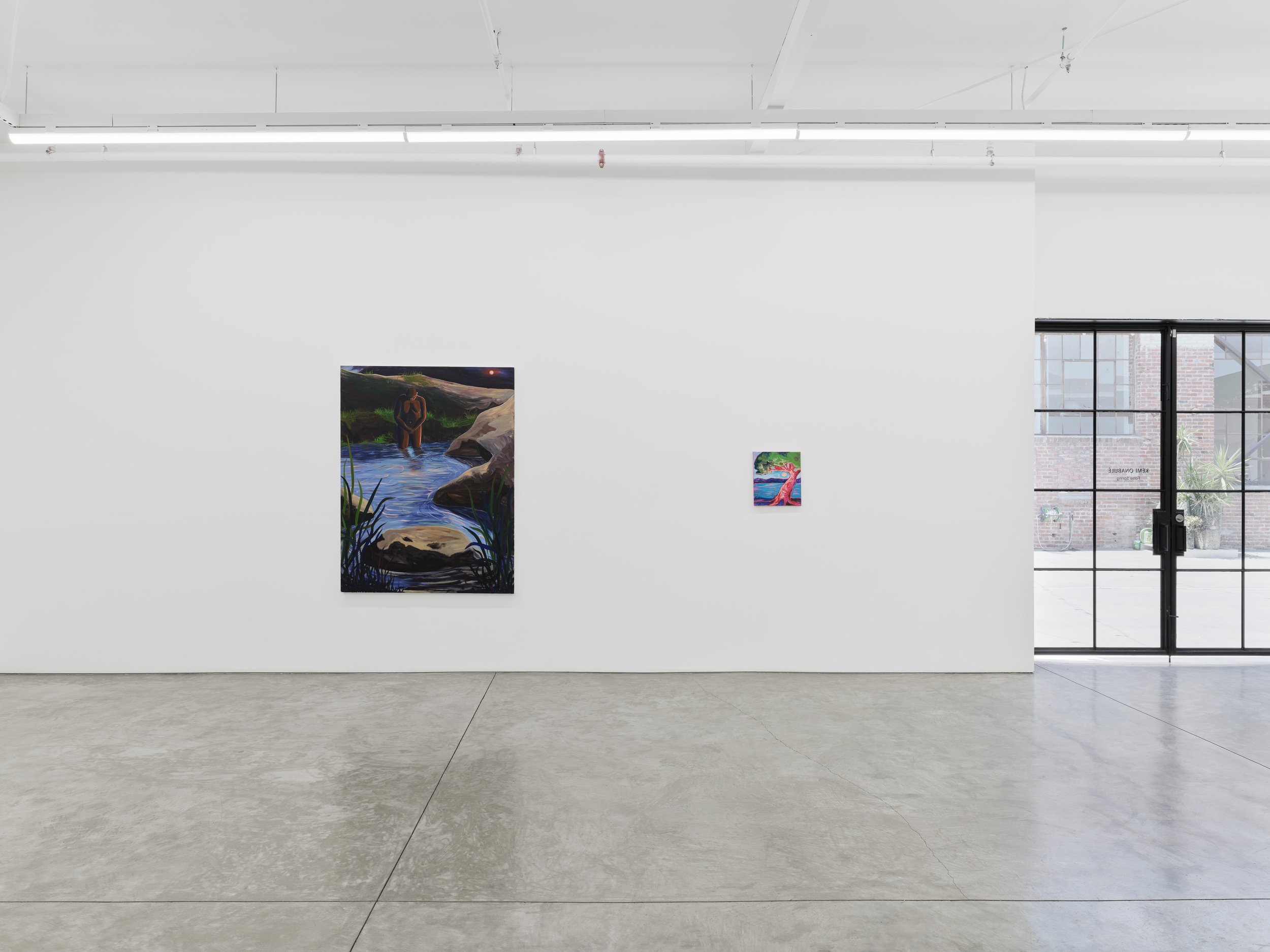

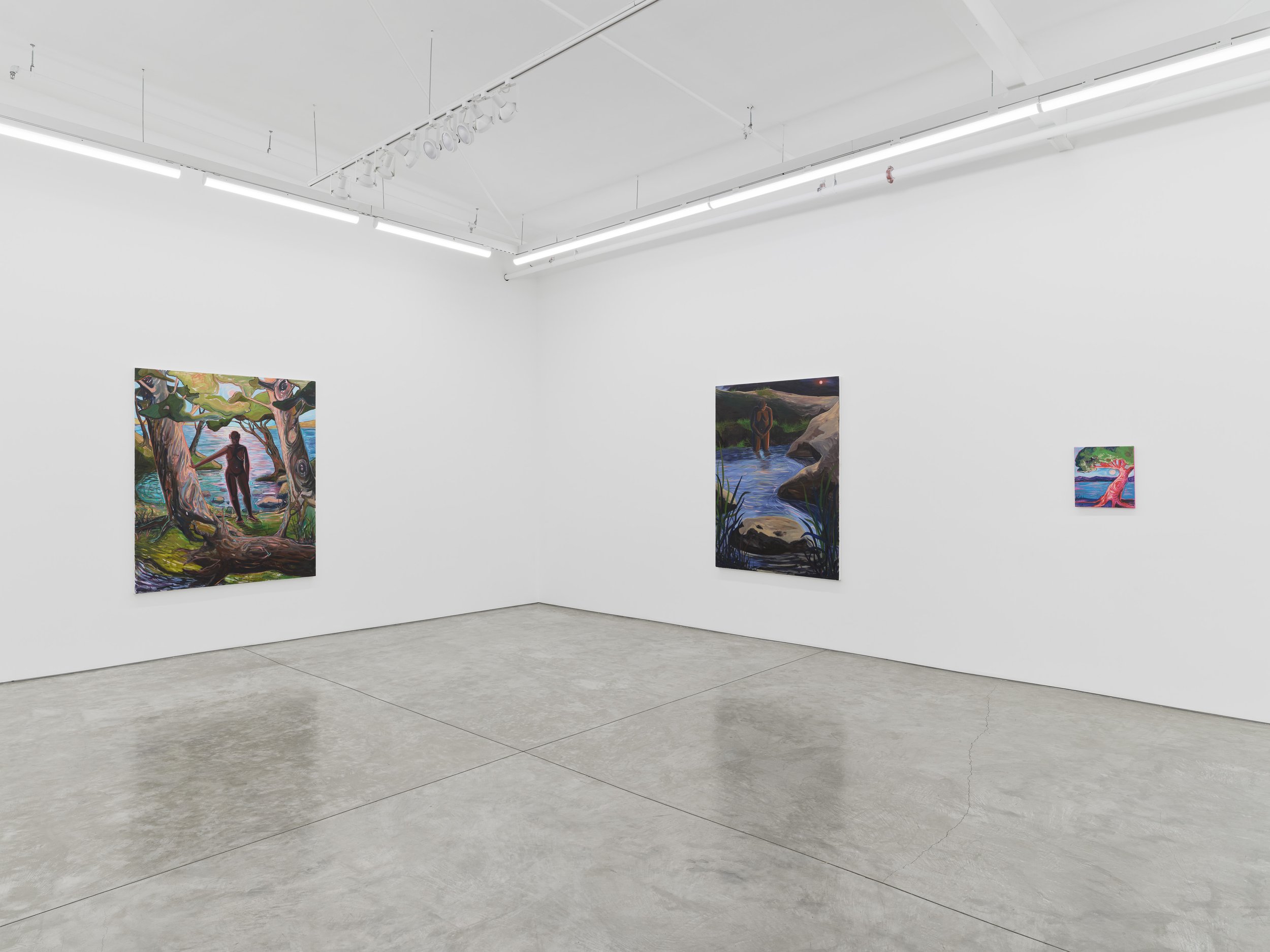


Installation View: Kemi Onabulé False Spring June 19- August 24, 2024, Night Gallery EAST Photography courtesy the artist and Night Gallery, Los Angeles
Onabulé’s figures wade or gaze into eddying waters as volumes of green streaks and drips suggest the dynamic lands, grasses, and tropical settings around them. Lost Love and The Wish to Be Forgiven (both 2024) feature pairs of figures who reveal or conceal themselves in bright or twilit clearings. In the title painting, False Spring (2024), no figure appears. Instead, bare tree limbs arc across a desolate landscape that evokes the wreckage of California forest fires. In the distance, pastel waters reflect a luminous moon. Throughout these paintings, the artist considers what it means to have a witness, whether human or celestial.
Disparate art histories and mythologies inform these scenes. Onabulé refutes Paul Gaugin’s paternalistic visions of Tahiti while embracing the surreal simplicities of Noah Davis. Her dual heritage also shapes the complex relationship between her figures and their surroundings Nigerian tradition centers and anthropomorphizes nature; forests have eyes and the land has a consciousness of its own. Greek tradition, on the other hand, focuses on humans while blurring the boundaries of form: Gods turn themselves into animals, while Narcissus, so seduced by his own aquatic reflection that he falls into a pool, ultimately sprouts into a flower.
Installation View: Kemi Onabulé False Spring June 19- August 24, 2024, Night Gallery EAST Photography courtesy the artist and Night Gallery, Los Angeles
Translation and transformation are similarly key to Onabulé’s process. The artist begins each work with drawing. She uses pencil, watercolor, oil stick, and oil paint on paper to solidify her image and determine the ideal texture of her brushstrokes. She then uses oil paint to recreate these energies and heterogeneous marks on canvas. The artist scratches back into wet oil to give further texture to her surfaces.
Through such contrivance, invention, and engagement with the fraught past, Onabulé discovers new forms and ways of working that are both generative and true. Trees fall, and darkness descends around her figures. A green, new world springs up around them. No matter the setting, they remain sturdy and strong.
Kemi Onabulé (b. 1995, London, United Kingdom) has had solo exhibitions at Sim Smith, London, United Kingdom. This is Onabulé’s first solo exhibition in the US. She has participated in group exhibitions at Capsule, Venice, Italy; Night Gallery, Los Angeles, CA; Bode Projects, Berlin, Germany; and numerous galleries in the United Kingdom. In 2021, she was shortlisted for the prestigious Jackson's Painting Prize. The artist lives and works in London and is represented by Sim Smith.
For more information about Kemi's artwork, please visit her site, and for more information about current and future exhibitions, please visit their site here.
Donald Judd :Wall Works
Donald Judd, Basel, Installation View, 2024 © Judd Foundation/Artists Rights Society (ARS), New York Photo: Maris Hutchinson Courtesy Gagosian
Material, space, and color are the main aspects of visual art. Everyone knows that there is material that can be picked up and sold, but no one sees space and color.
—Donald Judd
BASEL,—Gagosian is pleased to announce an exhibition of works by Donald Judd opened at the Basel gallery on June 10. Ten single-unit, wall-mounted works made by the artist in Switzerland between 1987 and 1991 will be on view. Each work measures 25 × 100 × 25 centimeters (approximately 10 × 39 × 10 inches) and is fabricated in Judd’s signature mediums: anodized aluminum and plexiglass sheets in a range of opacities and colors, from amber and chartreuse to black.
DONALD JUDD Untitled, 1991 Clear and turquoise anodized aluminum with blue over red plexiglass 9 7/8 x 39 3/8 x 9 7/8 inches (25 x 100 x 25 cm) © Judd Foundation/Artists Rights Society (ARS), New York Photo: Maris Hutchinson Courtesy Gagosian
Judd’s radical art making and thinking helped shape the look of the late twentieth century and continues to influence artists, architects, and designers worldwide. He has exercised a transformative impact on the ways in which both art objects and practical designs are produced, exhibited, encountered, and used. Through his globally recognized visual work and his incisive critical and theoretical writing, Judd introduced an art that exists on its own determinedly physical terms, removed from notions of metaphor and illusion and about the here and now with no recourse to past narratives. Individually, each of his works delineates created interior space and the exterior space it occupies; there are no identical works within the group.
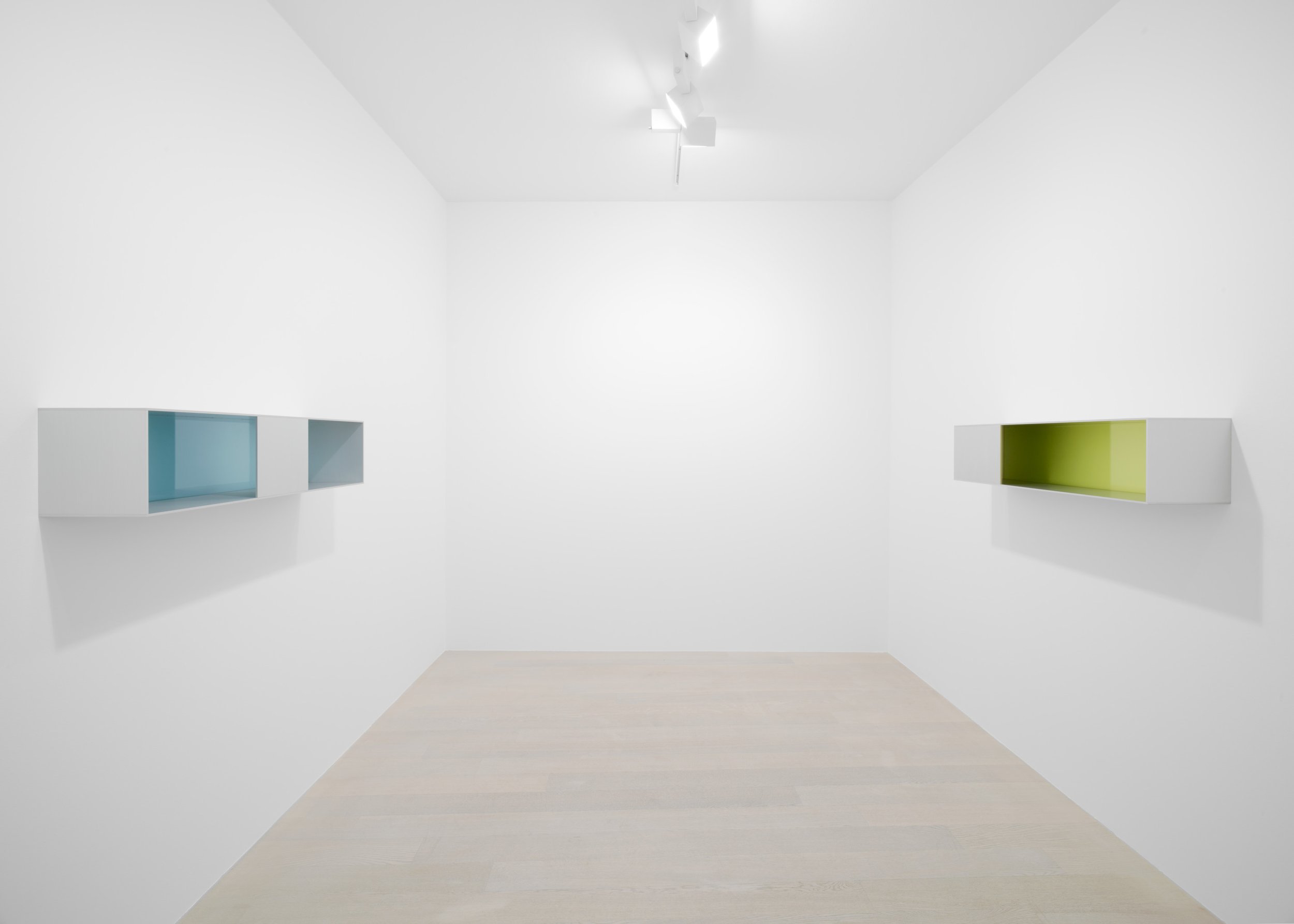

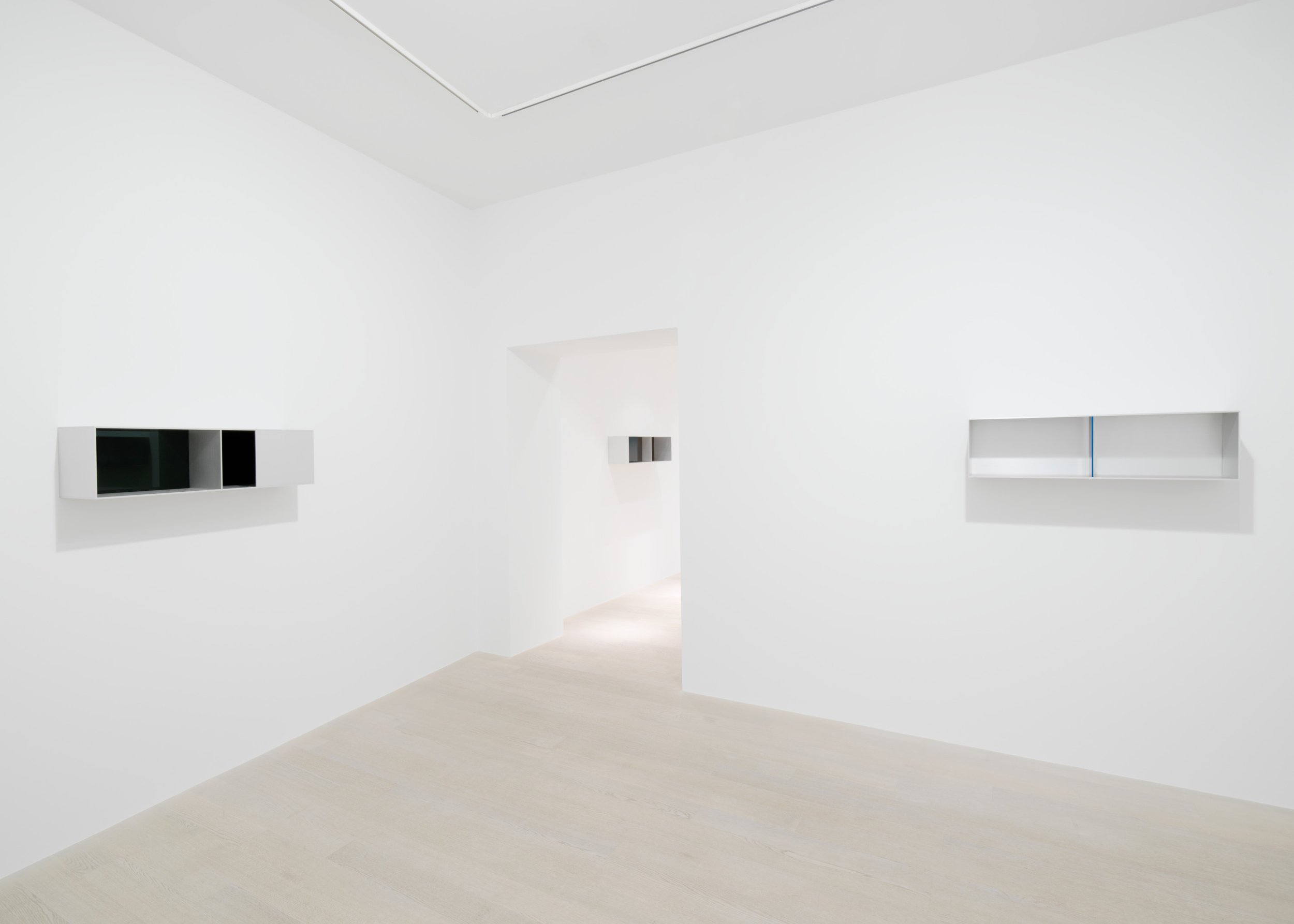

Donald Judd, Basel, Installation View, 2024 © Judd Foundation/Artists Rights Society (ARS), New York Photo: Maris Hutchinson Courtesy Gagosian
These precisely constructed works are defined by Judd’s interest in materials and color. Non- referential and self-contained, they emphasize the intrinsic qualities of their components and the relationships between part and whole. The uniform proportionality of their exteriors exists in relation to their interior divisions, as the matte sheen of aluminum contrasts with the glossy or translucent plexiglass sheets positioned on the works’ vertical surfaces closest to the wall. The compositions are bisected by aluminum sheets, with some works partitioned by aluminum planes on their front- facing surfaces. Orchestrating subtle and dramatic interplays of light, shadow, and color, the pieces investigate space, color, and existence—for Judd, the main concerns of art.
DONALD JUDD Untitled, 1991 Clear anodized aluminum with amber over yellow plexiglass 9 7/8 x 39 3/8 x 9 7/8 inches (25 x 100 x 25 cm) © Judd Foundation/Artists Rights Society (ARS), New York Photo: Maris Hutchinson Courtesy Gagosian
Judd spent significant time in Switzerland, and key exhibitions of his work were mounted there from 1969, including at Kunstmuseum Basel in 1976 and 2004. In 1987, he established Eichholteren, a home and studio on a lakeside site near Küssnacht-am-Rigi, remodeling its architecture through 1993.
DONALD JUDD Untitled, 1991, detail Clear and turquoise anodized aluminum 9 7/8 x 39 3/8 x 9 7/8 inches (25 x 100 x 25 cm) © Judd Foundation/Artists Rights Society (ARS), New York Photo: Maris Hutchinson Courtesy Gagosian
The exhibition in Basel coincides with the gallery’s participation in Art Basel (June 12–16), which includes the presentation of a historic large-scale work by Judd from 1970 in the Unlimited sector for monumental artworks. The untitled installation consists of five-foot-high galvanized iron panels that stand end to end on the floor to form a continuous band exactly eight inches from the surrounding walls. First shown by Leo Castelli in New York, the work’s configuration is both variable and directly related to its site, transforming the architectural space where it is installed.





Donald Judd, Basel, Installation View, 2024 © Judd Foundation/Artists Rights Society (ARS), New York Photo: Maris Hutchinson Courtesy Gagosian
Donald Judd was born in 1928 in Excelsior Springs, Missouri, and died in 1994 in New York. Collections include Kunstmuseum Basel; Kunstmuseum Bern; Museum Ludwig, Cologne, Germany; Centre Pompidou, Paris; Tate, London; Museum of Modern Art, New York; Solomon R. Guggenheim Museum, New York; National Gallery of Art, Washington, DC; San Francisco Museum of Modern Art; and Museum of Contemporary Art Tokyo. Exhibitions include the Whitney Museum of American Art, New York (1968 and 1988); Van Abbemuseum, Eindhoven, Netherlands (1970, traveled to Museum Folkwang, Essen, Germany; Kunstverein Hannover, Germany; and Whitechapel Art Gallery, London); National Gallery of Canada, Ottawa (1975); and Tate Modern, London (2004, traveled to Kunstsammlung Nordrhein Westfalen, Düsseldorf, Germany; and Kunstmuseum Basel). The Museum of Modern Art, New York, presented a major retrospective of Judd’s work in 2020–21. Judd established Judd Foundation in 1977 to preserve his art, spaces, libraries, and archives in New York and in Marfa, Texas. He founded the Chinati Foundation/La Fundación Chinati in 1986 for the permanent installation of his and his contemporaries’ large-scale works.
For more information about this exhibition and others presented by Gagosian please visit the gallery’s site here. The gallery can also be found on Pinterest, X, YouTube, Facebook, Instagram, and Artsy.
The Body as Matter: Giacometti Nauman Picasso




The Body as Matter: Giacometti Nauman Picasso, 2024, installation view Artwork © Succession Picasso/DACS, London 2024; © Succession Alberto Giacometti / DACS 2024; © 2024 Bruce Nauman / Artists Rights Society (ARS), New York and DACS Photo: Prudence Cuming Associates Ltd Courtesy Gagosian
On View from June 6, the Exhibition Is the First to Consider Sculpture by These Three Artists Together
LONDON, —Gagosian is pleased to announce The Body as Matter: Giacometti Nauman Picasso, an exhibition of sculpture by Alberto Giacometti (1901–1966), Bruce Nauman (b. 1941), and Pablo Picasso (1881–1973). Curated by Richard Calvocoressi, the exhibition is on view at the Grosvenor Hill Gallery from June 6 to July 26, 2024. The Exhibition Is the First to Consider Sculpture by These Three Artists Together
PABLO PICASSO La femme enceinte I, 1950, cast by Valsuani in 1951-53 Bronze 41 x 12 1/2 x 8 3/4 inches (104.1 x 31.8 x 22.2 cm) Edition of 3, one numbered cast and nos. 1/6 and 2/6 casting stamp "CIRE PERDUE C. VALSUANI" © Succession Picasso/DACS, London 2024 Photo: Rob McKeever Courtesy Gagosian
Radical investigations of the human body and how we perceive it characterize the distinct sculptural practices of Giacometti, Nauman, and Picasso, who are widely regarded as defining figures of their respective generations. From the modernist preoccupation with the fragmented or disintegrated body typical of Picasso’s and Giacometti’s work to the postmodern expansion of sculpture into a range of environmental and anti-monumental forms exemplified by Nauman’s, this is the first exhibition to juxtapose sculptures by these three artists. It features classic pieces by all three, including Picasso’s La femme enceinte I (1950) and Bras vertical (1961), Giacometti’s La jambe (1958) and Grande tête (1960), and Nauman’s Henry Moore Bound to Fail (1967/1970) and Model for Room with My Soul Left Out, Room That Does Not Care (1984).
PABLO PICASSO Tête de femme, 1951, cast 1955 Bronze 21 1/8 x 14 1/8 x 7 3/8 inches (53.7 x 35.9 x 18.7 cm) Edition of 4; one unnumbered cast and nos. 1/6, 2/6, and 3/6 © Succession Picasso/DACS, London 2024 Photo: Rob McKeever Courtesy Gagosian
A pioneer of Cubism best known for his paintings, drawings, and collages, Picasso produced numerous sculptures, which are among his most experimental works. He primarily sculpted in two distinct modes: modeling clay or plaster for casting into bronze, and constructing or assembling forms from discarded objects and cheap materials such as sheet metal, wood, and cardboard. In works of astonishing wit and originality, not to mention erotic suggestiveness, Picasso investigated means of manipulating mass and surface to incorporate multiple perspectives into a single head, limb, or figure.
ALBERTO GIACOMETTI Grande Tête, 1960 Patinated bronze 37 1/2 x 12 x 14 3/4 inches (95.3 x 30.4 x 36.1 cm) © Succession Alberto Giacometti / DACS 2024 Photo: Rob McKeever Courtesy Gagosian
In Paris in the 1920s Giacometti came under the influence of Surrealism, encouraging him to incorporate into his sculptures a sense of sexual violence or threat that Nauman would later take up. Giacometti’s modeled and cast sculptures from the postwar period—fragile, highly textured, and strikingly elongated—broke away from the conventions of classical sculpture to evoke instead the survivors of some human or natural catastrophe. These depictions of the fractured and vulnerable figure or of isolated body parts appear frozen in motion, prompting reflections on mortality. Focusing almost exclusively on the body, Giacometti’s paring of the figure to its bare essentials challenged tradition and paved the way for contemporary artists to consider new possibilities.
BRUCE NAUMAN Untitled, 1996 White bronze with painted steel base 55 3/8 x 12 x 12 inches (140.7 x 30.5 x 30.5 cm) Edition of 2 © 2024 Bruce Nauman / Artists Rights Society (ARS), New York and DACS Photo: Robert Vinas Jr Courtesy Sperone Westwater
Since the 1960s Nauman has pursued a varied practice that builds on Picasso’s and Giacometti’s innovations. Nauman produces work in sculpture, performance, video, and neon that confronts viewers with their own physical limitations and employs repetitive actions, linguistic play, and stark imagery to disrupt perception and thought. The artist’s invocation of corporeal presence echoes Giacometti’s, yet he visualizes the human condition through the prisms of contemporary culture and modern technology. Addressing concerns such as the effect of surveillance and the allure of instant gratification, Nauman’s works require the viewer’s physical presence and mental engagement to activate them.
Alberto Giacometti working at his studio, 1956 Photo Pierre Vauthey/Sygma/Sygma via Getty Images © Succession Alberto Giacometti DACS 2024
Giacometti, Nauman, and Picasso have all redefined sculpture—reshaping traditional mediums and pioneering new ones. Picasso’s groundbreaking move away from a naturalistic representation of the human form was extended by Giacometti, whose elongated, modeled, and cast figures draw attention to material and process, while evoking the artist’s struggle to capture a living, breathing presence in three dimensions.
Bruce Nauman in his UC Davis studio, 1965, with a fiberglass-and-polyester-resin sculpture, now destroyed. © 2024 Bruce Nauman / Artists Rights Society (ARS), New York and DACS, London. Courtesy of Sperone Westwater, NY
Nauman often uses his own body as subject, and encourages the viewer to become an involved participant. For all three artists, the space we occupy, the ways we are perceived, and our effect on others are crucial elements in their unique methods of existential inquiry.
Pablo Picasso working in his sculpture studio Le Fournas making a sculpture figure with odds and ends from his scrap heap. The finished sculpture got the name "La femme à la clé (La Taulière)" ("Woman with a key"). Le Fournas, Vallauris 1953. Photo Edward Quinn, © edwardquinn.com © Succession Picasso/DACS, London 2024
THE BODY AS MATTER: GIACOMETTI NAUMAN PICASSO
Opening reception was on Thursday, June 6, 6–8pm and opened on June 6 and will be on view until July 26, 2024 at the location 20 Grosvenor Hill, London location
For more information about this exhibition and others presented by Gagosian please visit the gallery’s site here. The gallery can also be found on Pinterest, X, YouTube, Facebook, Instagram, and Artsy.
Anselm Kiefer: Punctum
ANSELM KIEFER Punctum, 2024, installation view Artwork © Anselm Kiefer Photo: Owen Conway Courtesy Gagosian
NEW YORK,—Gagosian is pleased to announce Punctum, the first exhibition in the United States to center exclusively on Anselm Kiefer’s photography. Punctum will be on view at 976 Madison Avenue from April 25 through July 3, 2024. Photography has been an important but underrecognized aspect of Kiefer’s practice since 1968, when he began using his father’s 35mm camera. The medium underpins the evolution of the artist’s paintings and is a key component of his books. Punctum offers new perspectives on his exploration of materials and processes, and on the symbolic and expressive potentials of photography.
ANSELM KIEFER Katzensilber (White mica), 1994–2012 Solarised gelatin silver print with silver toner, in steel frame 40 3/4 x 63 1/4 inches (103.5 x 160.5 cm) © Anselm Kiefer Photo: Charles Duprat Courtesy the artist and Gagosian
The exhibition’s title refers to a concept formulated by Roland Barthes in his critical text Camera Lucida: Reflections on Photography (1980). Punctum (Latin for “puncture” or “wound”) connotes a detail of a photograph that elicits a feeling or personal impact outside those formed principally by its culturally coded subjects. As if picturing a memory of something that never happened, Kiefer’s photographs convey a comprehensive, evocative, even melancholic aura beyond conventional representations of time and place.
ANSELM KIEFER Über euren Städten wird Gras wachsen (Over Your Cities Grass Will Grow), 1988–2010 Gelatin silver print with silver toner, in steel frame 55 1/2 x 75 1/4 inches (141 x 191 cm) © Anselm Kiefer Photo: Charles Duprat Courtesy the artist and Gagosian
Returning to perennial motifs and images, the photographs reinforce the continuity of themes such as ruin and destruction, and growth and renewal, across Kiefer’s oeuvre, with subjects ranging from sunflowers and snow-covered fields to dense cityscapes. Works titled Merkaba (2010–13 and 2010–15) and Jericho (2010–15) picture the tower sculptures at La Ribaute, his former studio complex in Barjac, France—now part of his foundation, Eschaton.
Kiefer often manipulates his photographs through techniques such as solarization and the application of metals and other materials that transform them physically and metaphorically. In Osiris (1985–91), the addition of heavy, opaque lead to the photograph’s top half creates a juxtaposition between its material properties and its ethereal image, functioning as an effective metaphor for alchemy. Likewise, by applying silver toner to the printed surfaces of works such as Feldblumen (Wildflowers) and Ukraine (both 1994–2012), he blurs distinctions between the photographic and painted image.
ANSELM KIEFER Jericho, 2010–15 Solarized gelatin silver print with silver toner, in steel frame 40 3/4 x 63 1/4 x 4 inches (103.5 x 160.5 x 10 cm) © Anselm Kiefer Photo: Charles Duprat Courtesy the artist and Gagosian
Titled with a quotation from Immanuel Kant, Der gestirnte Himmel über uns und das moralische Gesetz in uns (The moral law within us, the starry heavens above us) (1969–2009) revisits an image from Kiefer’s Besetzungen (Occupations) series, a parodic travelogue in which the artist poses with a sieg heil salute at culturally charged European locations, appropriating and recontextualizing the taboo gesture to confront the historical weight of the Second World War. In the newer work, Kiefer overpaints the photograph’s top half in gouache, adding a star-filled sky that resonates with Kant’s line.
Hero und Leander (2012) is a vitrine sculpture that expresses Kiefer’s relationship with photography. It incorporates a metal bathtub of the sort he used to develop his first photographs and included in early performances, with coiled strips of photographic prints mounted on lead that unfurl from within the vessel. Its title alludes to the Greek legend of Hero, a priestess of Aphrodite who tends a lighthouse on one side of the Hellespont between Europe and Asia, and her lover, Leander, who drowns while swimming across the strait when the guiding light of Hero’s flame is extinguished.











ANSELM KIEFER Punctum, 2024, installation view Artwork © Anselm Kiefer Photo: Owen Conway Courtesy Gagosian
Punctum follows La photographie au commencement (Photography at the Beginning), the first retrospective to focus on Kiefer’s relationship with photography, which was organized by the Lille Métropole Musée d’art moderne, d’art contemporain et d’art brut (LaM) in Villeneuve-d’Ascq, France (2023–24). Angeli caduti (Fallen Angels) is on view at Fondazione Palazzo Strozzi, Florence, Italy, through July 21, 2024.
Anselm Kiefer was born in 1945 in Donaueschingen, Germany, and lives and works in France. His work is collected by museums worldwide and has been permanently installed at the Musée du Louvre (2007) and the Panthéon (2020), both in Paris. Exhibitions include Louisiana Museum of Modern Art, Humlebæk, Denmark (2010–11); Shevirat Ha-Kelim (Breaking of the Vessels), Tel Aviv Museum of Art, Israel (2011–12); Beyond Landscape, Albright-Knox Art Gallery, Buffalo, NY (2013–14); Royal Academy of Arts, London (2014); Centre Pompidou, Paris (2015–16); L’Alchimie du livre, Bibliothèque nationale de France, Paris (2015–16); The Woodcuts, Albertina, Vienna (2016); Pour Paul Celan, Grand Palais Éphémère, Paris (2021); and Questi scritti, quando verranno bruciati, daranno finalmente un po’ di luce (Andrea Emo), Palazzo Ducale, Venice (2022). In 2017, he was awarded the J. Paul Getty Medal for his contribution to the arts.
Anselm Kiefer’s exhibition Punctum opened on April 25 and will be on view until July 3, 2024, at the 976 Madison Avenue, New York gallery.
For more information about this exhibition and others presented by Gagosian please visit the gallery’s site here. The gallery can also be found on Pinterest, X, YouTube, Facebook, Instagram, and Artsy.




